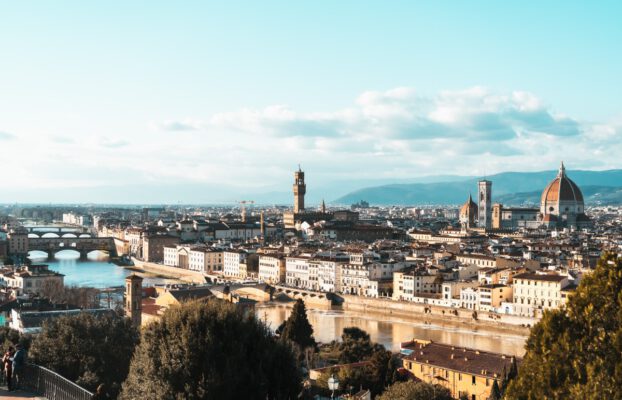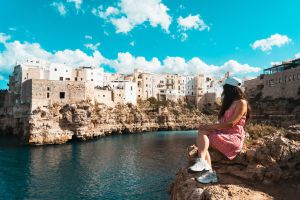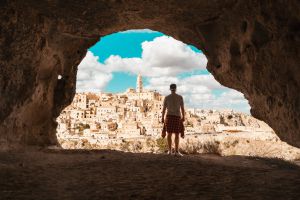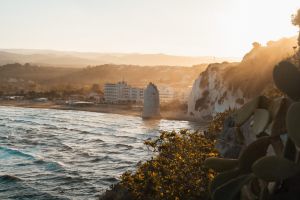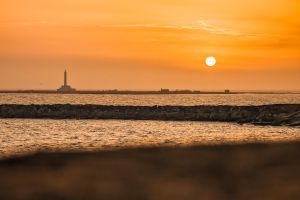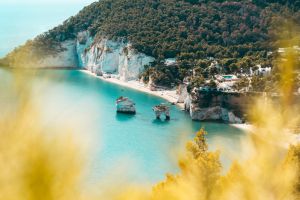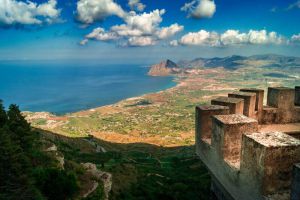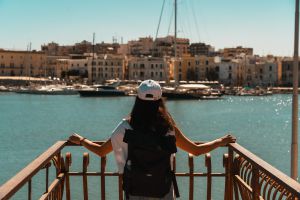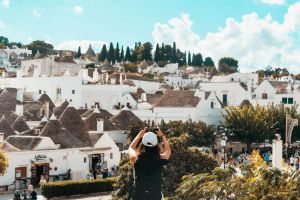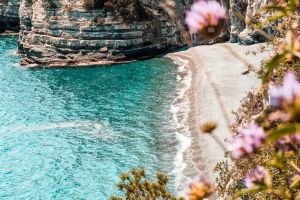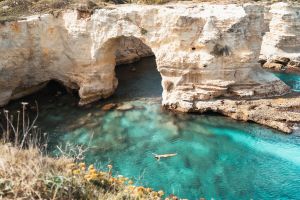Florence is a truly fascinating, historic city full of art, culture and architecture, especially from the Renaissance period. Some of the most famous painters, sculptors and artists of mankind were active here and you can still feel this atmosphere today. Many of their works are on display in the city’s fantastic museums. But there is so much to see and visit that the choice can be overwhelming. In this article, I’ll tell you which Florence sights you should definitely see on your first visit and give you tips on travel times, accommodation and admission tickets.
As you stroll through the streets of Florence, you will feel the historical significance at almost every corner. Antique stores with old furniture, ornate vases and paintings are everywhere. Many buildings look as if they have come straight out of the Renaissance. Then there are the many world-renowned museums.
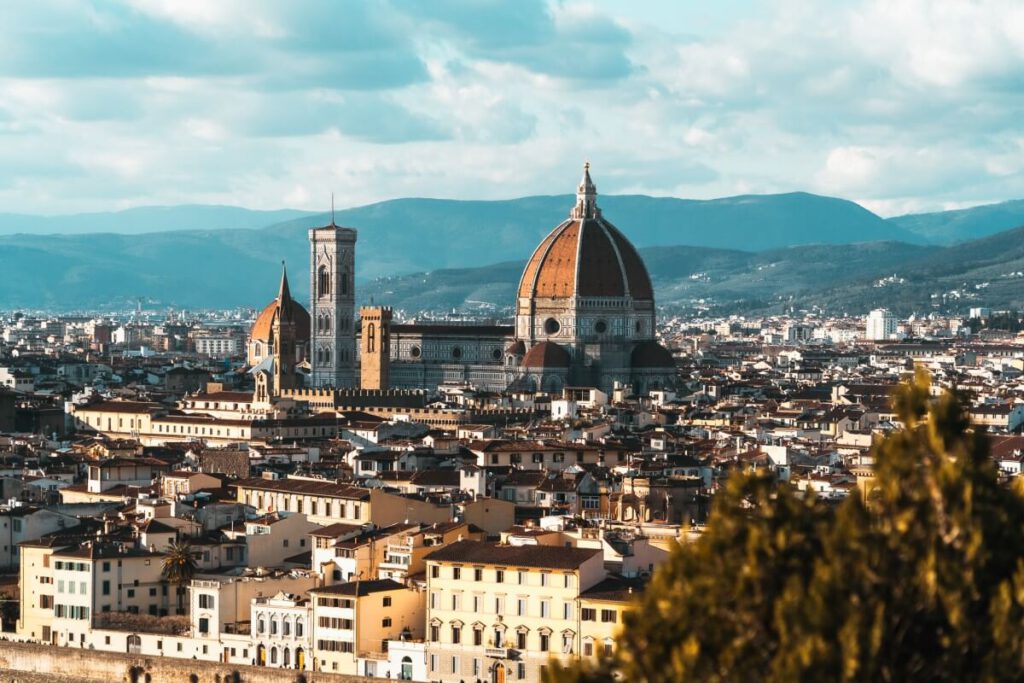
Florence is particularly well known for the famous painter Sandro Botticelli, whose works have had a lasting impact on art history. You can admire many of his works, as well as those of other world-famous artists, in the city’s countless museums.
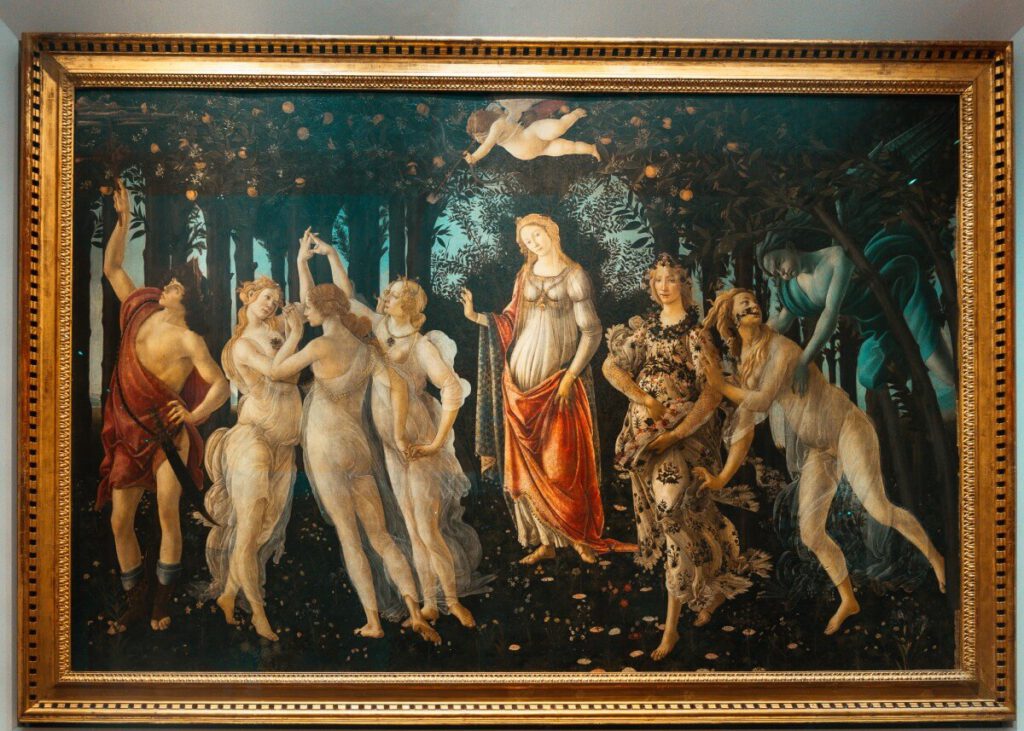
Florence is also the birthplace of Dante Alighieri, one of Italy’s most important poets and philosophers. His most famous work is “The Divine Comedy”, which he wrote between 1307 and 1321. Not to be forgotten: Florence was once the center of power of the Medici, an influential and wealthy family that ruled the city from the 15th century until 1737 and contributed significantly to its cultural heyday.
A great advantage of Florence is the compact location of its main attractions in the historic center. You can easily explore everything on foot, and the old town offers numerous charming hotels that are ideal for a city trip.
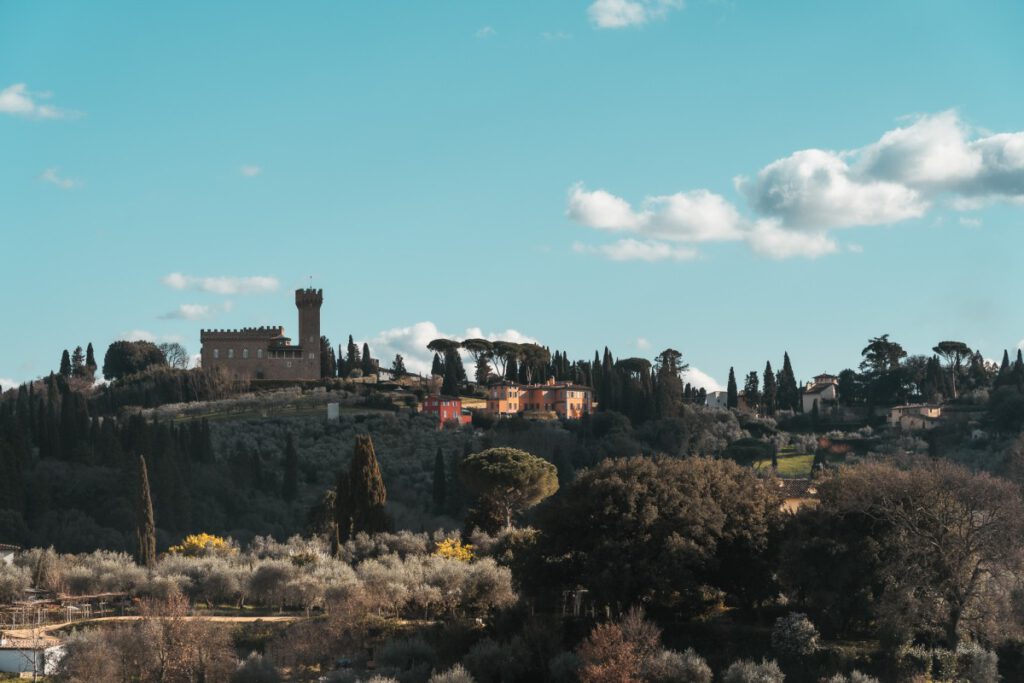
Art lovers and Renaissance nerds will probably love Florence so much that they won’t be able to stop satisfying their hunger for Italy’s cultural treasures in the city’s countless museums. But there are limits for “normal” tourists. The abundance of art, architecture and museums can be truly overwhelming. After a while, the impressions become blurred and many things seem similar.
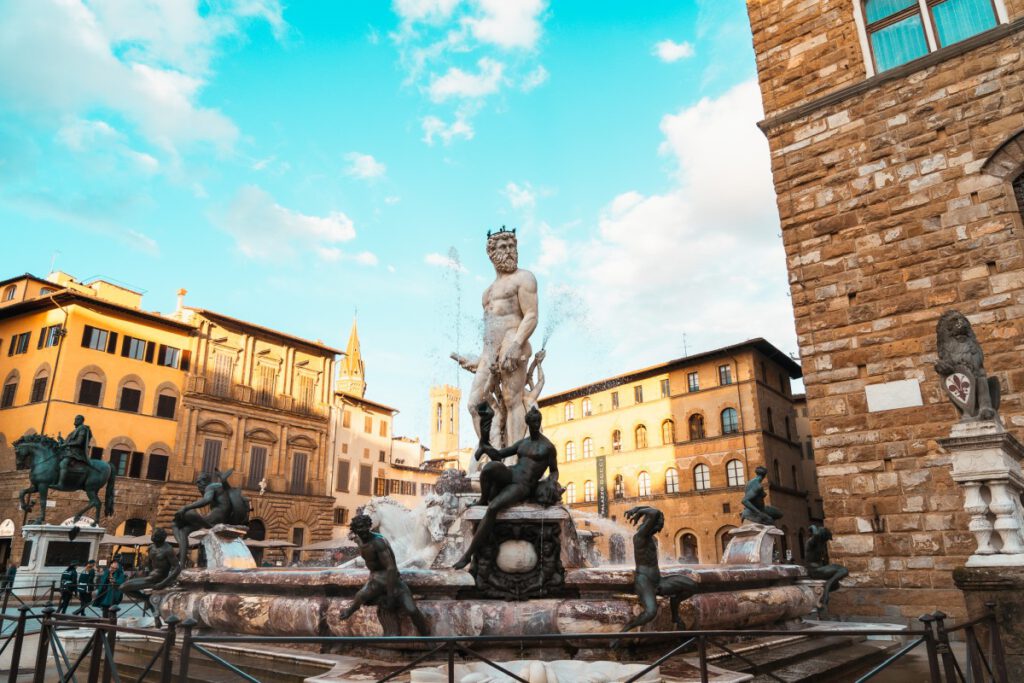
To avoid this, in this article you will find the absolute must-dos that you should see even if you are an art buff – but also enough variety to take you out of the Italian Renaissance and into modern Florence. Because that is also worth discovering.
You can also find all the Florence sights from this article here on the map:
How much time for Florence?
To be able to see the highlights of the city from this article and then also have some time for shopping, spontaneously getting lost in the alleyways of the old town and a visit or two to a restaurant for dinner or a cocktail bar, I recommend 4 days with 3 nights.
Florence in one day?
Not everyone wants to or can stay longer in Florence. The good news is that Florence is also worth visiting for just one day. But of course you will have to prioritize which of the sights you visit.
TL;DR: The 3 absolute highlights that I would definitely visit even with admission if I only had a whole day in Florence are the following:
- Galleria dell’Accademia (1 hour)
- Florence Cathedral with the Bruneschelli Dome (2-3 hours)
- The Uffizi Gallery (2-3 hours)
A good idea for Florence in one day are hop-on hop-off tickets or guided tours through the city. You can usually see most of the city in just a few hours and collect enough stories and photos to tell your friends and family back home. There are several great options:
- Guided tour of the city center, the Accademia and the Uffizi Gallery (4 hours)
- Guided walking tour Guided walking tour (1.5 hours)
- Hop-On/Hop-Off bus tour: 24-, 48- or 72-hour ticket
- Street food tour with wine (2.5 hours)
When to Florence?
Florence is a perfect winter destination for me. I was there myself in February. Although it rains from time to time and the temperatures are not yet as high, it is usually much warmer than in Germany and there is a lot to do here, even if it rains. You can visit the museums in particular regardless of the weather.
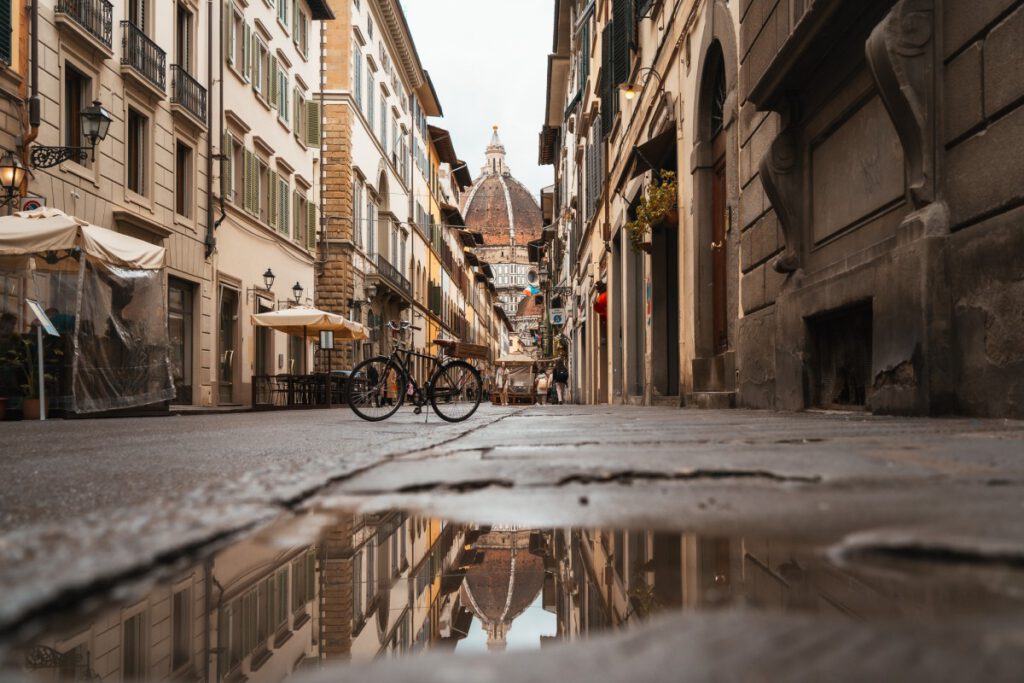
In my opinion, you will also have a better experience if you travel to Florence outside of the main season, as you won’t have to queue for ages and fight for the best spots with other tourists. In summer, when everyone is flocking to Florence, it can be quite unpleasant.
I would even recommend coming to Florence during the week and avoiding the weekend if flights allow. With the exception of Mondays, when many sights are closed, it is much more relaxed to get to the cathedral, the Uffizi and other popular attractions on weekdays. Spontaneous visits are then more possible than at the weekend, when almost everyone is traveling.
The best accommodations in Florence
It’s best to look for accommodation somewhere near the historic center. It doesn’t have to be right in the middle, on the outskirts is also fine. It’s far enough away from all the hustle and bustle, but still close enough to reach everything on foot without any problems.
The Dedo Boutique Hotel is just a 5-minute walk from Florence train station. This is perfect if you are coming from the airport by train and can then check in directly at the hotel to drop off your luggage. The rooms are cozy and there is an extensive breakfast every morning.
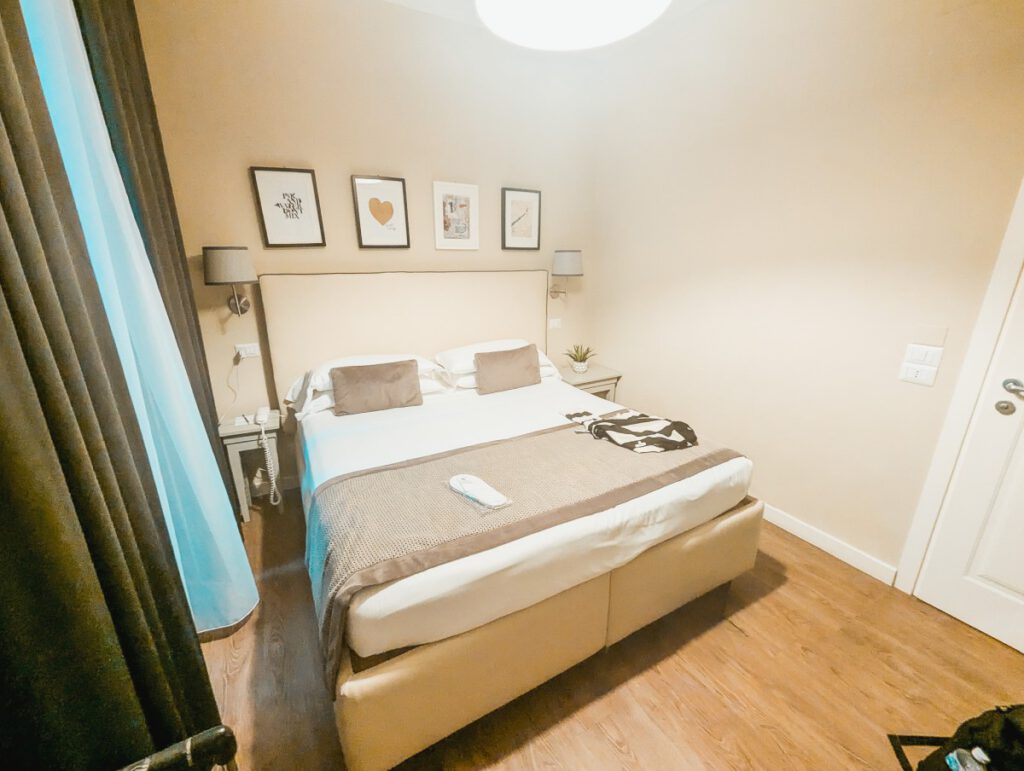
The special feature of the 25hours Florence Piazzo San Paolino is the interior design inspired by Dante’s Divine Comedy and the garden in the hotel’s inner courtyard, where guests can also enjoy breakfast. The hotel also has its own movie theater.
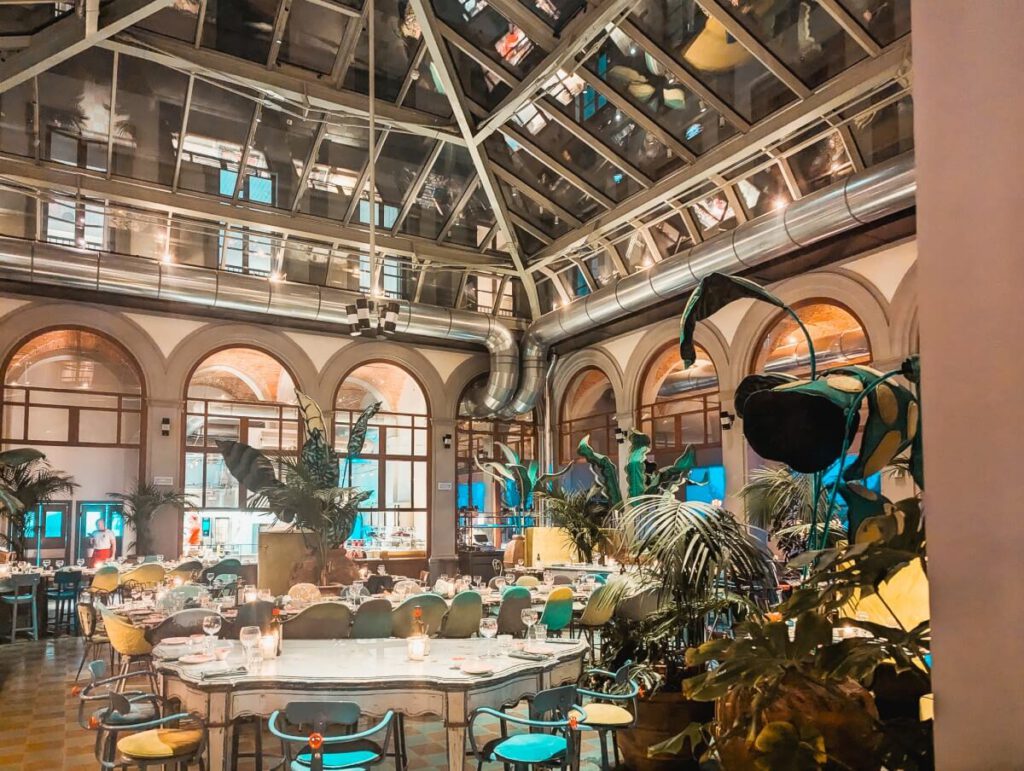
If you like it really luxurious, then check out the Four Seasons Hotel Firenze. Admittedly, it’s not exactly cheap, but it also offers a two-storey spa, a Michelin-starred restaurant and is located right next to the botanical gardens of the Giardino della Gherardesca.
The Brunelleschi Hotel offers accommodation with a historical ambience, as it is located in a restored Byzantine tower and a medieval church with a view of Florence Cathedral.
You should also note that there is a tourist tax (city tax) of €6 per person per day in Florence, which you usually have to pay at the end when you check out of your hotel.
Important tips on admission tickets and opening hours
When planning your visit, you should bear in mind that most museums are not open all week. Monday in particular is a day off at many sights.
You should also get tickets for almost all museums in advance to avoid the risk of not being able to get in or having to queue for hours.
You don’t have to do all of this before your vacation, but especially in the peak travel season, the earlier you book, the more likely it is that not everything is already fully booked. In the low season, the ticket situation is a little more relaxed.
There are basically 3 options for getting tickets:
- Without reservation on site
- With reservation from the official online ticket store
- Skip the Line Tickets
1: Without reservation on site
I don’t recommend visiting any of the main attractions without a reservation. Even outside the main season, I saw huge queues at the most popular museums. This is because often only a certain number of visitors are allowed in at any one time. And those with pre-paid tickets naturally have priority.
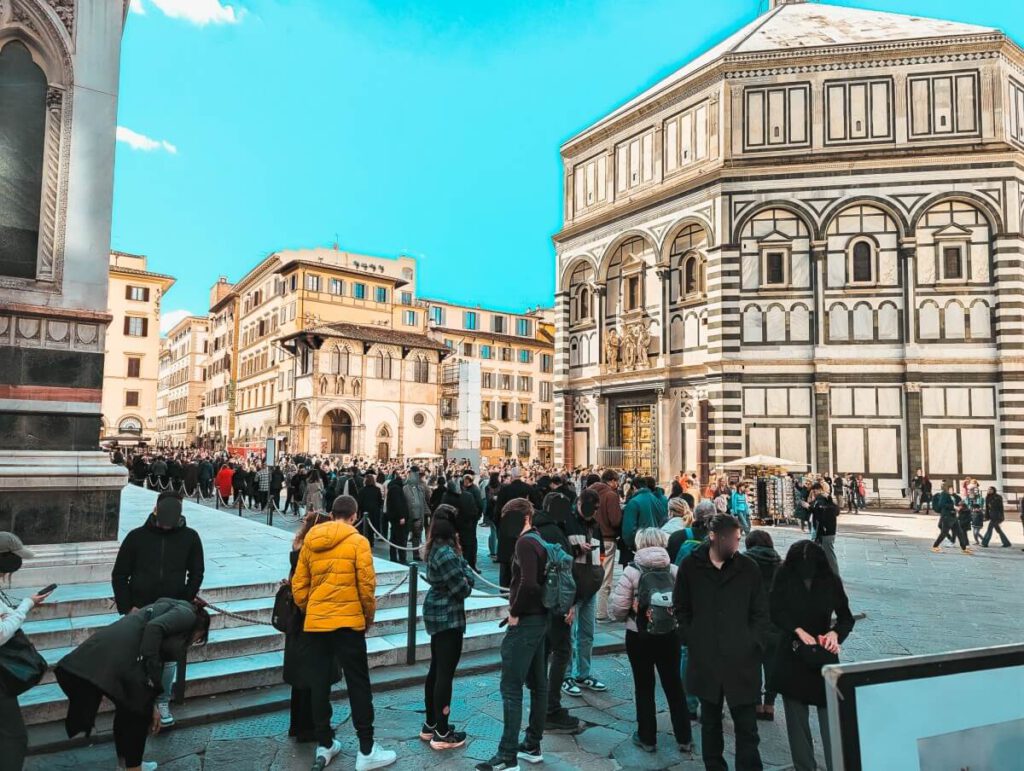
2: With reservation from the official online ticket store
You should therefore order a ticket online in advance for pretty much all sights. Otherwise you could face long queues, especially in the peak travel season. In the individual sights here in the article, I always show you the link where you can book online.
You have to choose an admission time. This means you have to plan the day before when you want to go where. Outside the main season, however, I was able to book times for the same day. However, depending on how busy it is, everything may be fully booked by then.
There are usually signs in front of the entrance with the admission times on them, where you have to queue according to your ticket. You will usually have to wait a little longer there too, as many sights still have baggage checks at the entrance. You often also have the option to pick up additional audio guides at the entrance for an extra charge.
3: Skip the Line tickets
With Skip the Line tickets, you can go straight to the entrance and the audioguide is usually included. However, you also have to choose a time here. These tickets are a little more expensive and, in my opinion, only a good option if you can’t get any more free seats via the official ticket stores.
In this article, I will give you all the links to the online stores and skip the line tickets for the sights mentioned.
1. Duomo of Florence
Florence Cathedral (Santa Maria del Fiore) is an architectural masterpiece of the Renaissance and is considered a symbol of the city’s cultural prosperity. Filippo Brunelleschi’s dome is particularly famous. With an inner diameter of over 41 meters, it is considered the largest self-supporting brick dome in the world and was constructed without scaffolding.
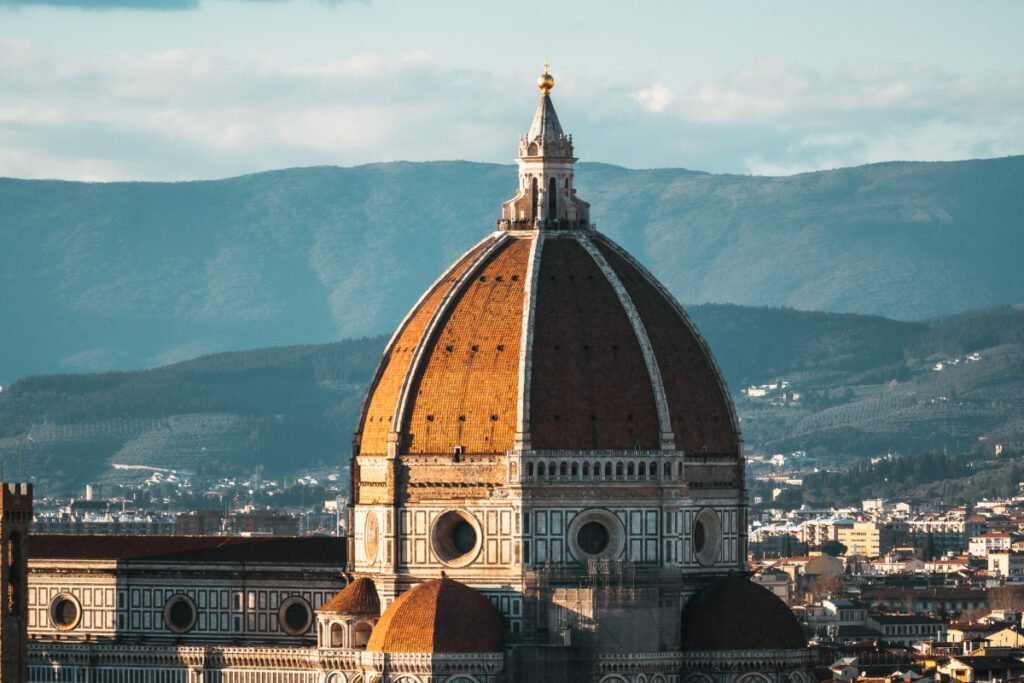
Florence Cathedral is the fourth largest church in Europe and consists of several parts:
- the cathedral with its 153-meter-long nave and striking Bruneschelli dome
- the crypt of Santa Reparata, an excavation site under the cathedral with the tomb of Bruneschelli
- the Baptistery of San Giovanni with its impressive Byzantine-inspired gold mosaics inside
- the Giotto Tower, decorated with 56 reliefs and 16 statues
- the Museo dell’Opera del Duomo, a museum in which many original art treasures of the cathedral are exhibited
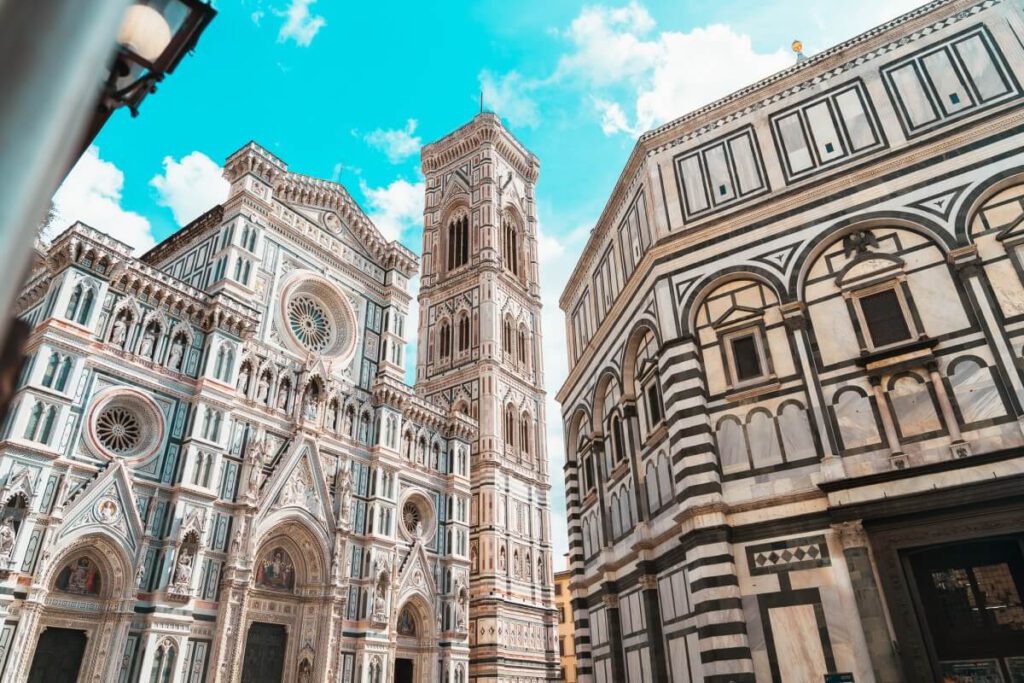
From a distance, the façade of the cathedral and its buildings almost looks like a complex graphic line drawing. Up close, however, you can see that it is made of the finest marble in various colors. The façade structure with geometric patterns and linear structures creates an impressive visual depth effect. The horizontal and vertical division of the surfaces using stripes, rosettes and niches makes the contours stand out particularly clearly.
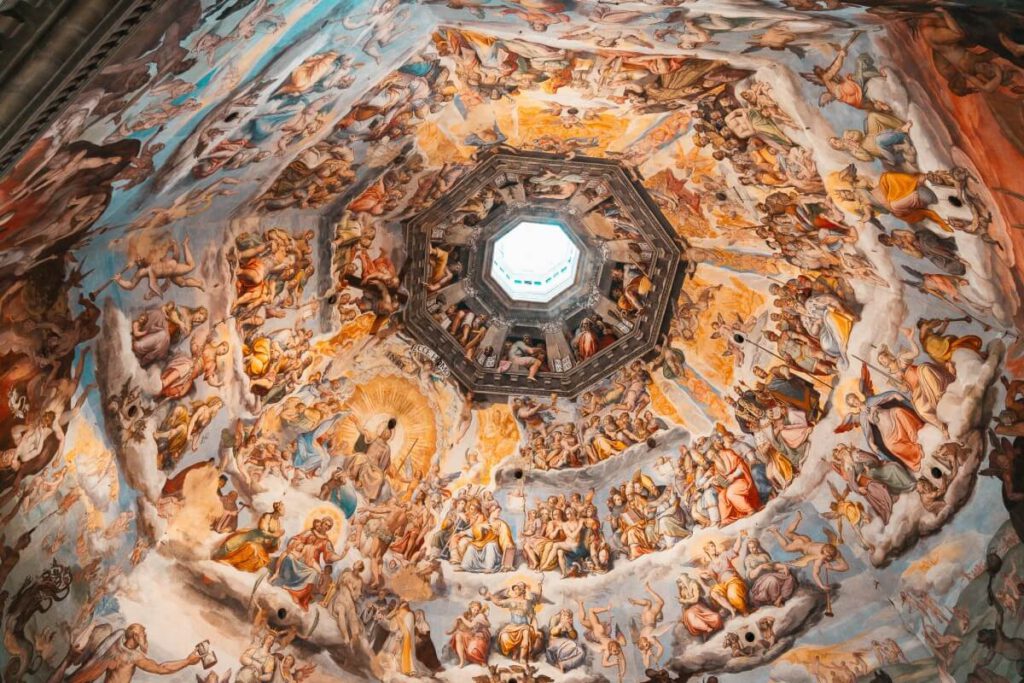
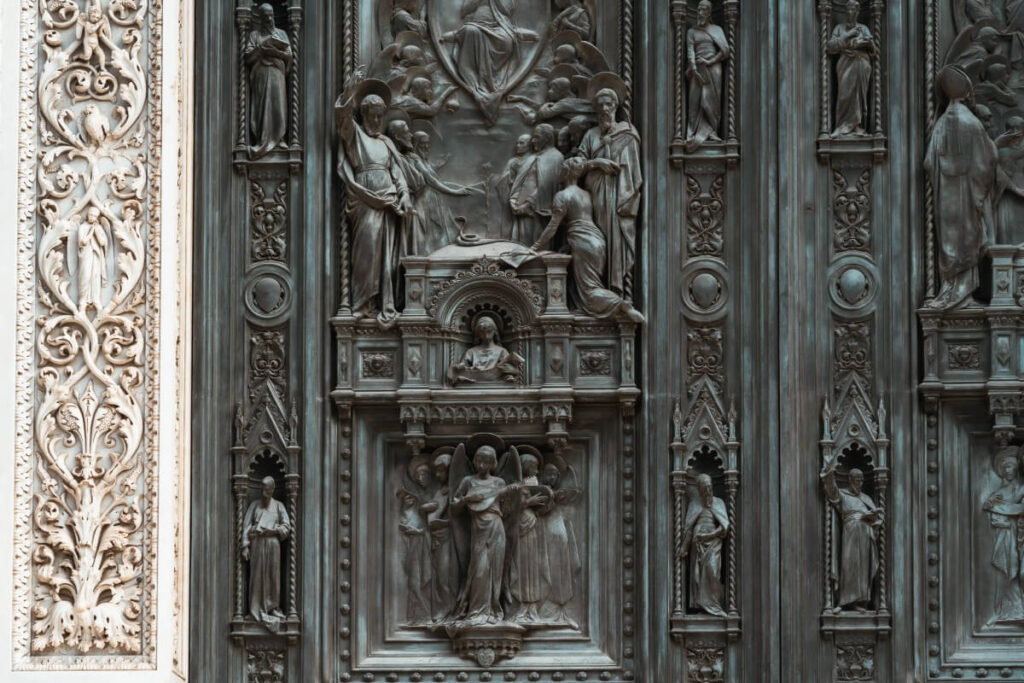
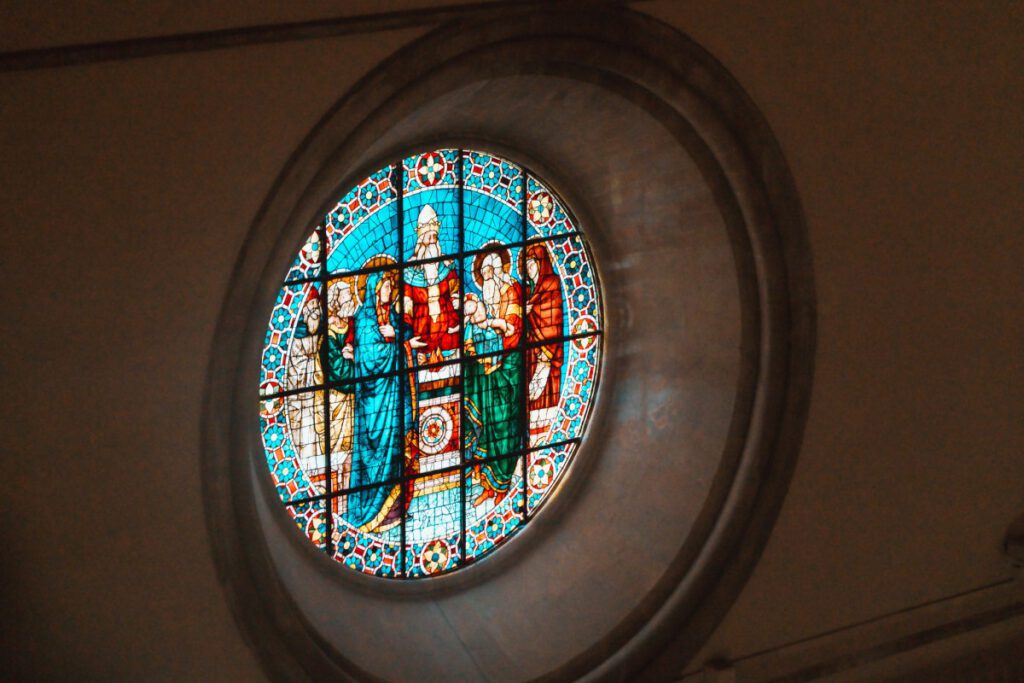
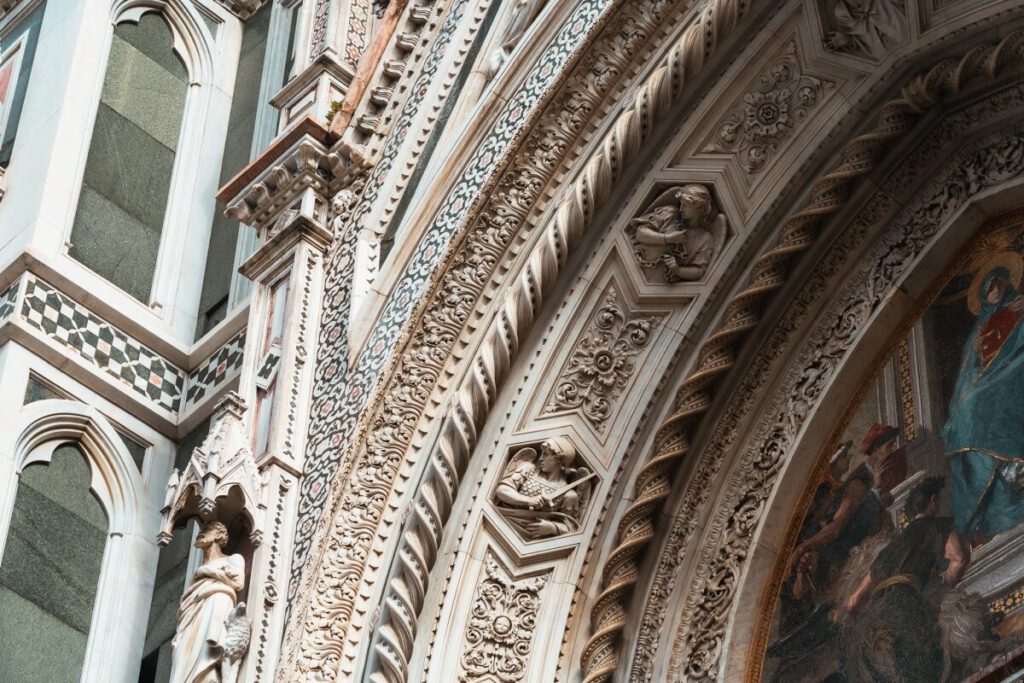
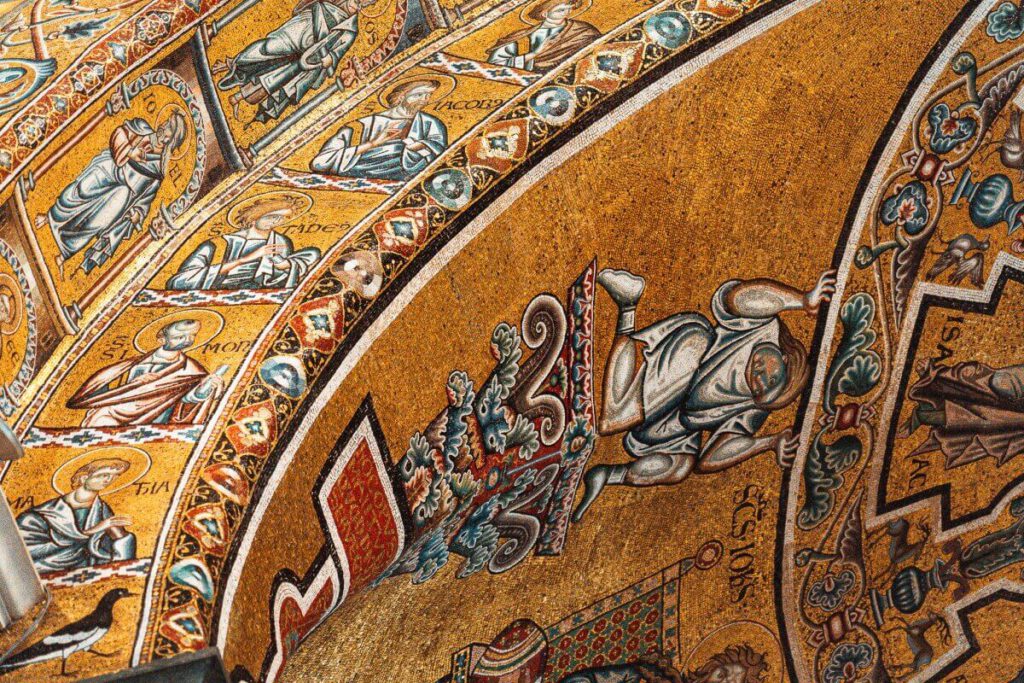
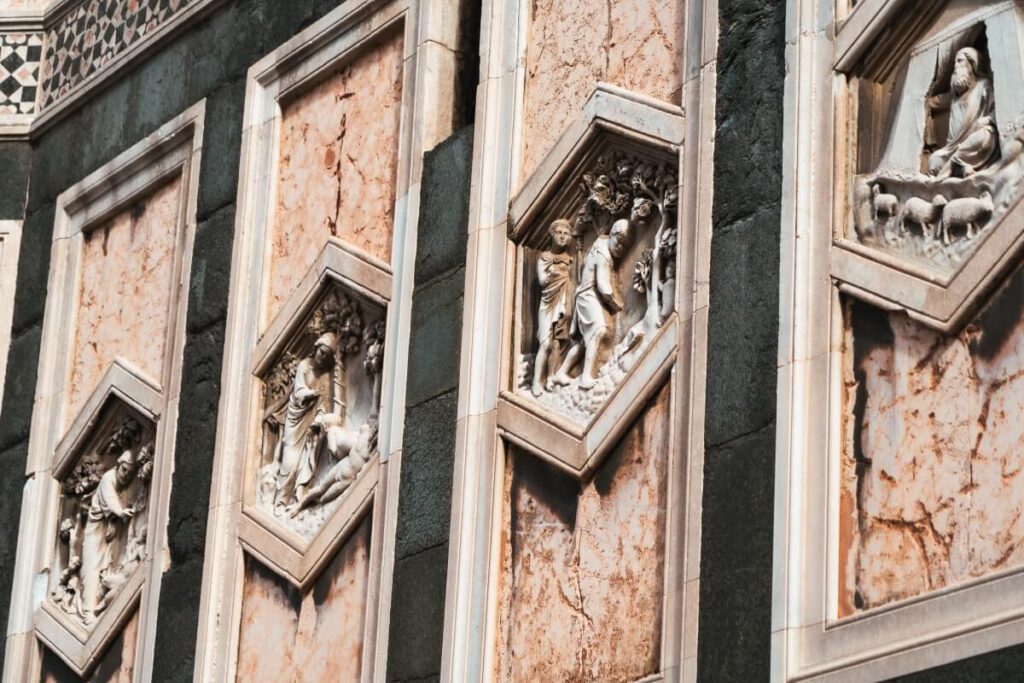
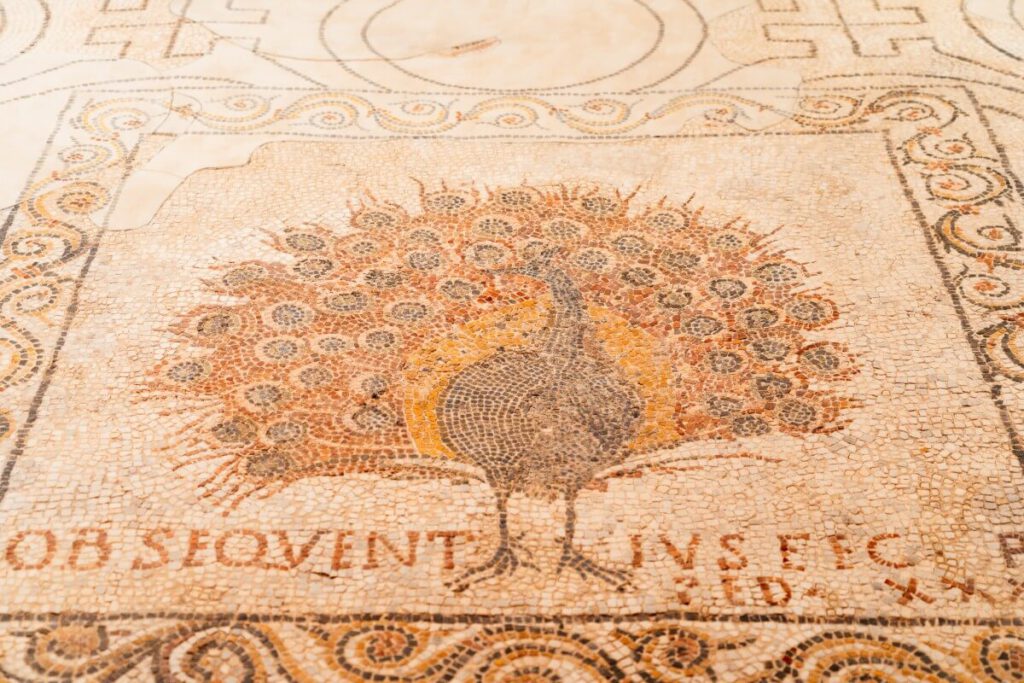
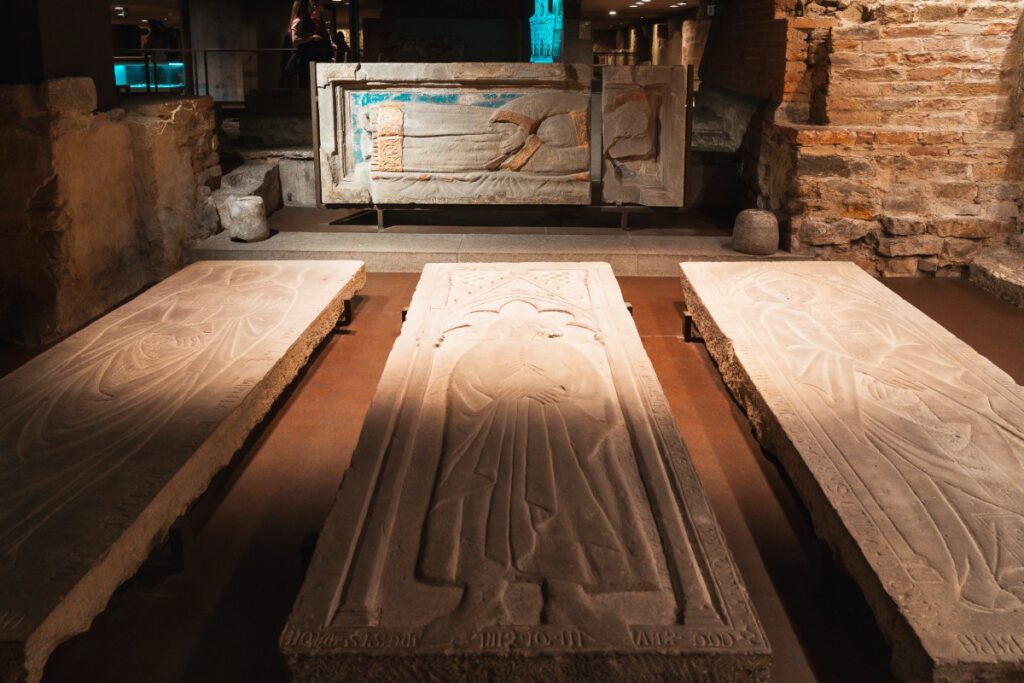
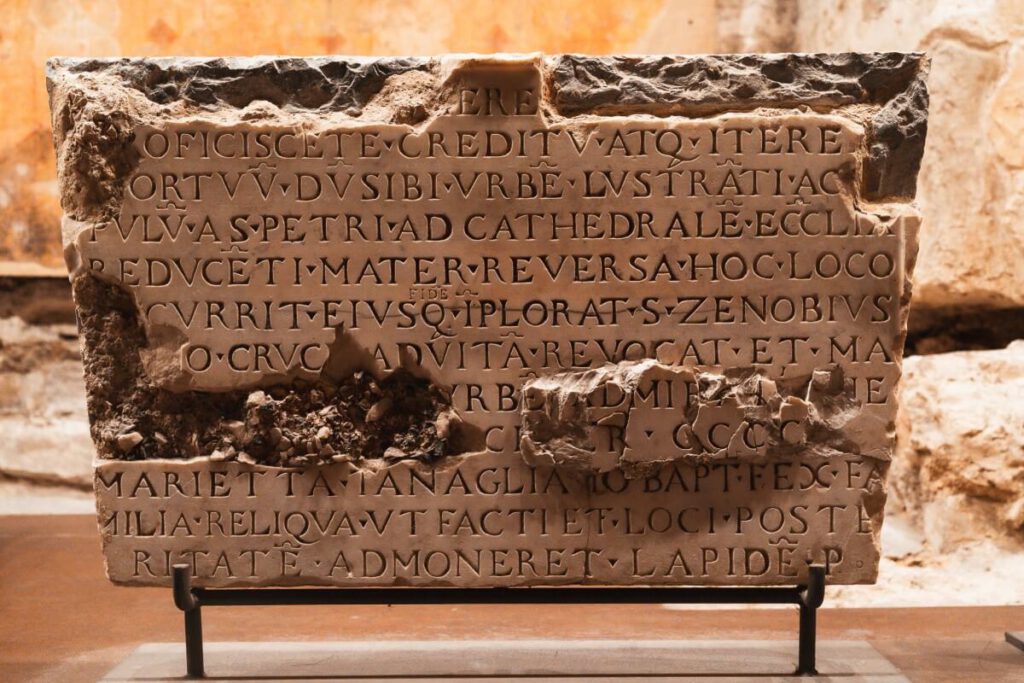
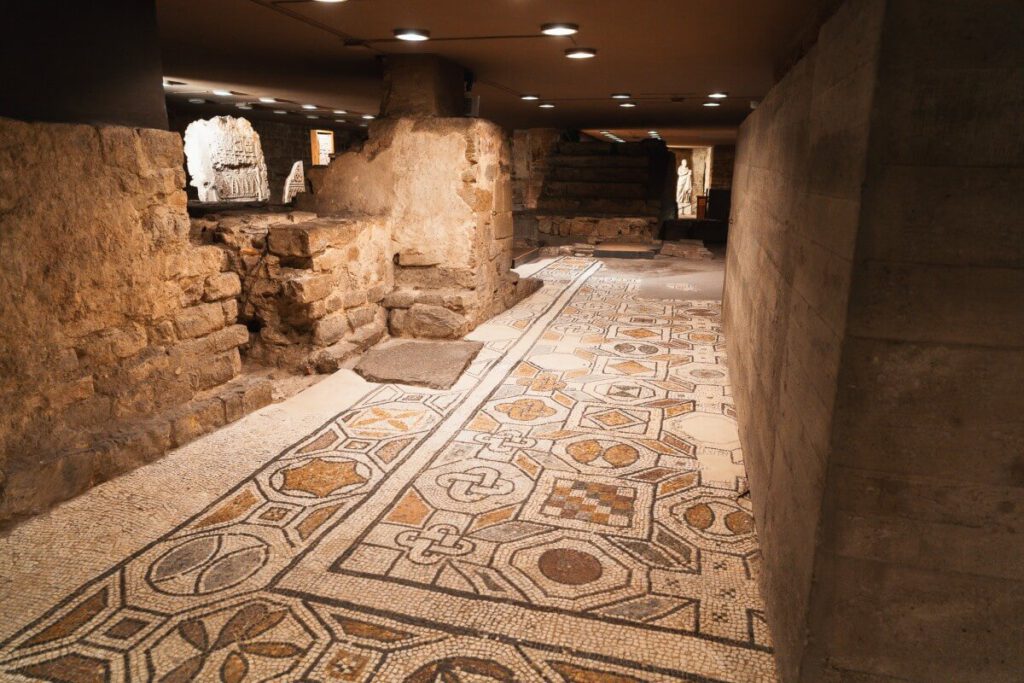
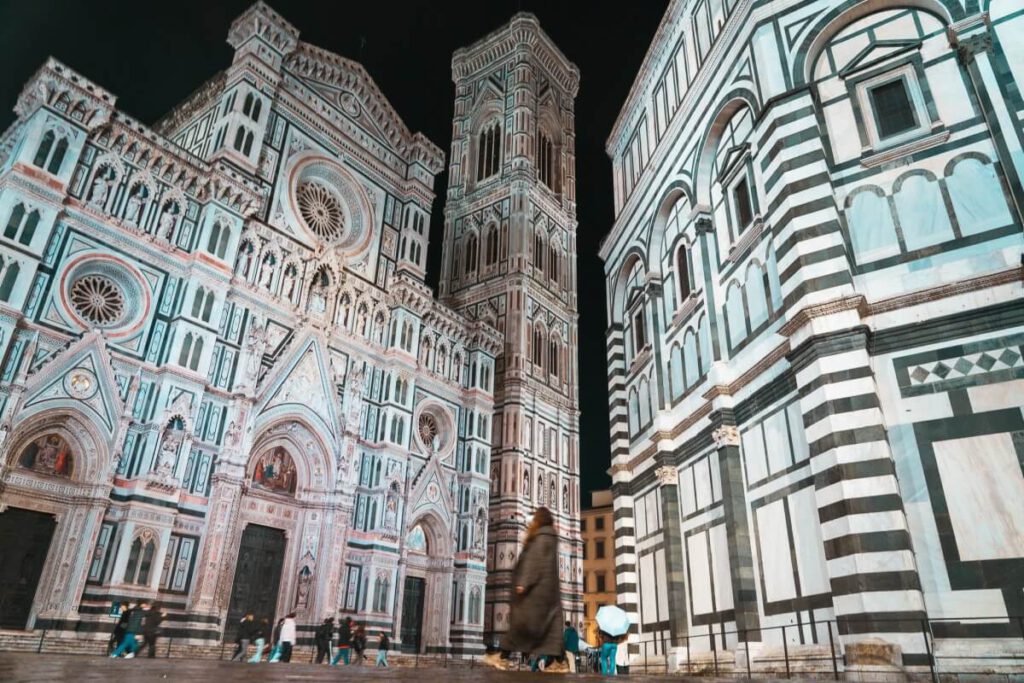
Visiting the inside of the cathedral is free of charge. However, you will have to wait a long time without a ticket as there are often queues of tourists at the entrance.
It is better to get tickets in advance. There are 3 different tickets for the cathedral which include different admissions:
- Bruneschelli Pass
- Giotto Pass
- Ghiberti Pass
Everything is included in the Bruneschelli Pass for €30 per person. In my opinion, this price is worth it because it also gives you access to the very top of the Bruneschelli dome, from where you have a wonderful panoramic view over Florence. The climb up the 463 steps alone is an experience in itself.
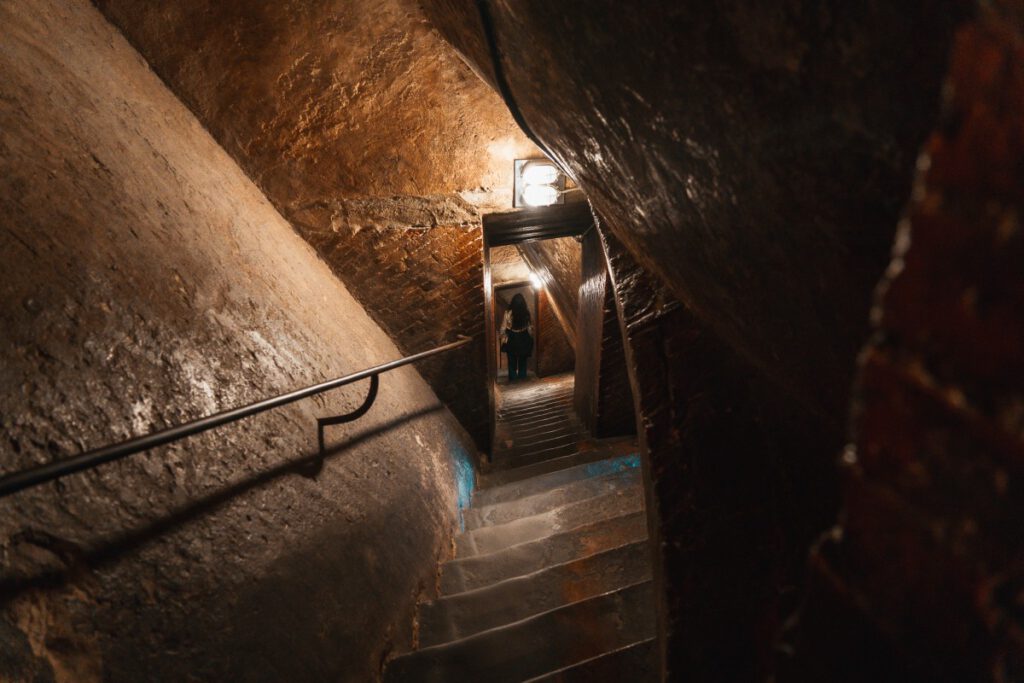
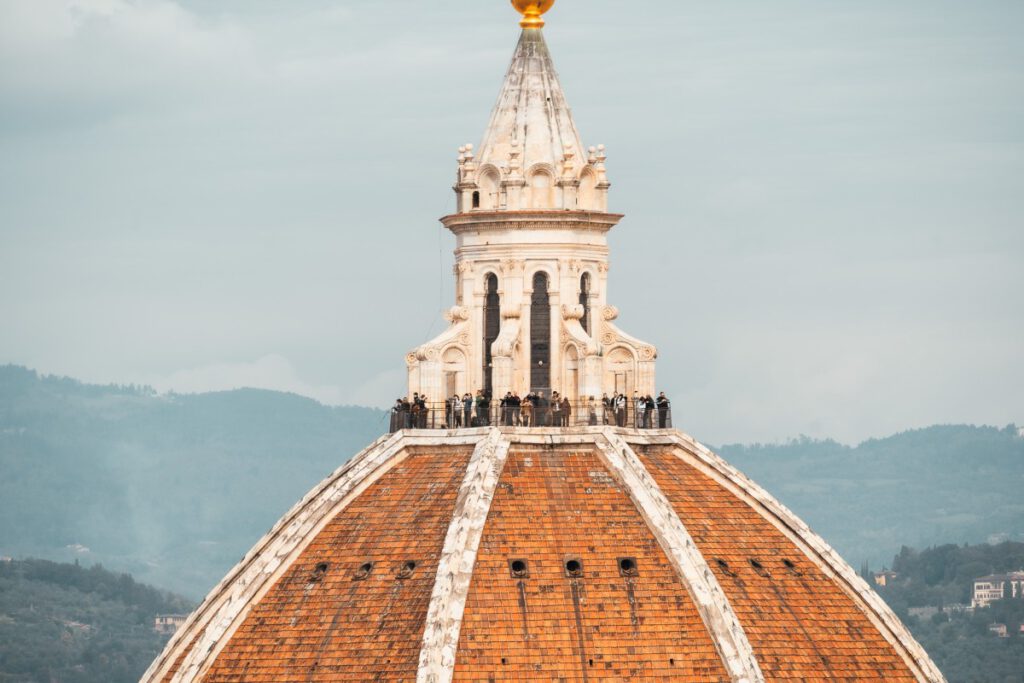
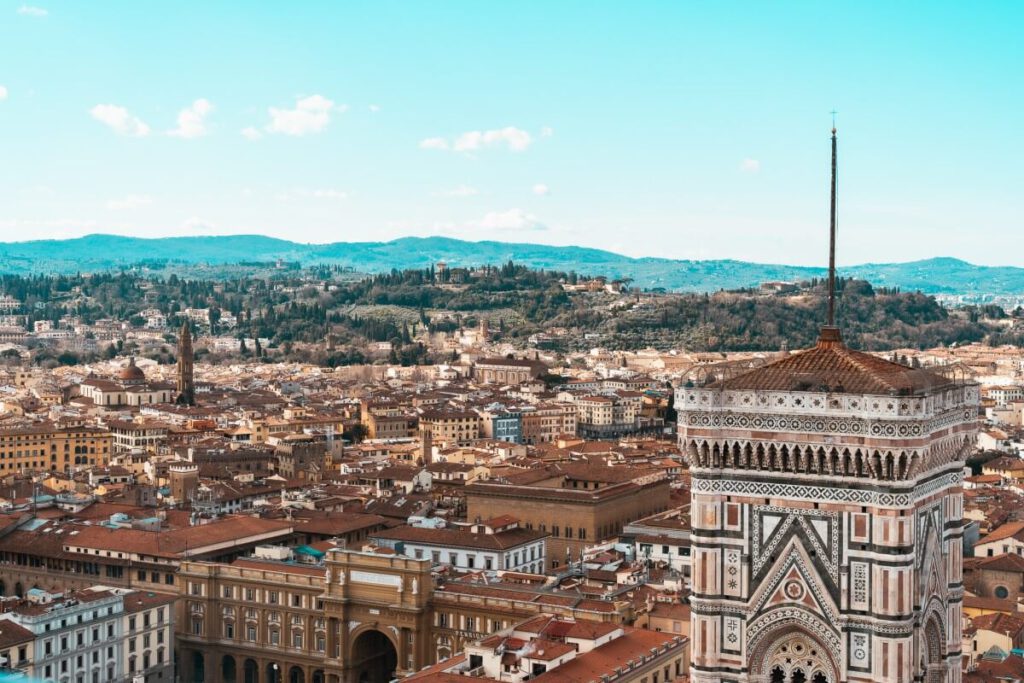
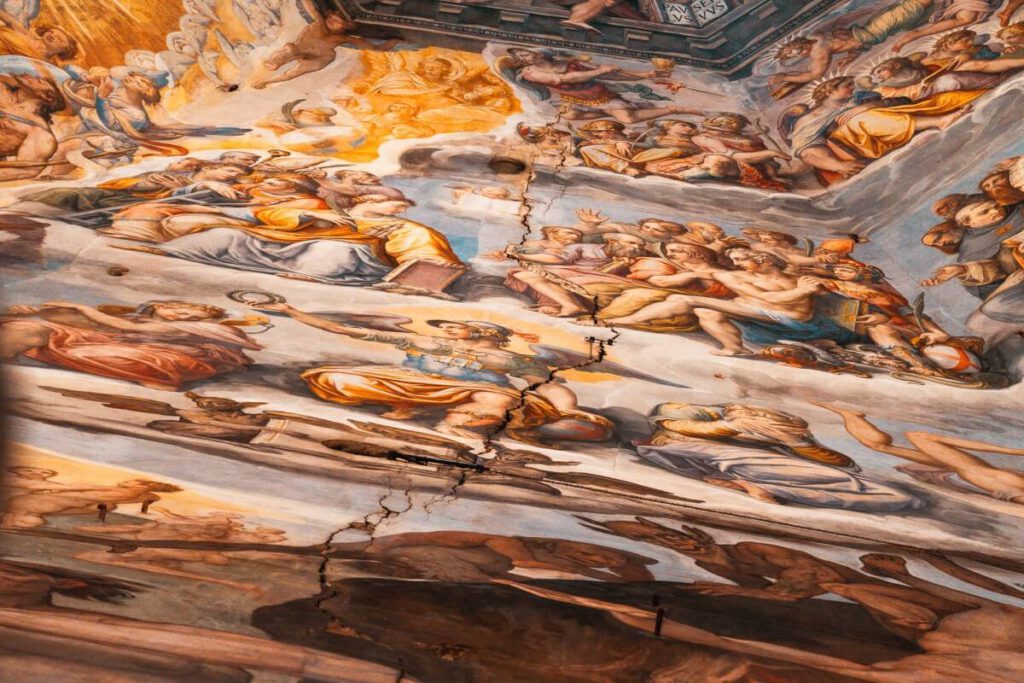
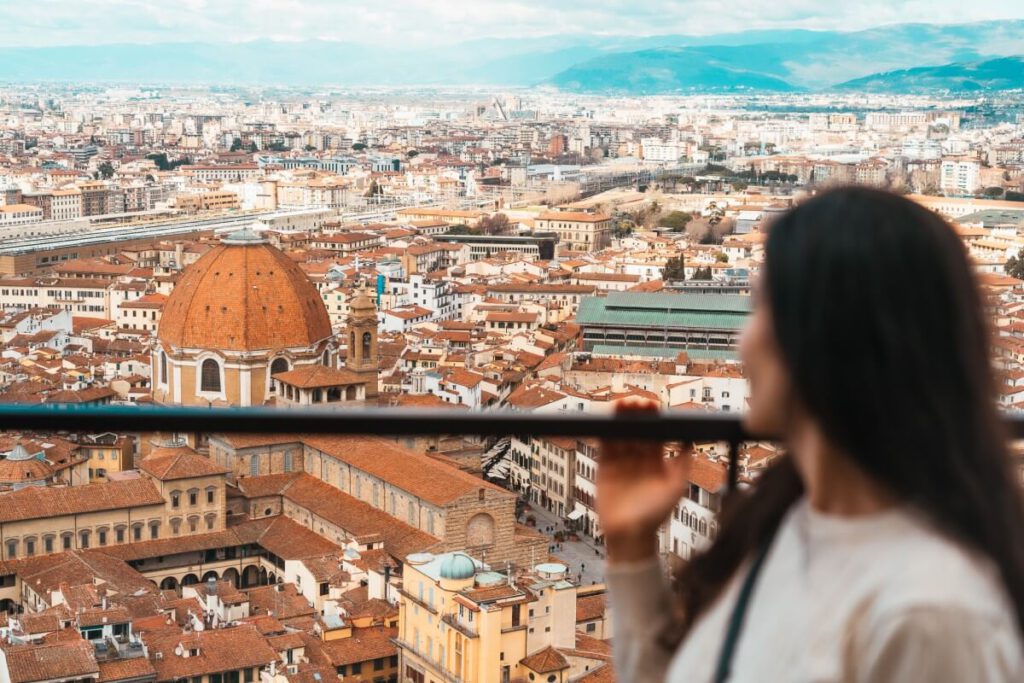
You don’t have to queue for all 3 passes and you don’t have to do everything in one day. This is because the ticket is valid for 3 days from the date of purchase. This means you can visit the dome and the cathedral on one day and the Giotto Tower on the next, or in any other order.
You can find tickets for Florence Cathedral here:
2. Il Mercato Centrale Firenze
The Florence market is not only a great place to buy fresh produce, but you also have a really cool food court on the 2nd floor with all kinds of Italian delicacies, a wine bar and a beer bar. Everything is close together in a very lively yet pleasant atmosphere.
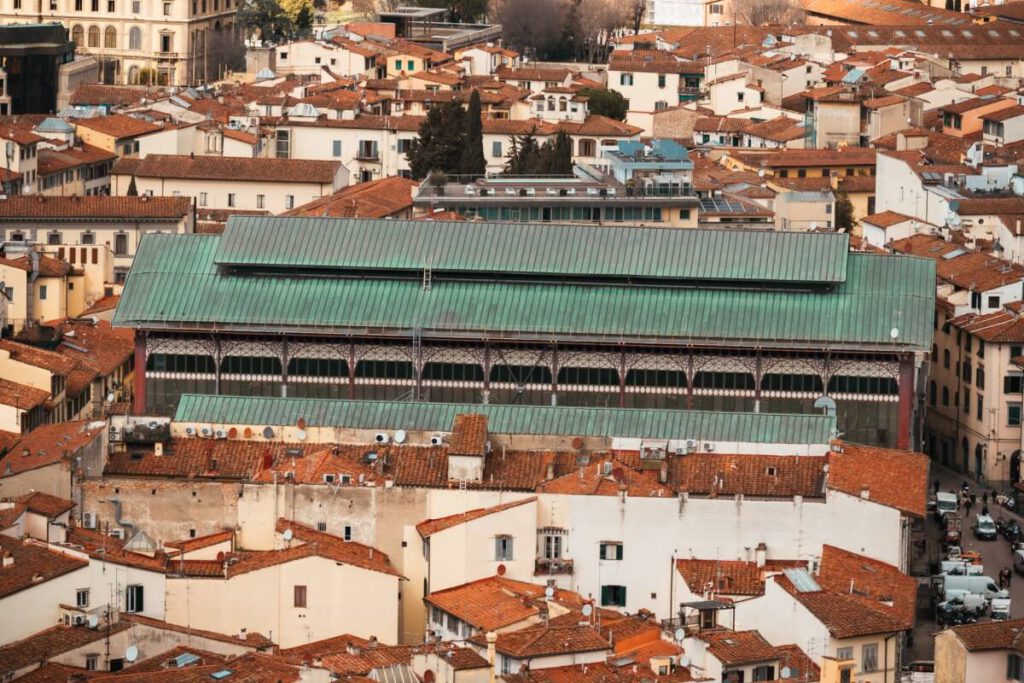
I found the food court great for eating out in the evening, because you can always try a lot here: a red wine here, a breaded eggplant there and a delicious cannoli with stracciatella there… Mhh.
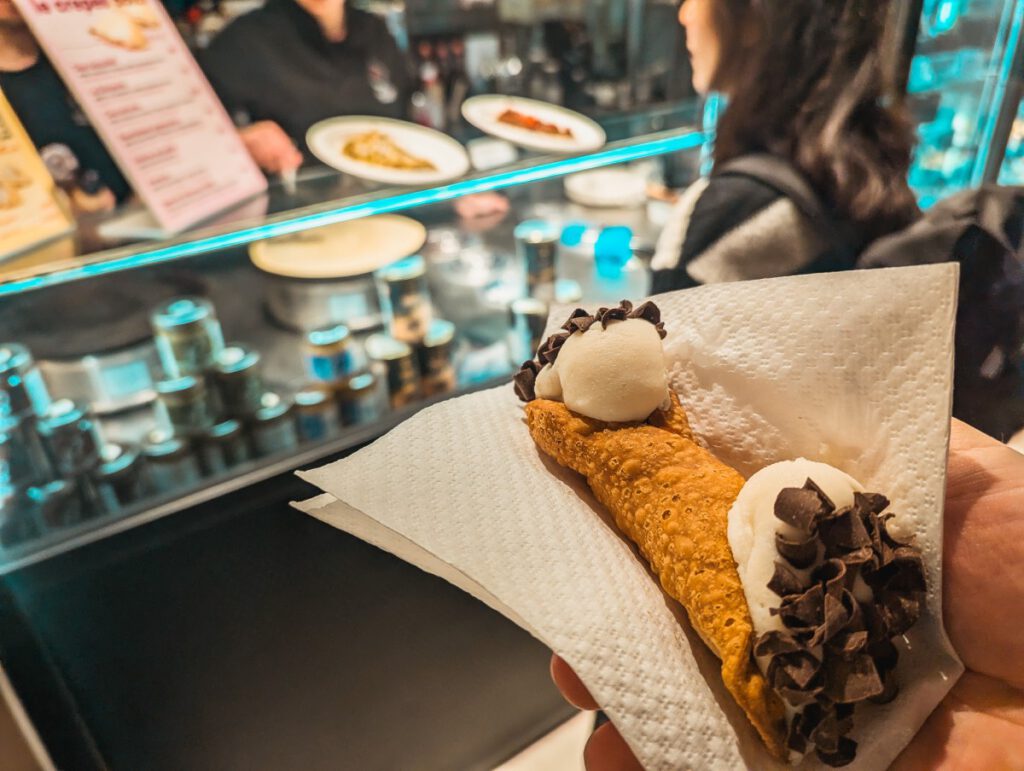
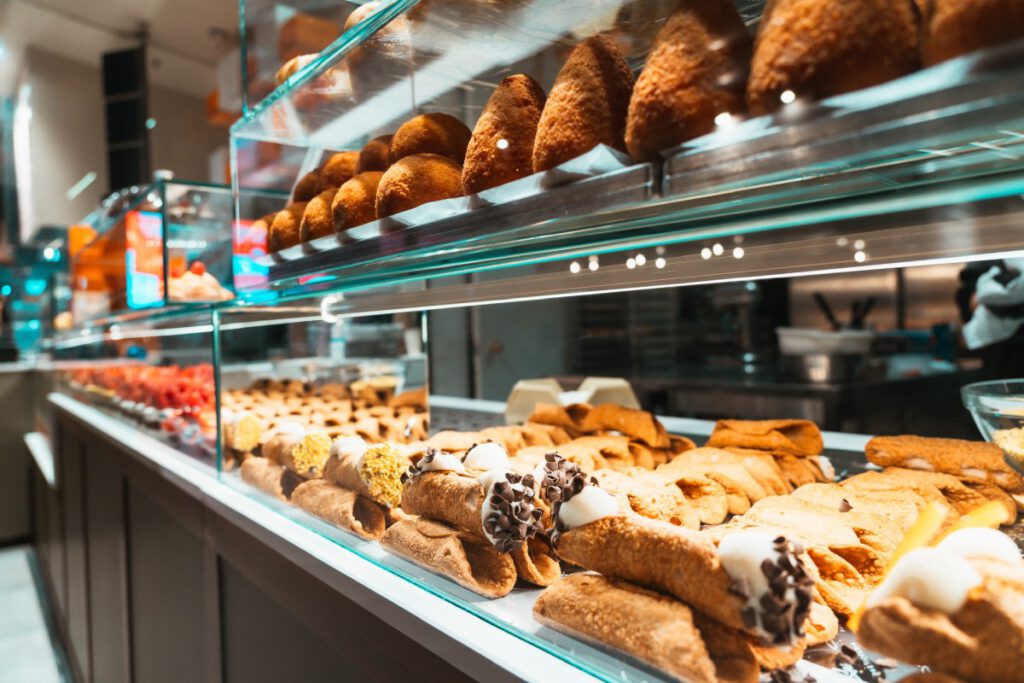
The food court is open daily until midnight. But the actual market on the lower floor of the building is also worth a visit. However, it is only open daily until 15:00. You can stock up on all kinds of Italian delicacies here. From fresh fruit and vegetables to cheese, olive oil and handmade pasta specialties, you’ll find everything your gourmet heart desires.
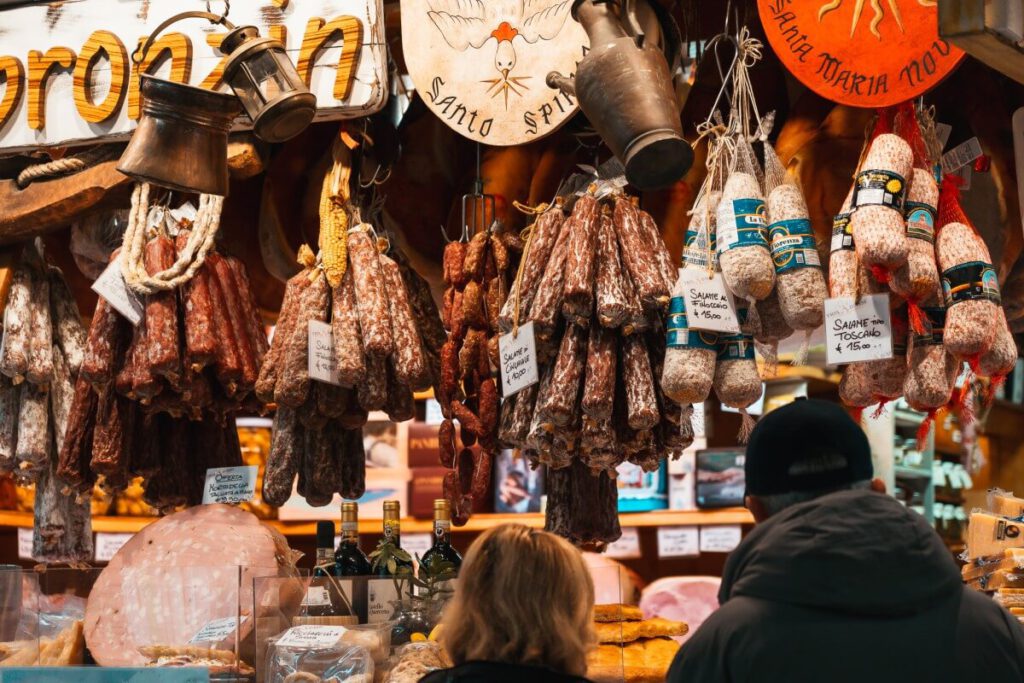
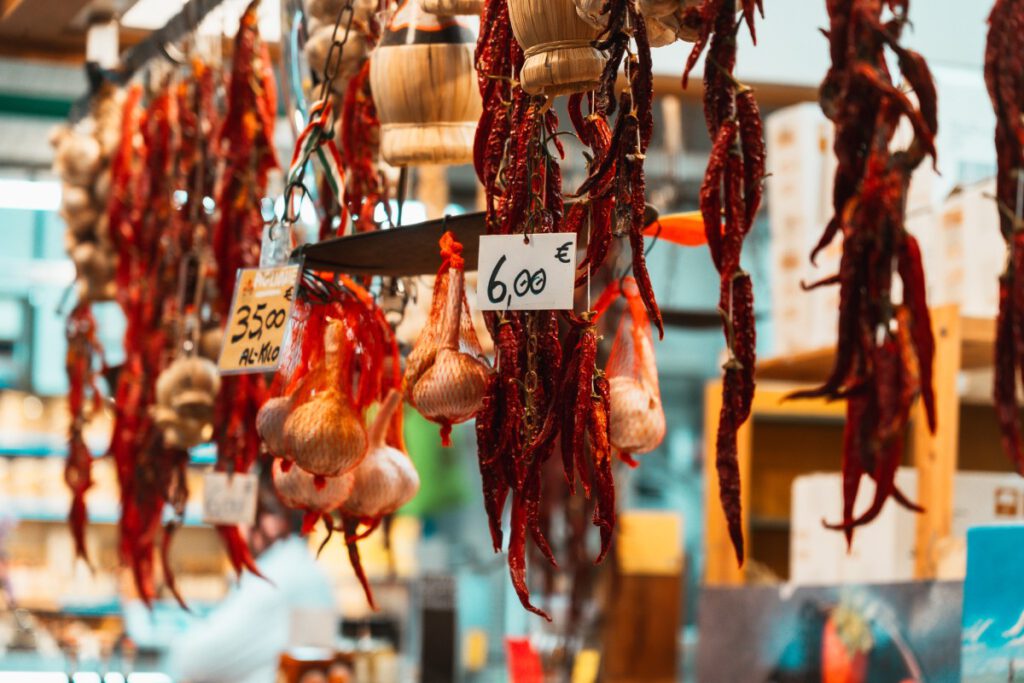
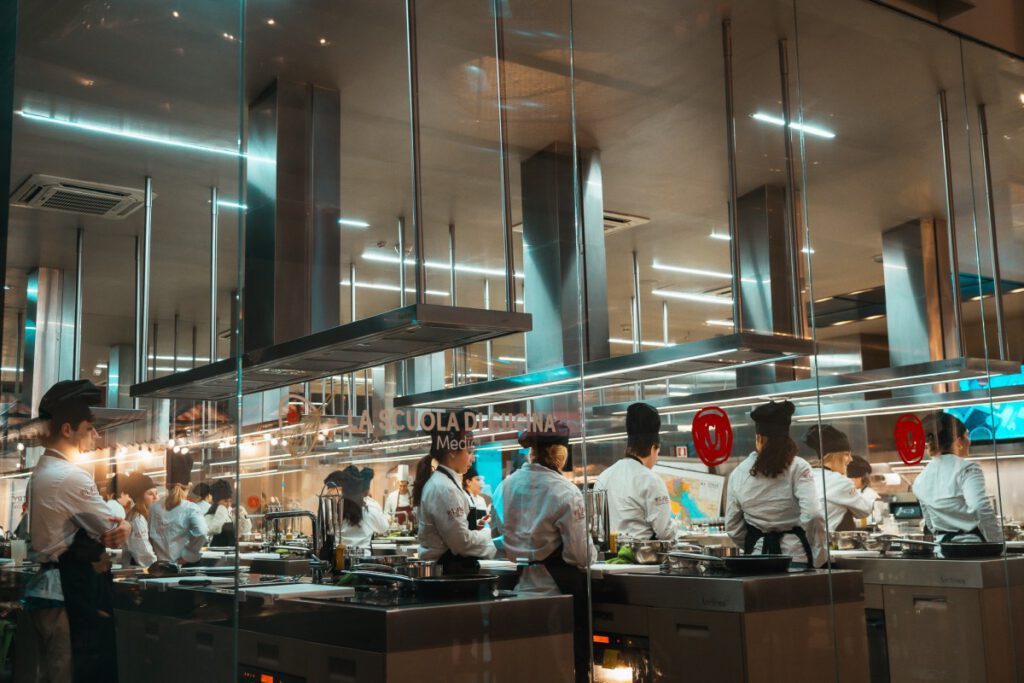
There is even a cooking school here, Cucina Lorenzo de’ Medici, which offers courses. There are also tours where you are guided through the food market in Florence and learn how to prepare delicious Tuscan dishes. You will meet the butchers, bakers and farmers and select the best ingredients for your cooking course:
- From Florence: Cooking class & lunch on a Tuscan farm (6 hours)
- Tuscan cooking course with a visit to the central market in Florence (5 hours)
- Pasta cooking course with unlimited wine selection (3 hours)
3. Farmacia di Santa Maria Novella
A pharmacy is not necessarily what you would expect to find on a list of places to visit in Florence. But this one is different. Because the Farmacia di Santa Maria Novella is the oldest pharmacy in Europe.
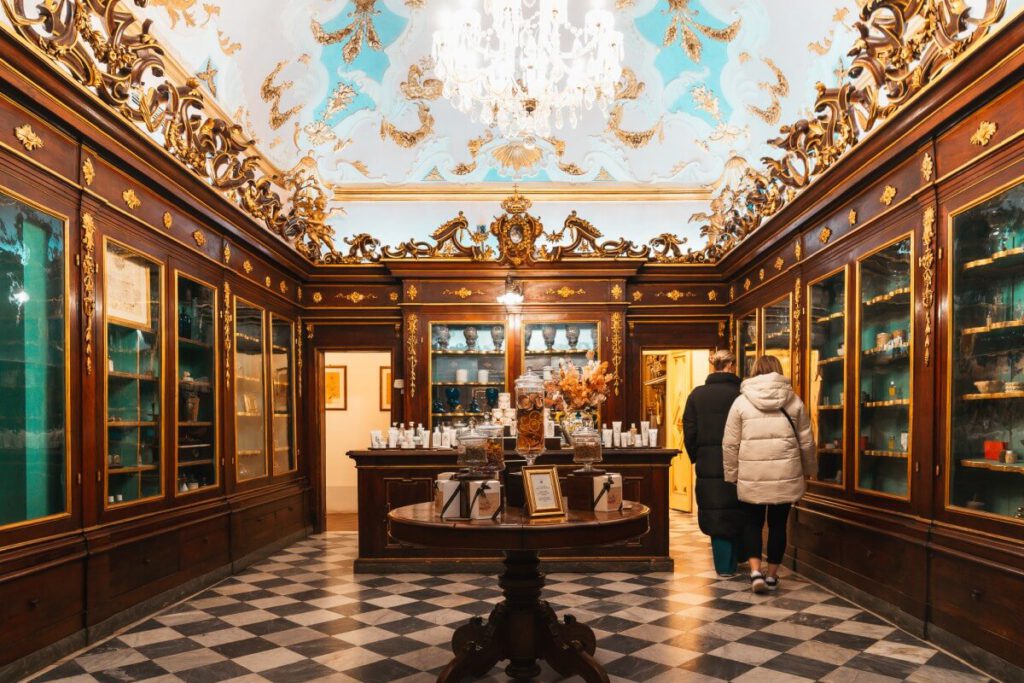
The pharmacy, as it is accessible today, dates back to 1612, but many centuries before that, the Dominican monks in the neighboring monastery were already busy selling medicine, especially rose water. Their pharmacy was founded in 1221 and was originally used to supply the monastery infirmary.

If you stroll through the halls of the Farmacia di Santa Maria Novella today, you might even feel a bit like you’re in a Renaissance museum: Many frescoes, carved walnut cabinets, terracotta vases and oil paintings adorn the sales rooms, which now mainly only sell care products and perfume.
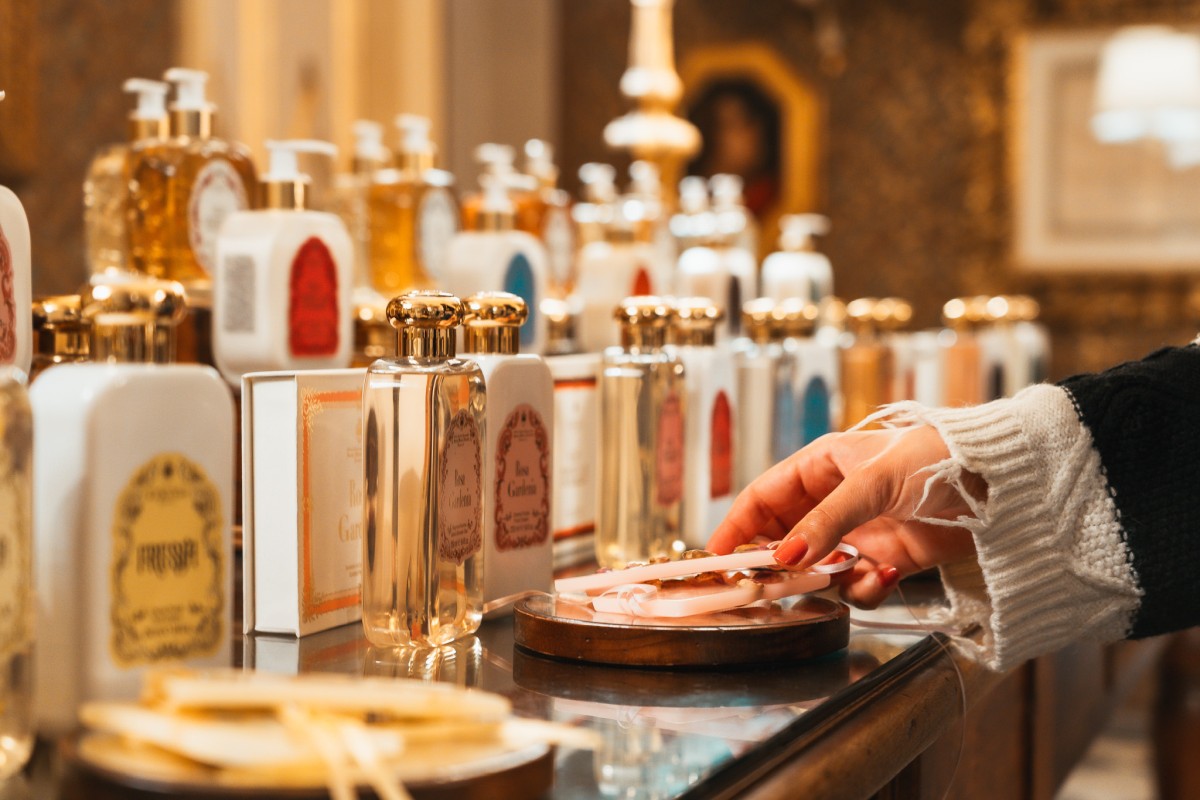
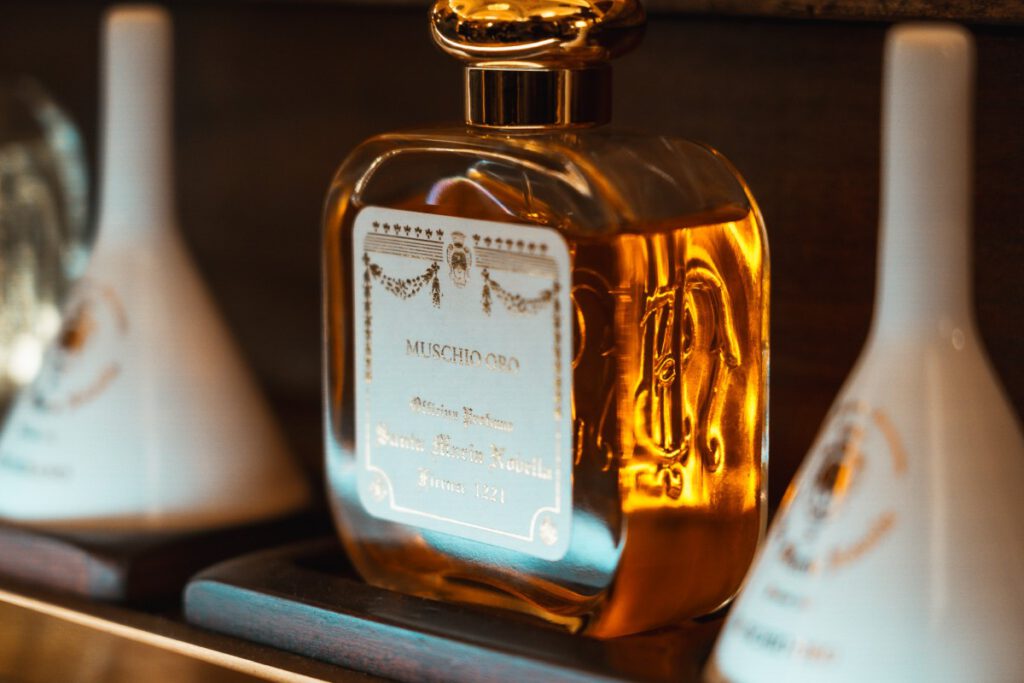
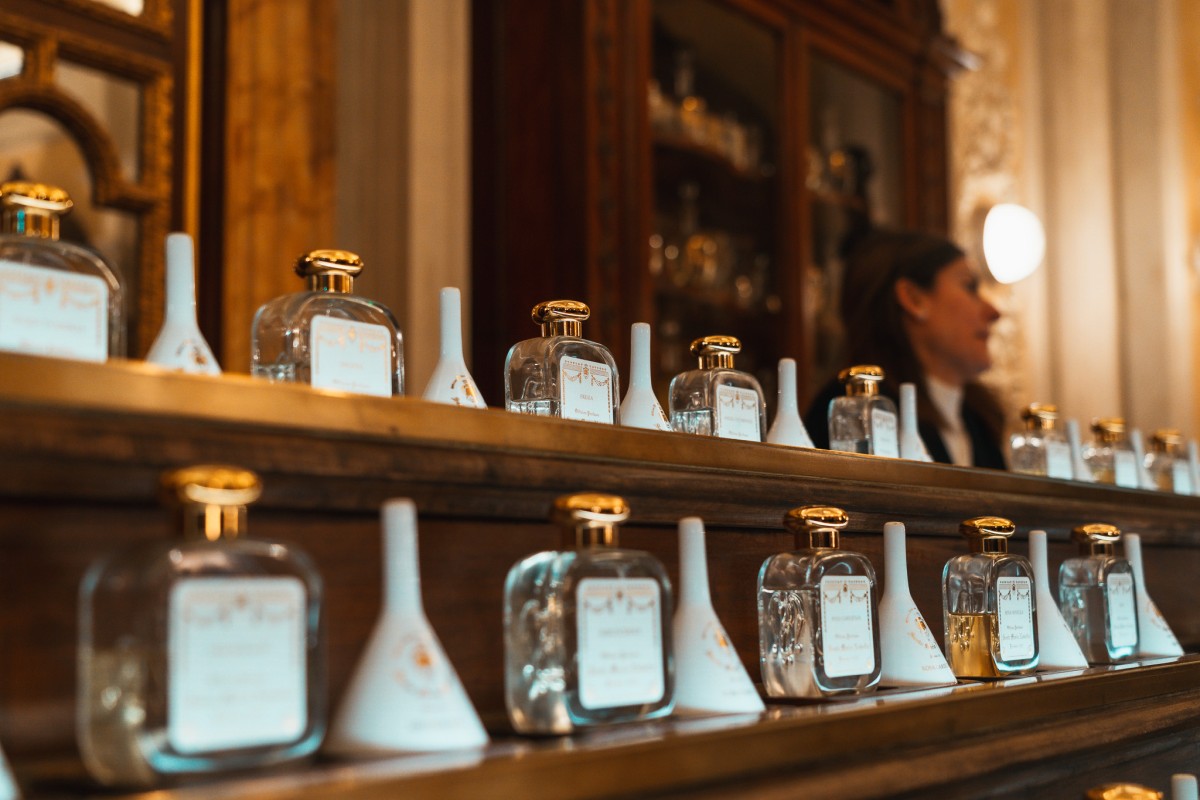
4. Galleria dell’Accademia – Statue of David by Michelangelo
The Galleria dell’Accademia is a world-famous art museum. However, most visitors come here for the statue of David by the artist Michelangelo. When he completed it, it was considered the most perfect work of art ever carved in stone and all the sculptors of his time were in awe. It is a true masterpiece without equal.
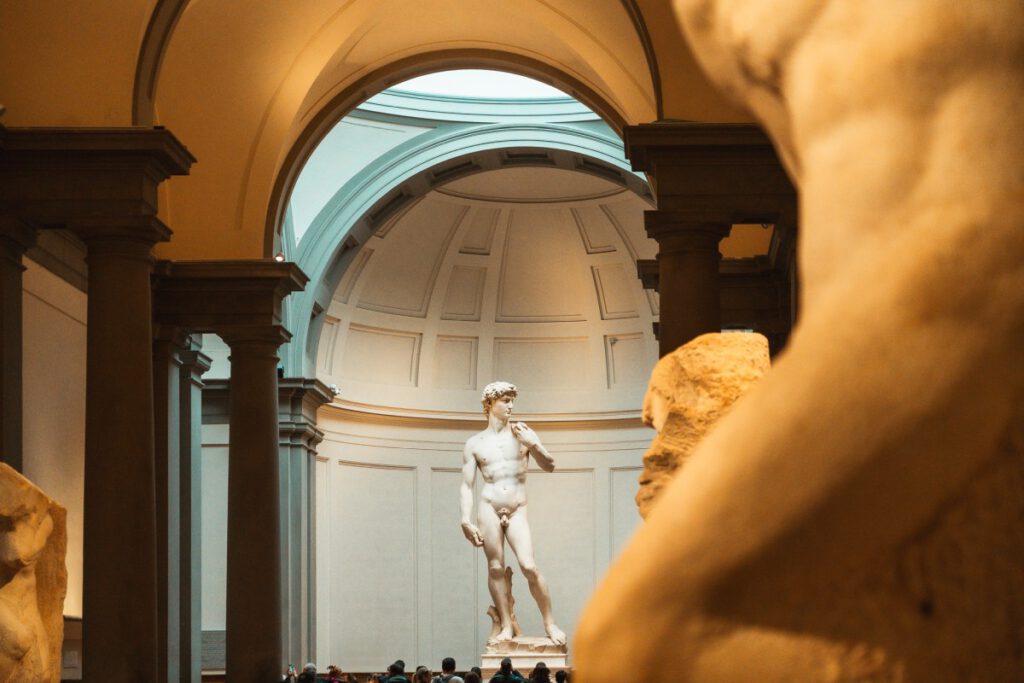
The statue carved in marble depicts David before he takes on Goliath. The wealth of detail is truly impressive. The anatomy of the body is almost perfect. You can recognize individual tendons on the arm with which David holds the slingshot. The facial expression is so realistic that you can see the determination in his eyes, a little awe and perhaps even a touch of fear.
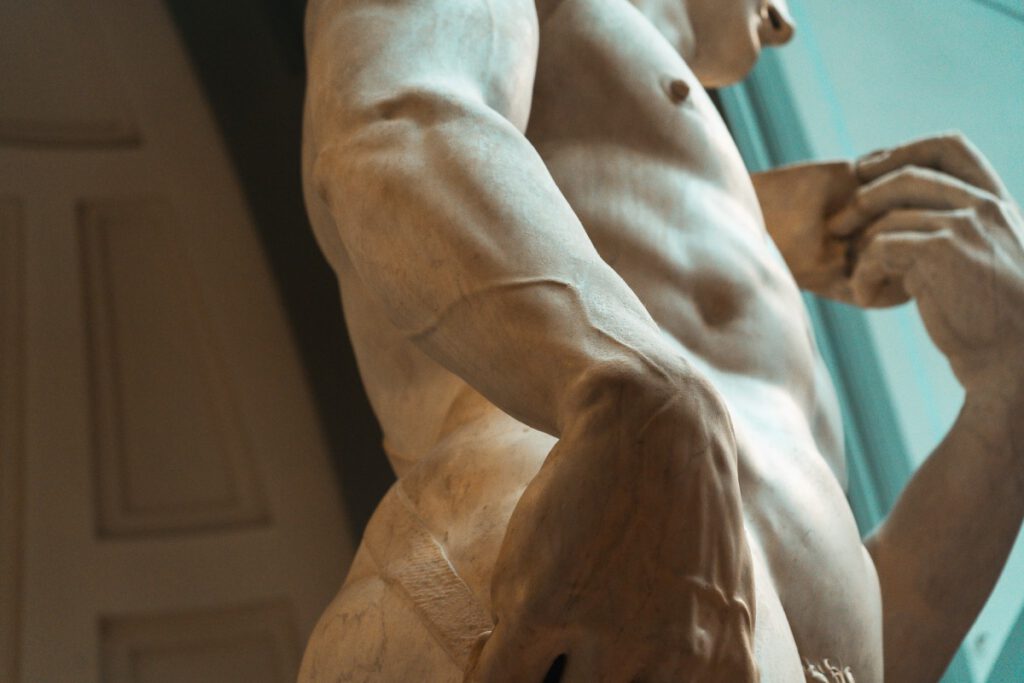
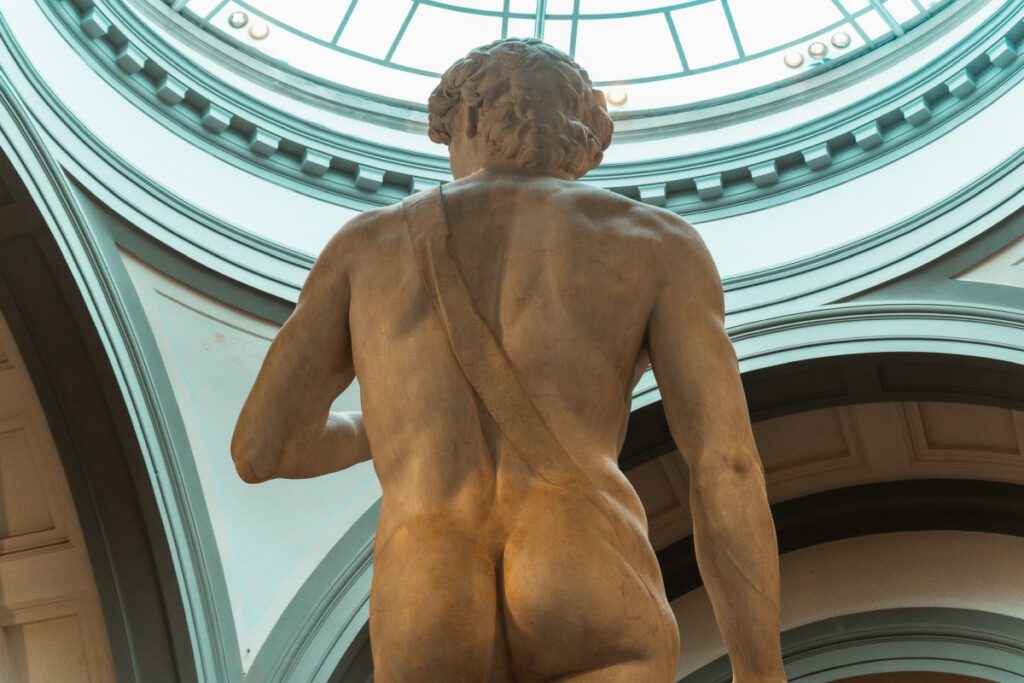
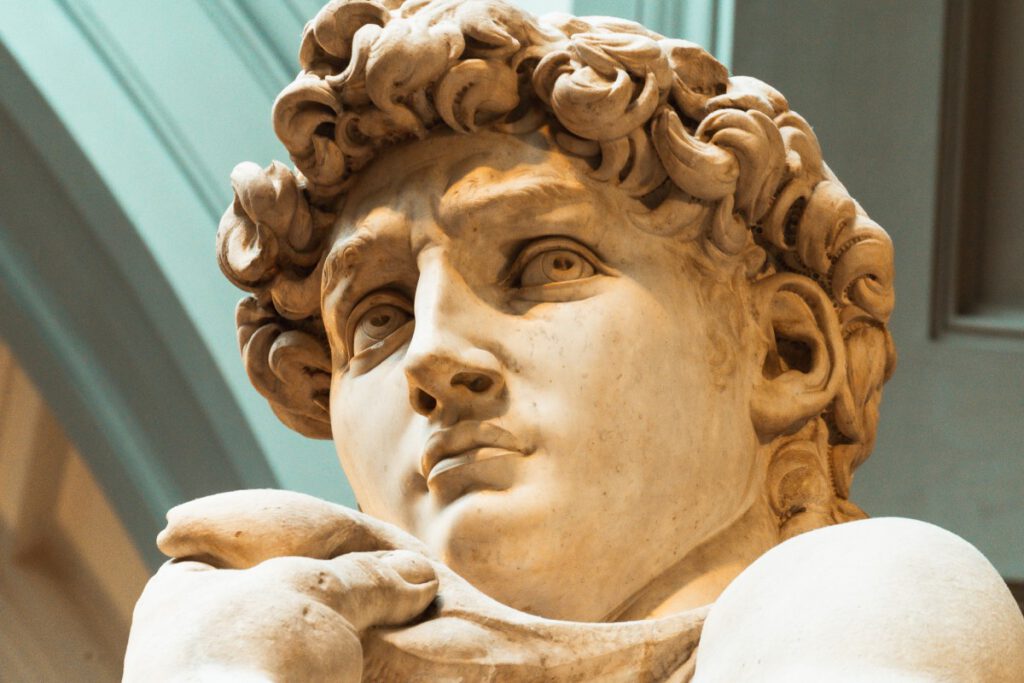
In addition to the statue of David, there are many other paintings and statues by Michelangelo and other artists to discover in the Galleria dell’Accademia. The Museum of Musical Instruments is also part of the entrance fee and you can see original Stradivarius violins, among other things.

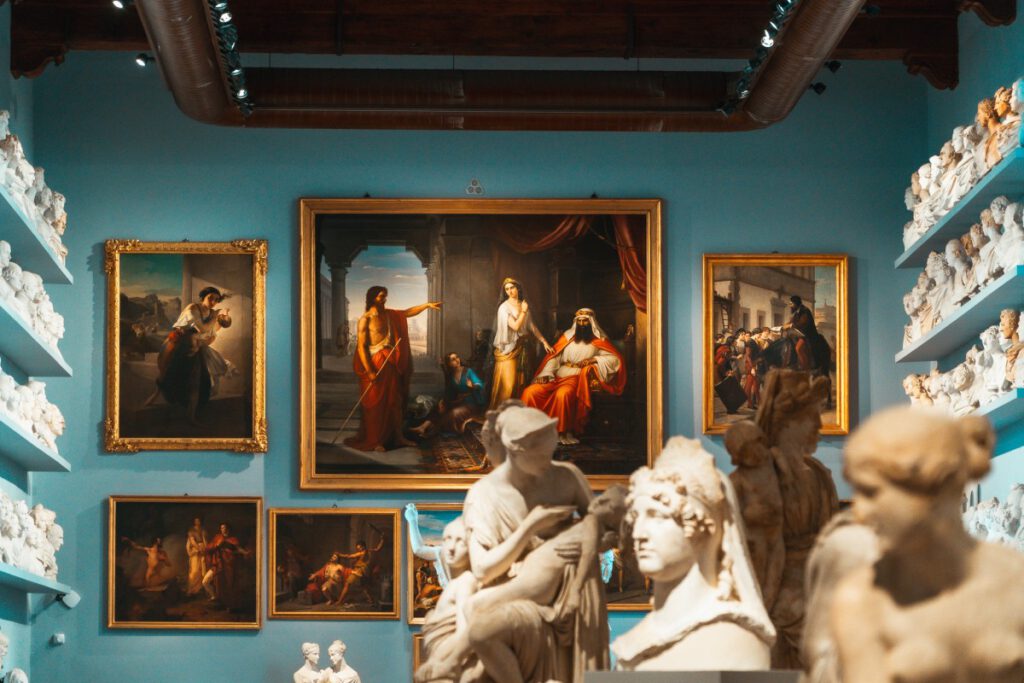
You should plan around 1 hour for the David statue and the other works in the Acadamia.
You can buy tickets for admission online here:
5. Uffizi Gallery
The Uffizi Gallery is one of the most famous art museums in the world, where you can admire masterpieces mainly from the Renaissance, but also from other eras. Cosimo I de’ Medici initiated the construction of the Uffizi in 1560 as an administrative seat. The architect Giorgio Vasari designed the building, which originally served as “offices” (Uffizi) for the government. Today, it is the heart of the Medici family’s collection of works of art that have been collected over the generations.
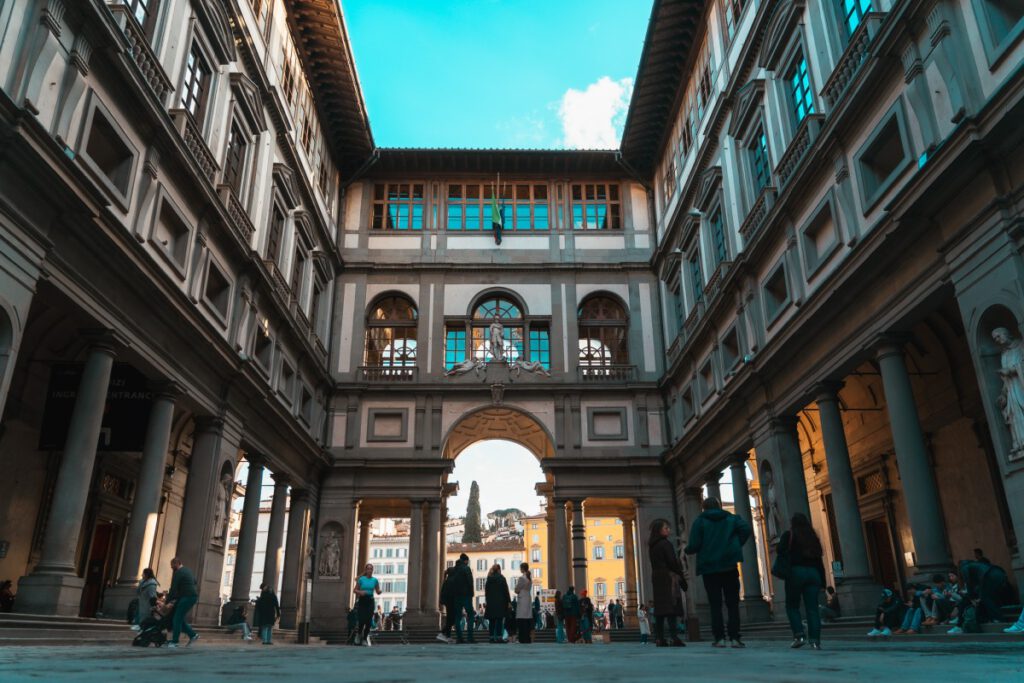
Even the impressive U-shaped corridor that connects the exhibition rooms is part of the museum. It is characterized by frescoed ceilings and Doric columns and itself serves as an exhibition space for antique sculptures. On the upper walls of the corridor, 488 portraits of famous personalities from the 16th to the 18th century have also found their place. Look out for Charles V, Dante Alighieri, Erasmus of Rotterdam, Leonardo da Vinci, Michelangelo or Raphael, for example.
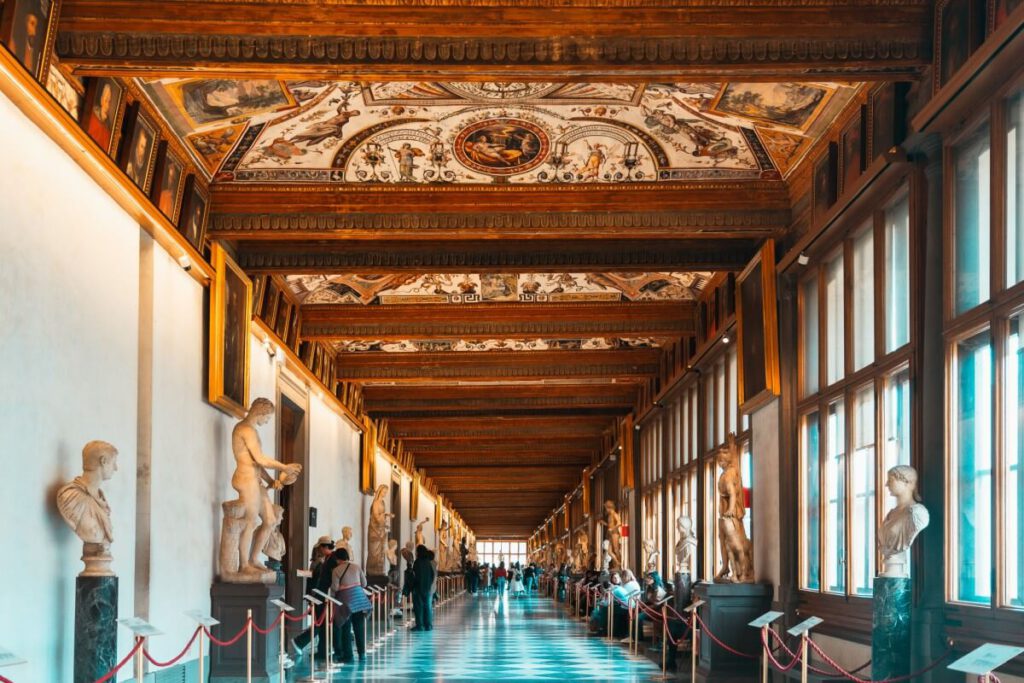
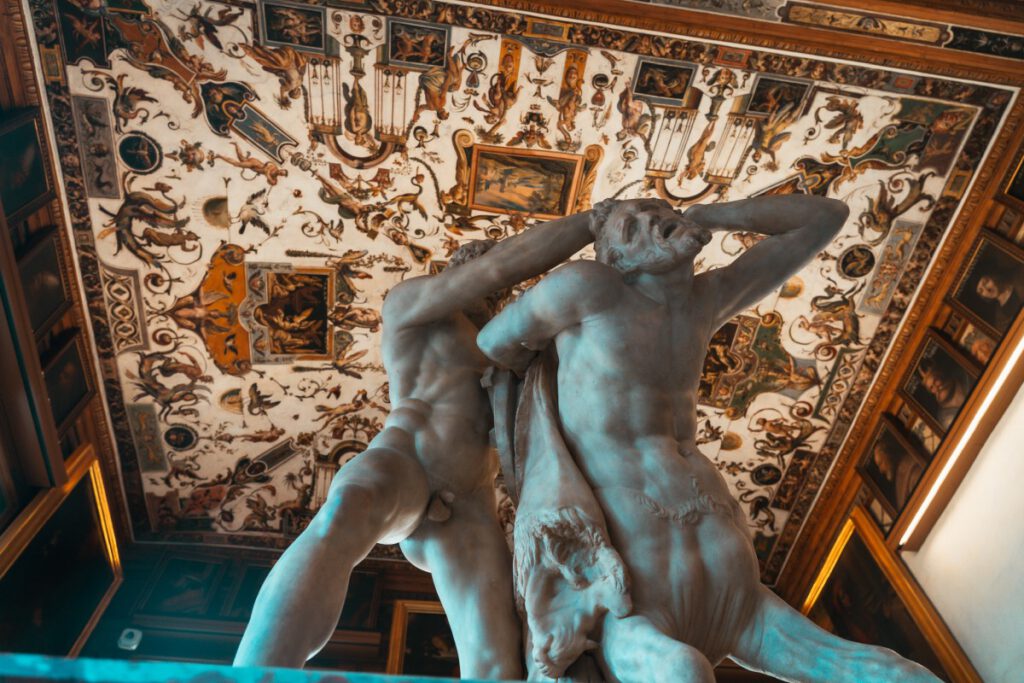
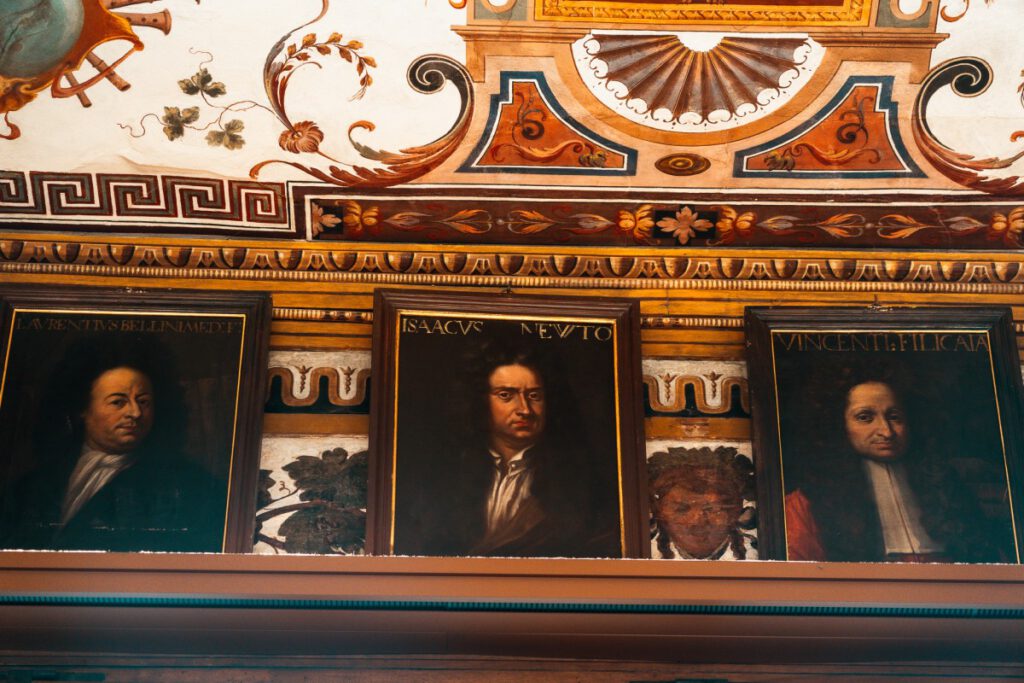
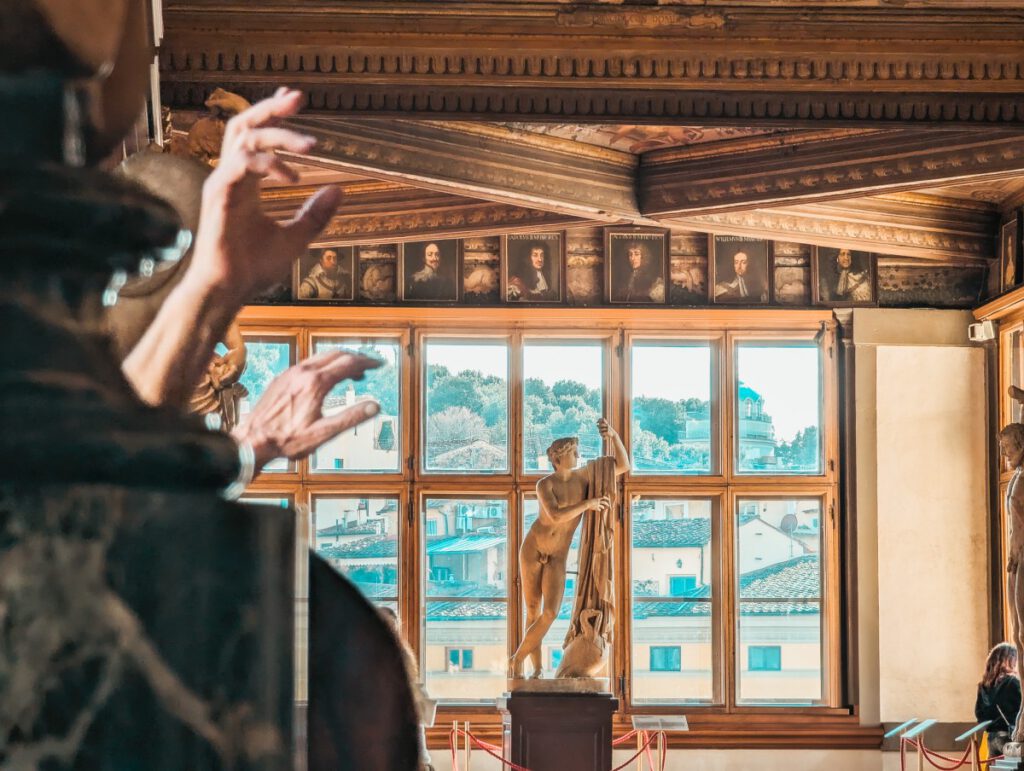
There are sometimes long queues of tourists at the Tribuna who want to take a picture of this octagonal room, which was once used to display particularly valuable works of art, only to be surprised to discover that it is much quicker to get a glimpse of the room from the side without having to stand in line for long.
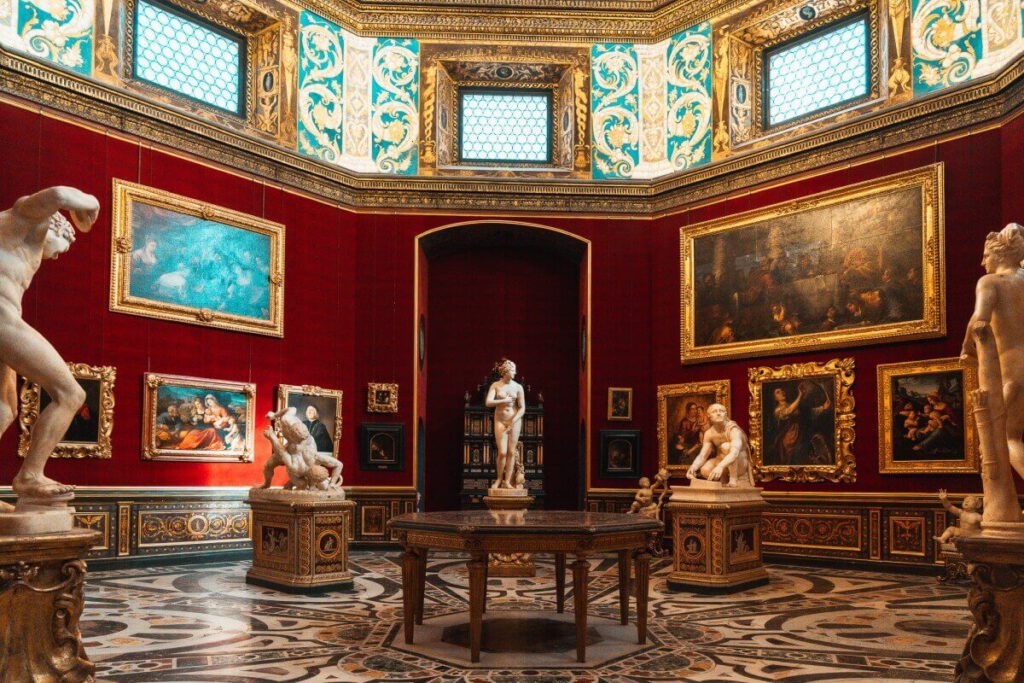
In total, there are over 2,200 works to marvel at in the Uffizi. That can be a bit overwhelming. However, you should definitely see “The Birth of Venus” and “Primavera” by Boticelli and the “Annunciation to Mary” by Leonardo da Vinci. “Medusa” by Michelangelo and “Judith and Holofernes” by Artemisia Gentileschi are also two eye-catchers.
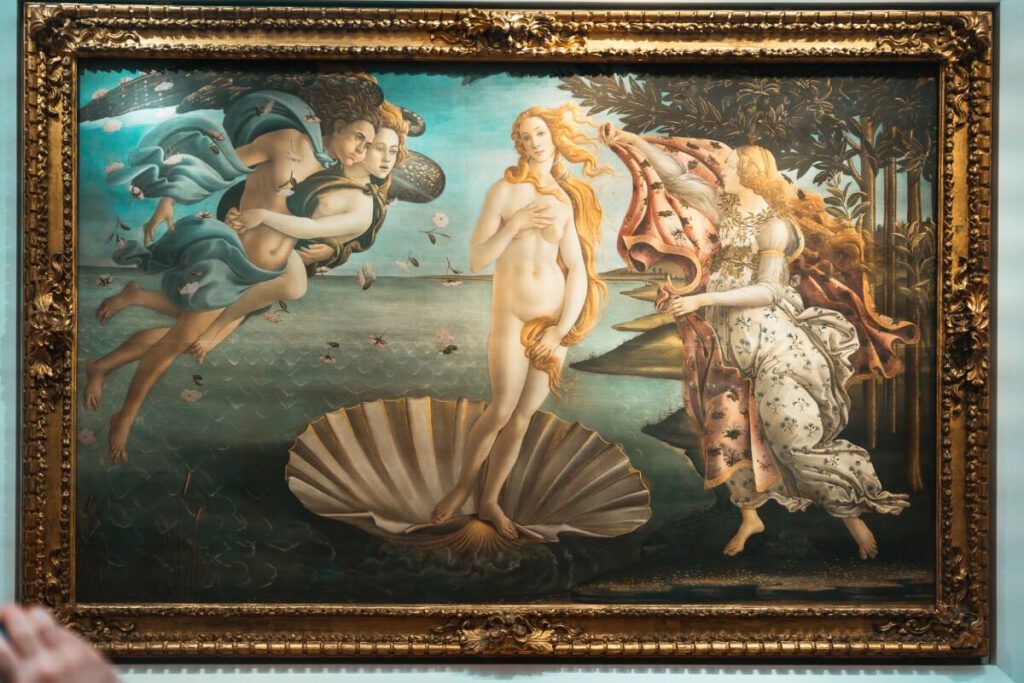
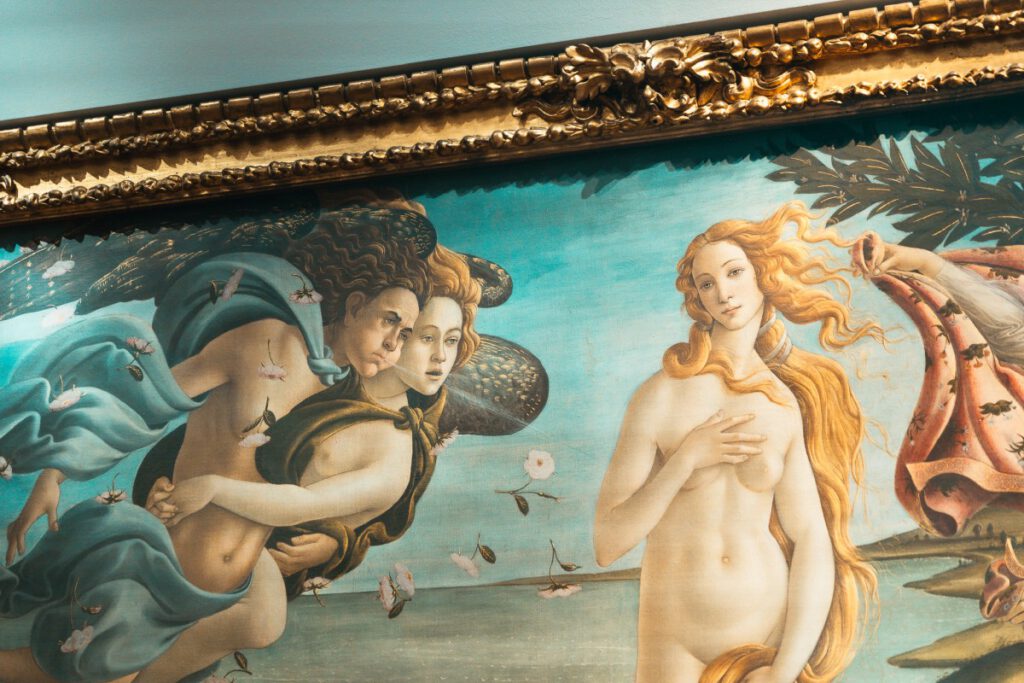
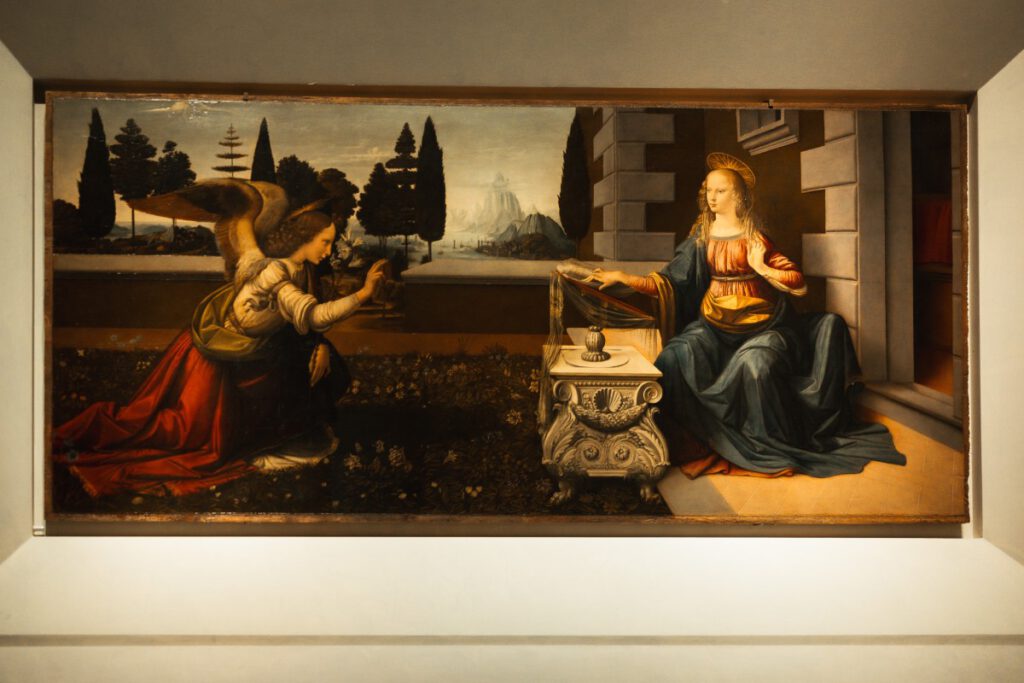
You need at least 2 hours for the Uffizi. In my opinion, however, this is the absolute minimum. In order to pay the tribute to the many masterpieces here that they deserve, you should plan 3 to 4 hours. However, art lovers who really want to discover many details can walk around here all day and still not have seen everything.
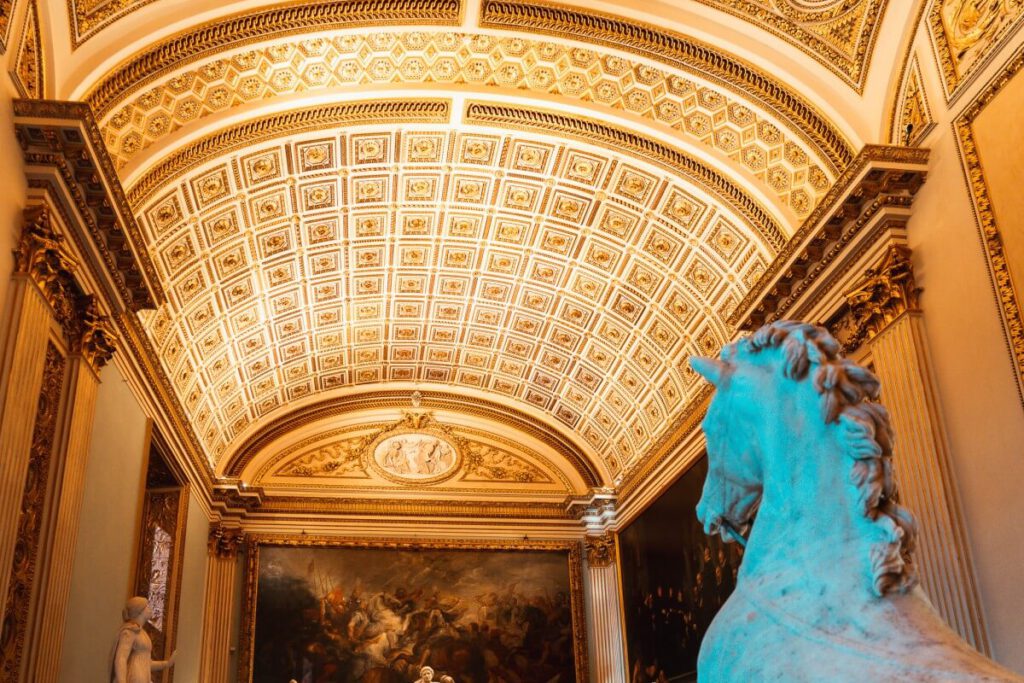
After a long period of renovation, you can also visit the Vasari Corridor. This connects the Uffizi Gallery with Palazzo Pitti, which is located on the other side of the Arno River – perfect if you want to see all the works of art in the palazzo immediately afterwards.
You can find tickets for the Uffizi Gallery here:
6. Palazzo Pitti
The Pitti Palace is a monumental Renaissance palace that was originally built in the 15th century for the banker Luca Pitti as a demonstration of power against the Medici. Today, the palace houses several museums, including the Galleria Palatina with masterpieces by Raphael and Titian and the Museum of Fashion and Costume.
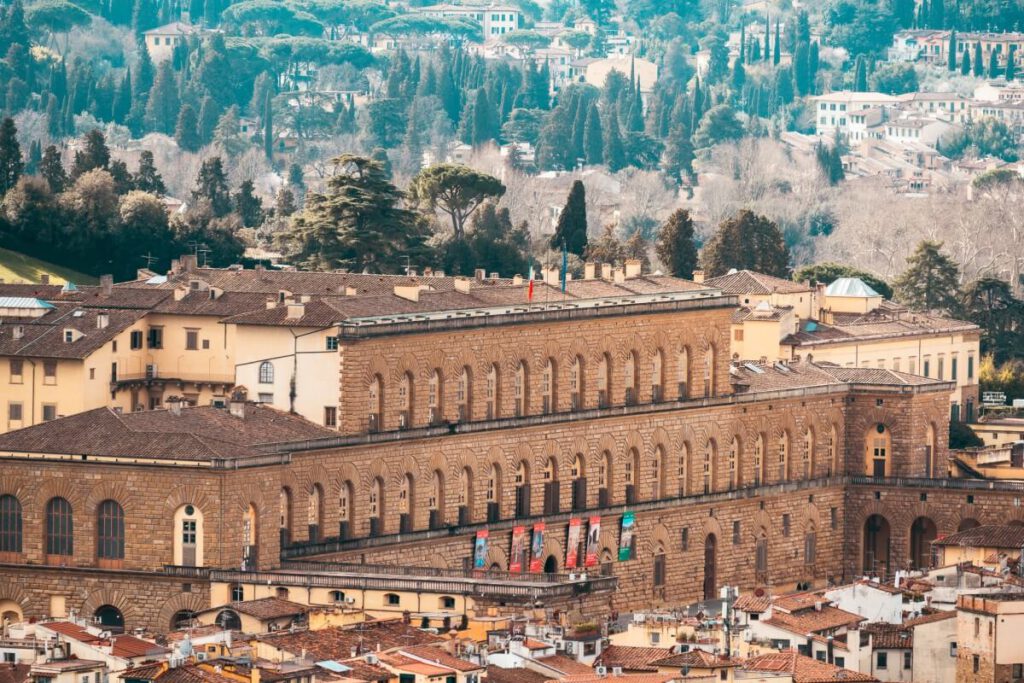
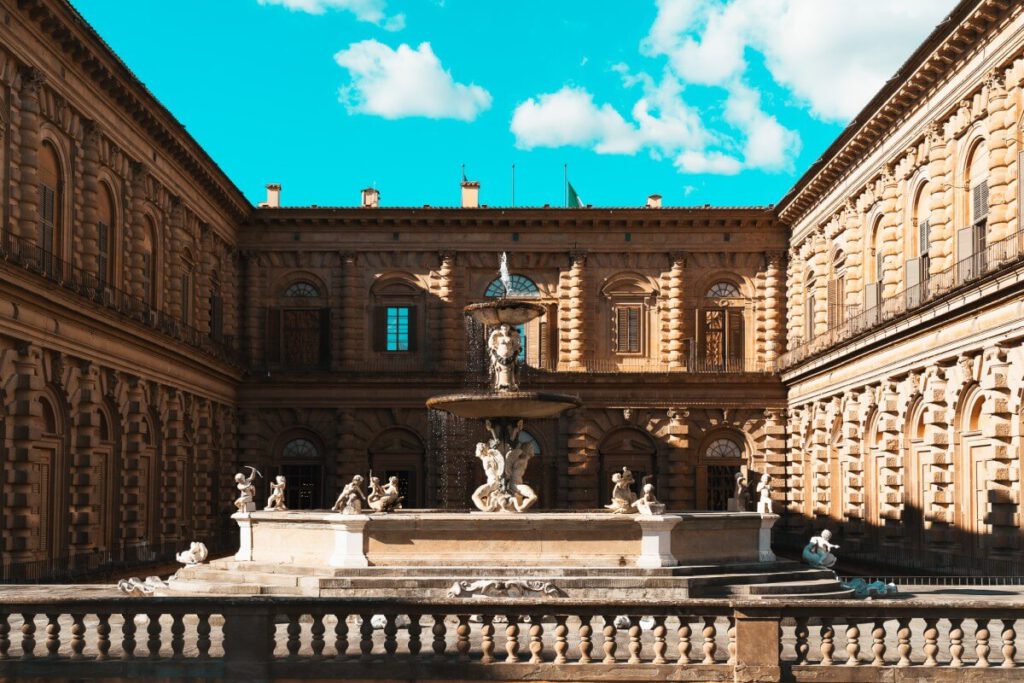
You can find tickets to Palazzo Pitti here:
7. Boboli Garden
As a change from all the Renaissance works of art, you can also visit the Boboli Gardens, a masterpiece of Renaissance garden art. The garden stretches over 4.5 hectares directly behind the Palazzo Pitti and offers an impressive collection of sculptures from Roman times to the Renaissance as well as architectural highlights such as the coffee house and many picturesque fountains. The garden is famous for its terraces, water features and cypress avenues.
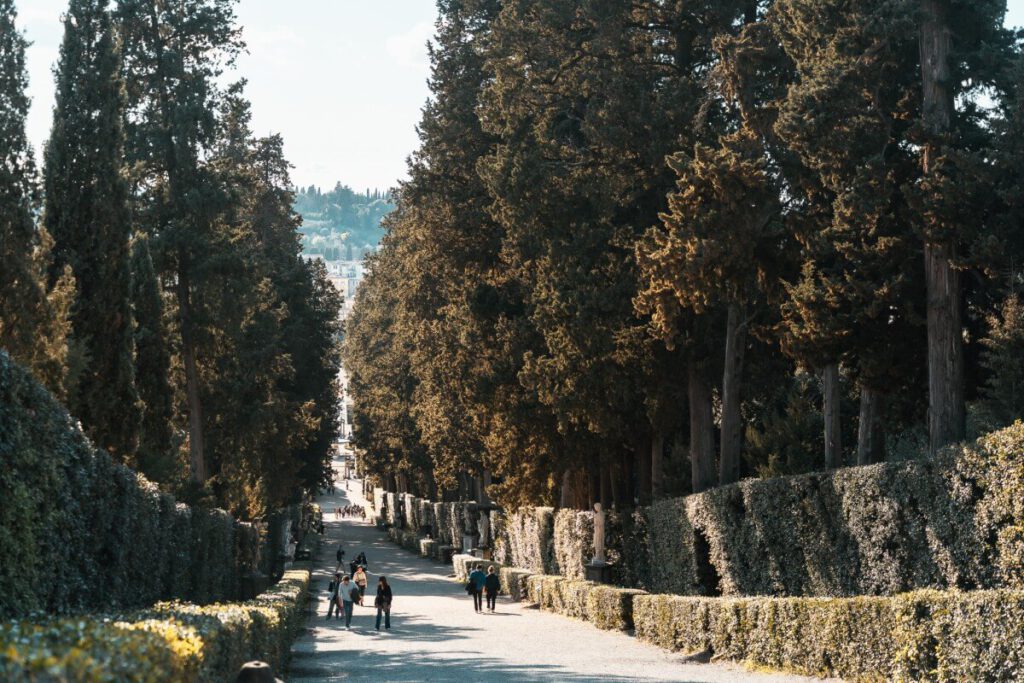
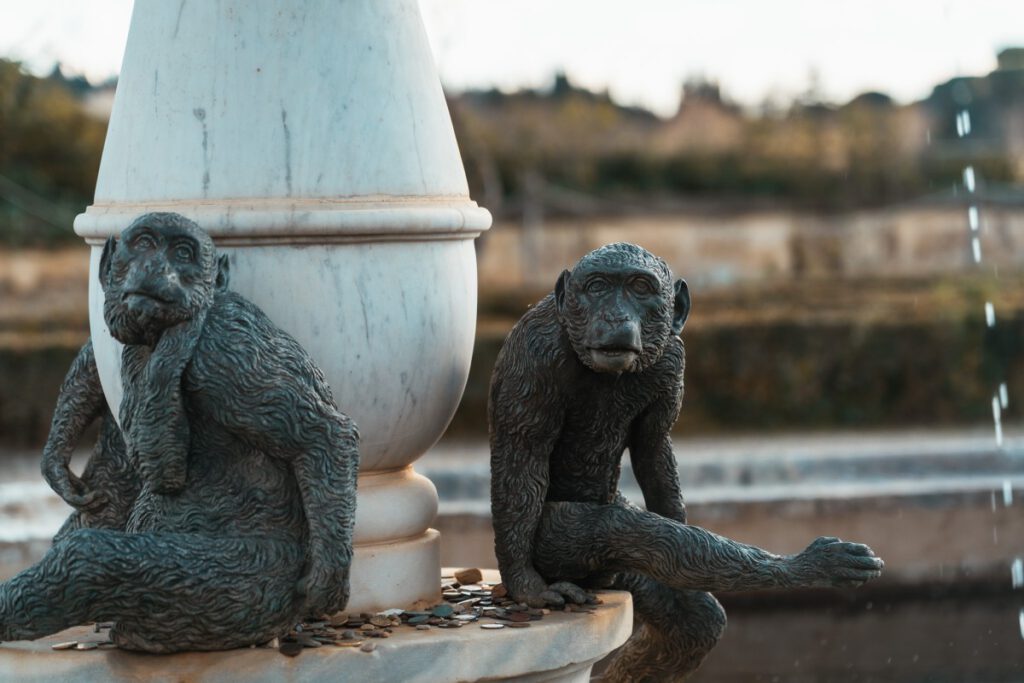
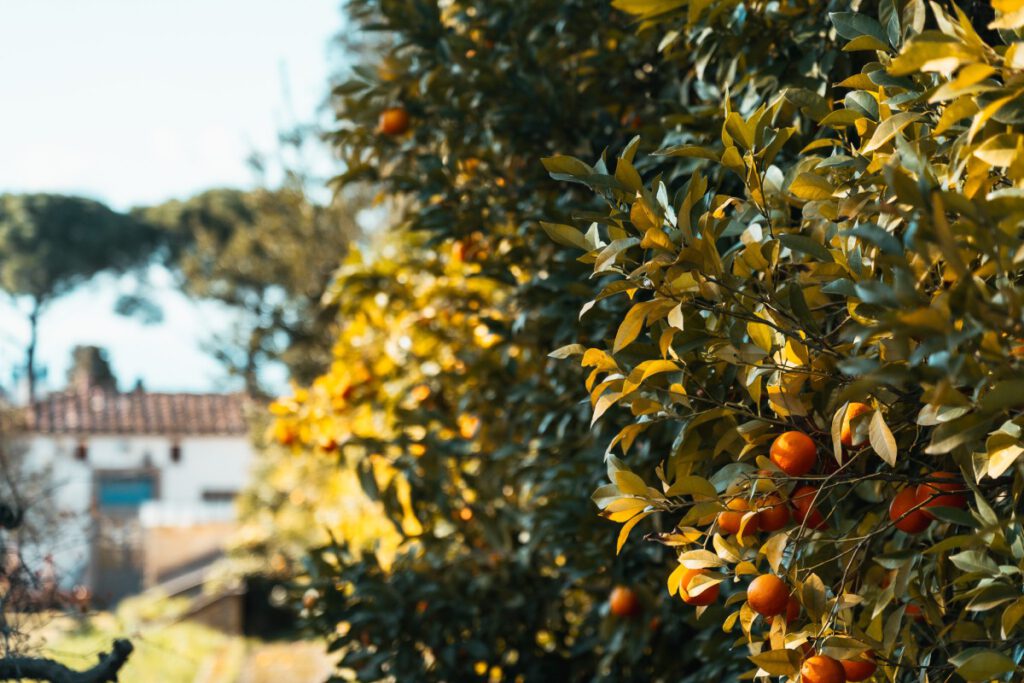
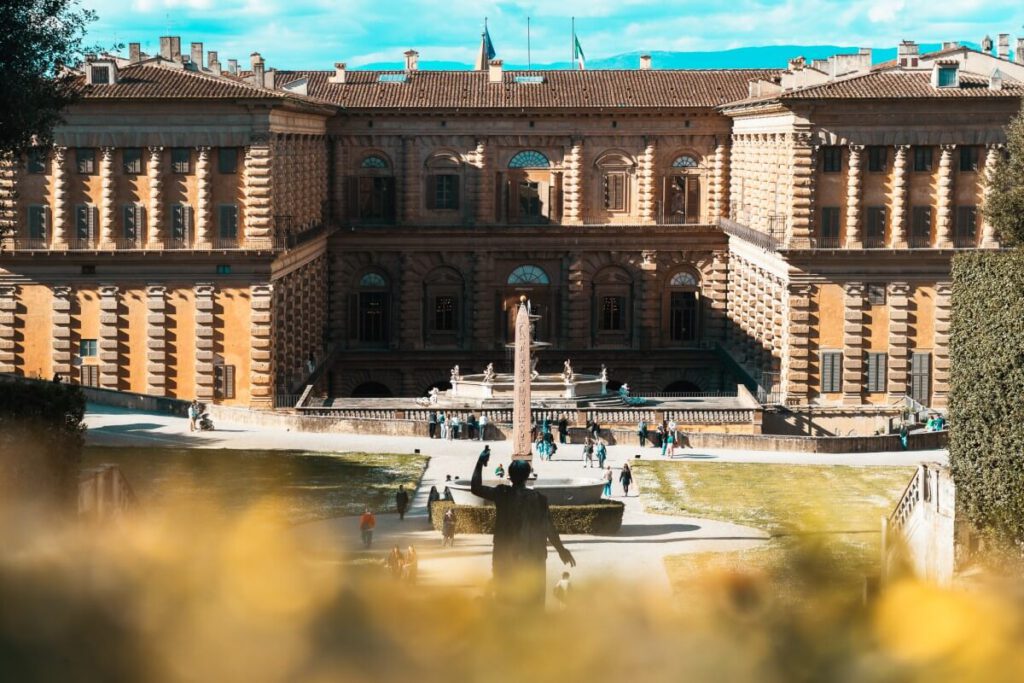
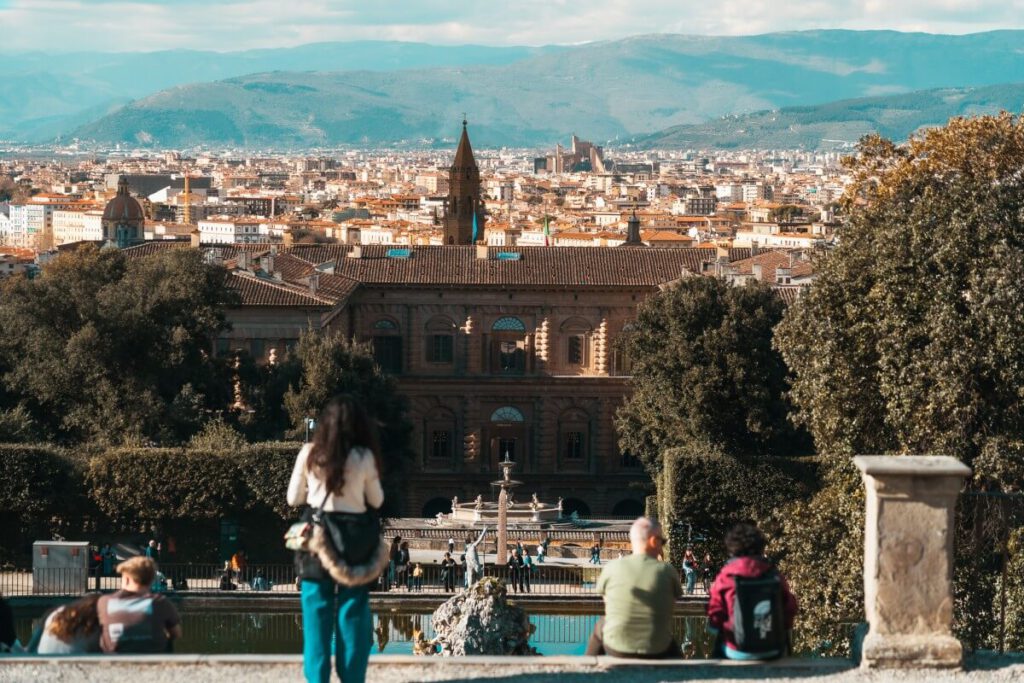
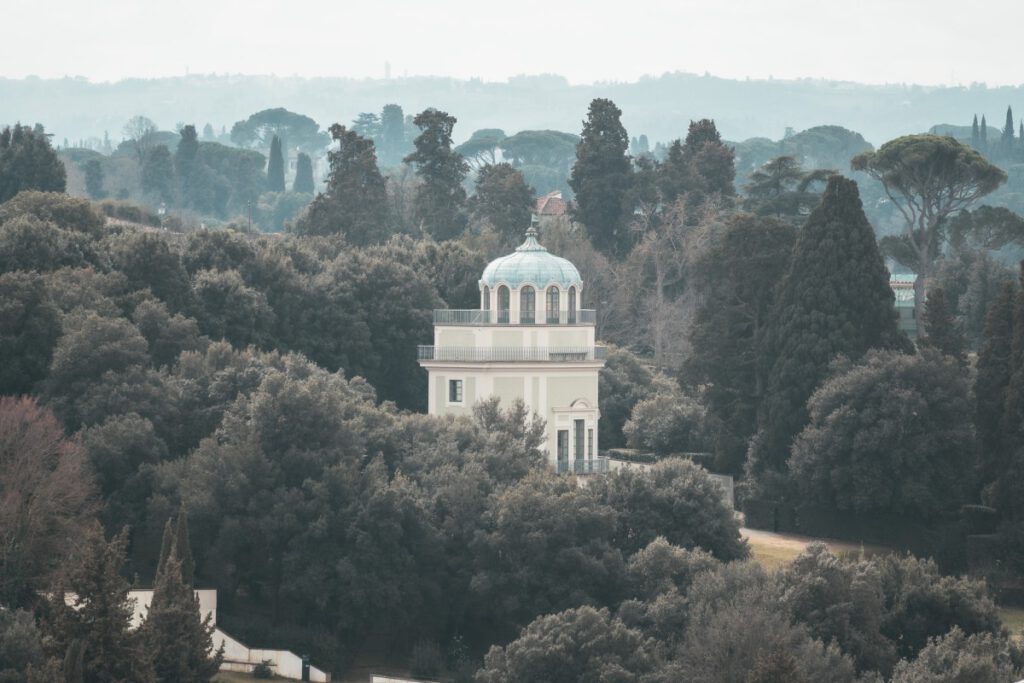
You can find tickets to the Boboli Gardens here:
8. Piazzale Michelangelo
From this square, south of the historic center, you can experience one of the most beautiful sunsets in Florence, when the evening sun gently caresses the facades of the city and slowly lulls you to sleep.
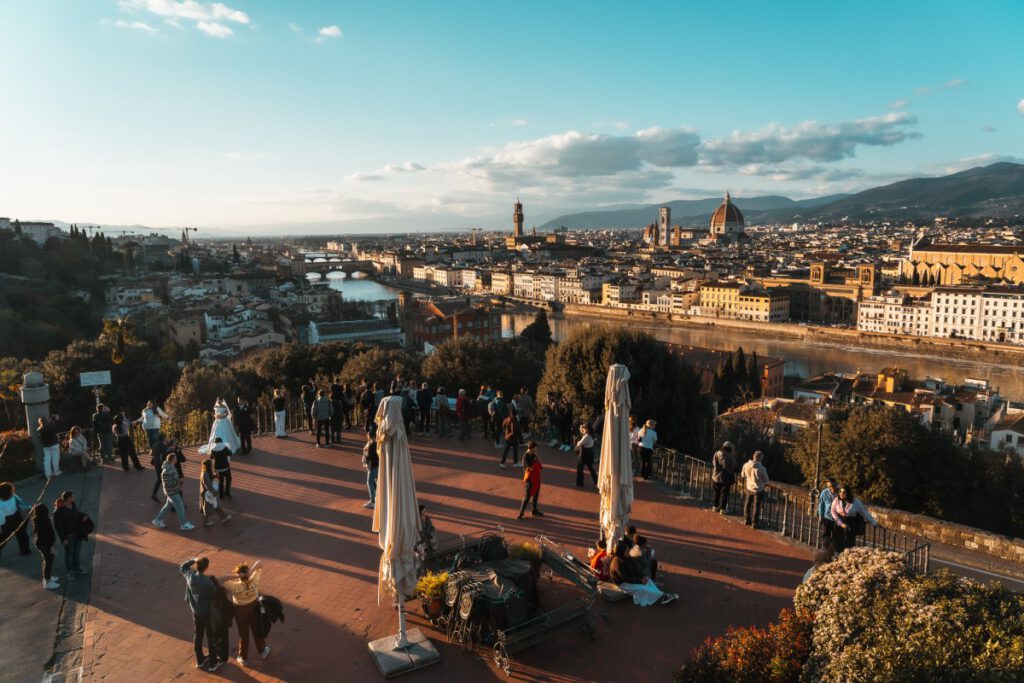
Piazzale Michelangelo is dedicated to the Renaissance artist Michelangelo. You can find bronze copies of some of his marble works here, including the David and the four Allegories of the Times of Day from the Medici Chapel of San Lorenzo. There are also several souvenir stores and snack bars on site. You can also buy drinks in the Panorama Bar and enjoy your sundowner on the chairs in front of the bar.
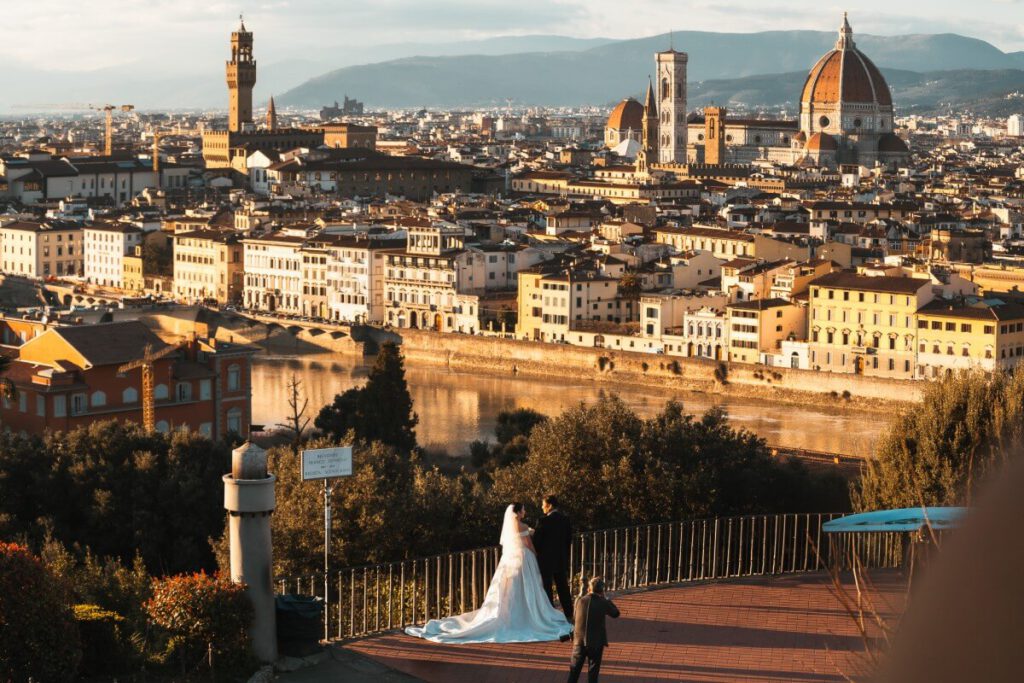
It’s best to be there about an hour before sunset to catch one of the best spots for photos and selfies. There is always a lot going on here when the weather is nice.
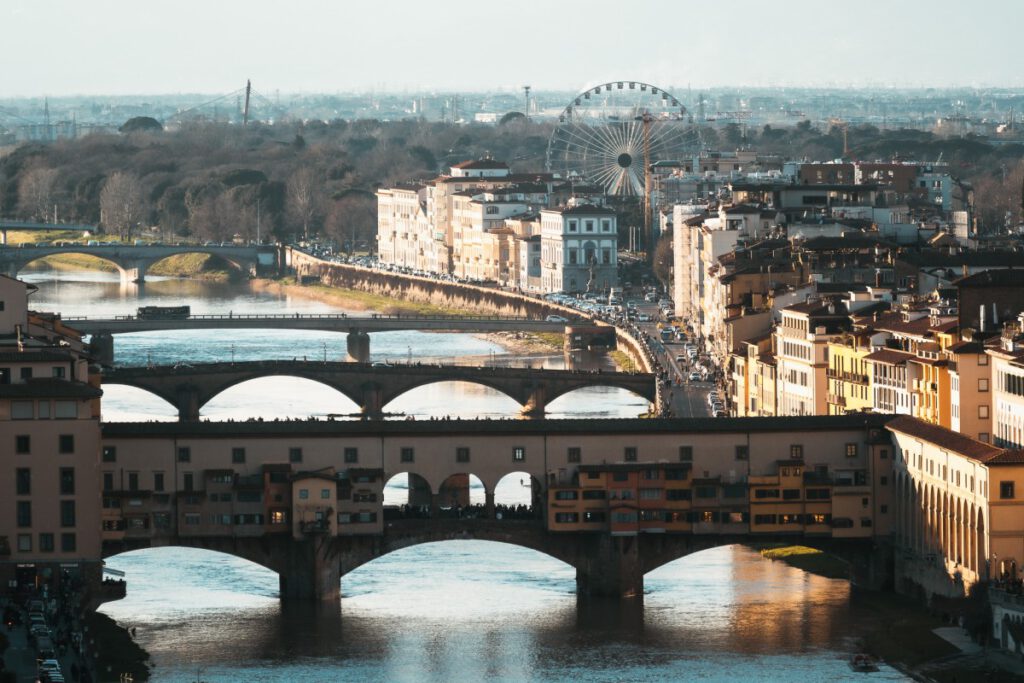
You can reach the square quite easily on foot. From the Ponte a le Grazie it is about 20 minutes uphill. However, there is also a bus that goes directly to the large parking lot in front of the viewpoint:
- The stop is called Stop n.14 “Piazzale Il David”.
- From Boboli Gardens, for example, you can get to this wonderful viewpoint in just 10 minutes by bus.
- Line 12 runs directly from Porta Romana to the view.
- You can buy tickets on the bus using contactless payment by scanning your debit or credit card.
- If you are checked, your card number will be checked in the machine on the bus.
- The money is usually only debited from your account later.
- A ticket is valid for 90 minutes no matter where you get on and off.
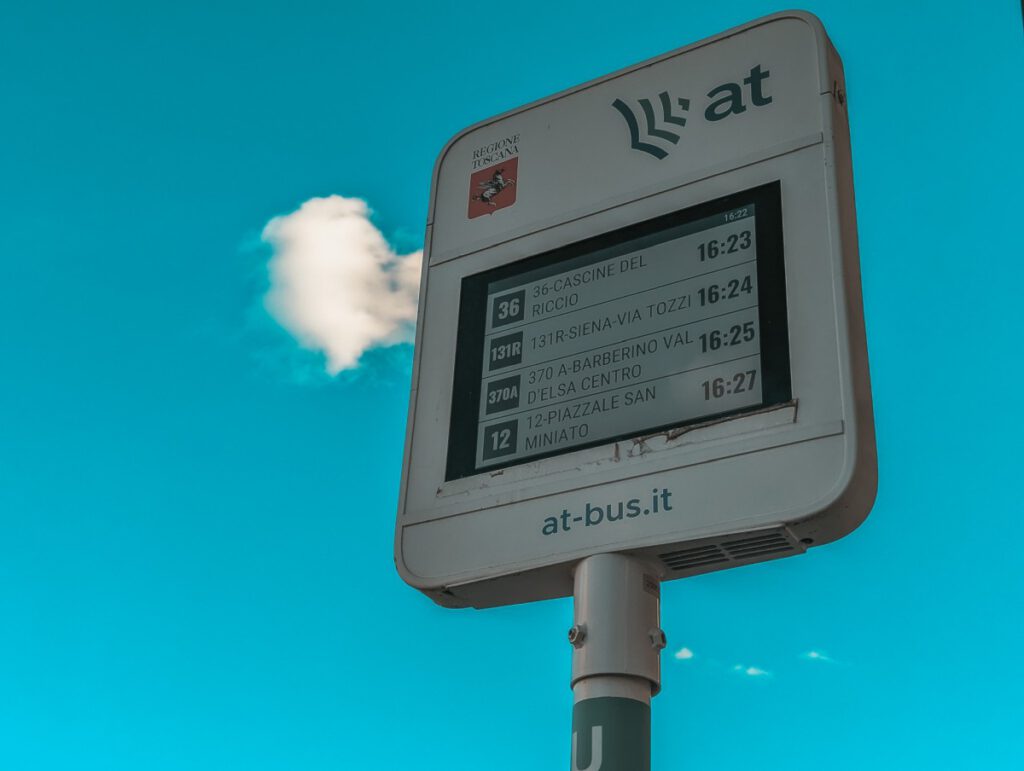
9. Palazzo Vecchio
The Palazzo Vecchio in Florence is a medieval symbol of power and one of the city’s most important Renaissance buildings. It houses a museum and the tower that can be seen from afar.
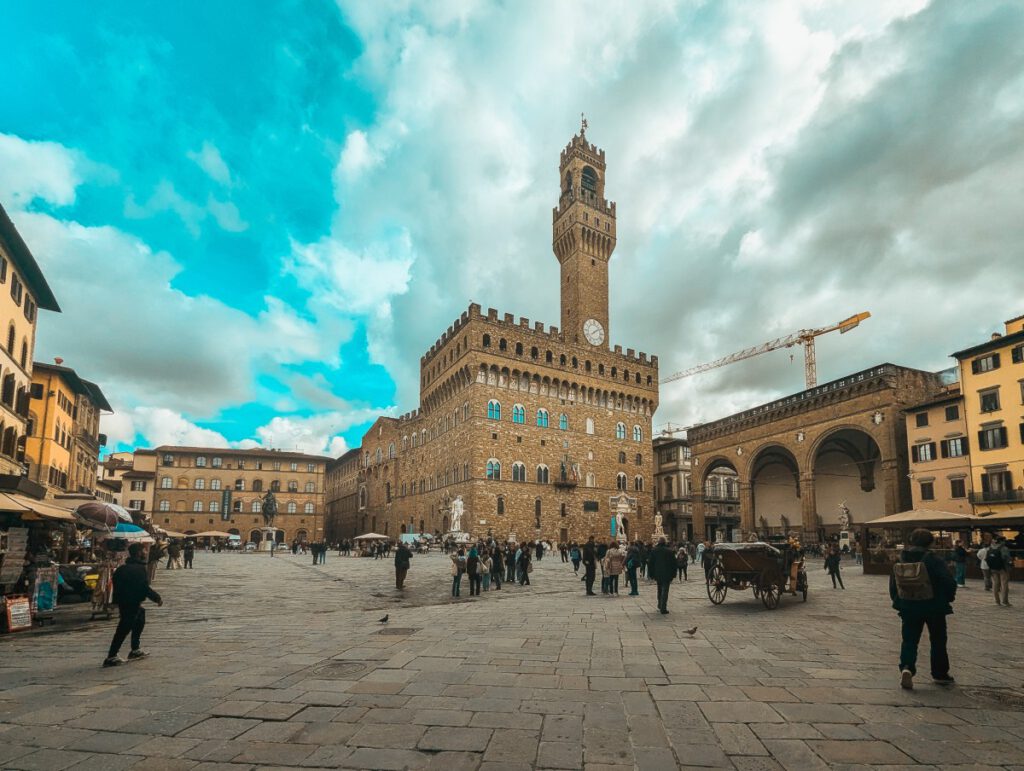
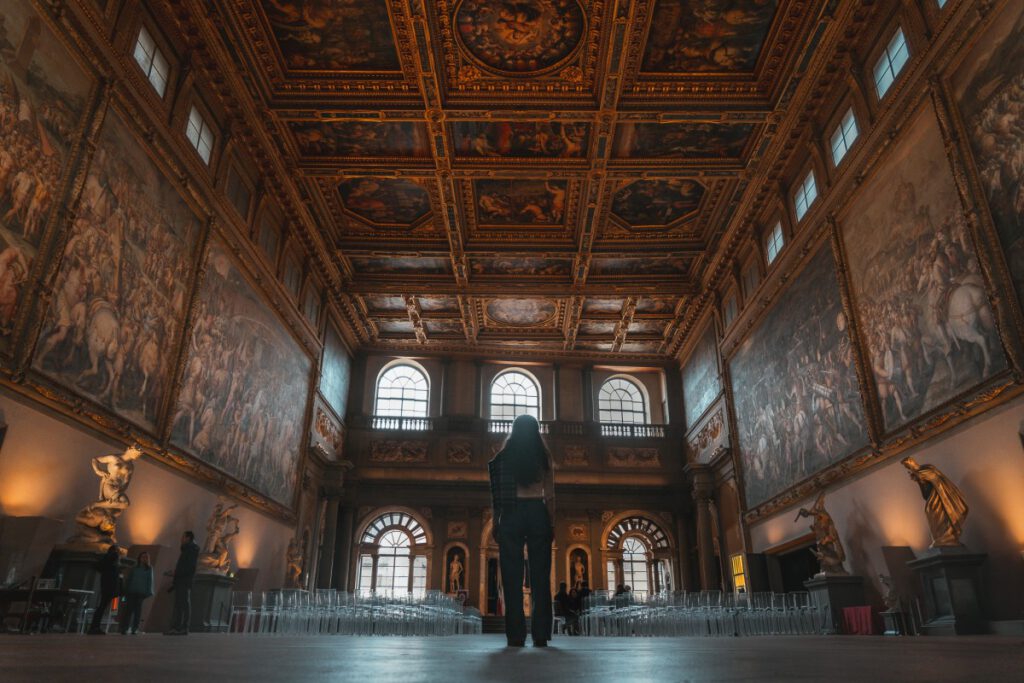
A highlight of the museum is the magnificent Council Chamber with frescoes by Vasari and Michelangelo’s “Victory”. You can also see some of the Medici family rooms here, all of which have rather grandiose paintings on the walls.

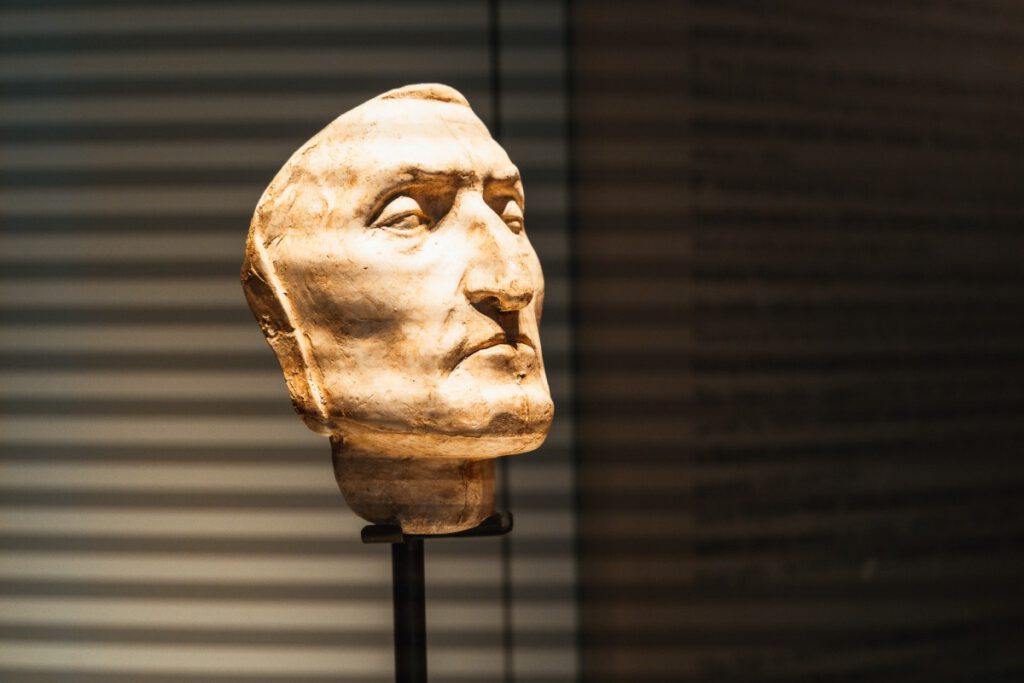
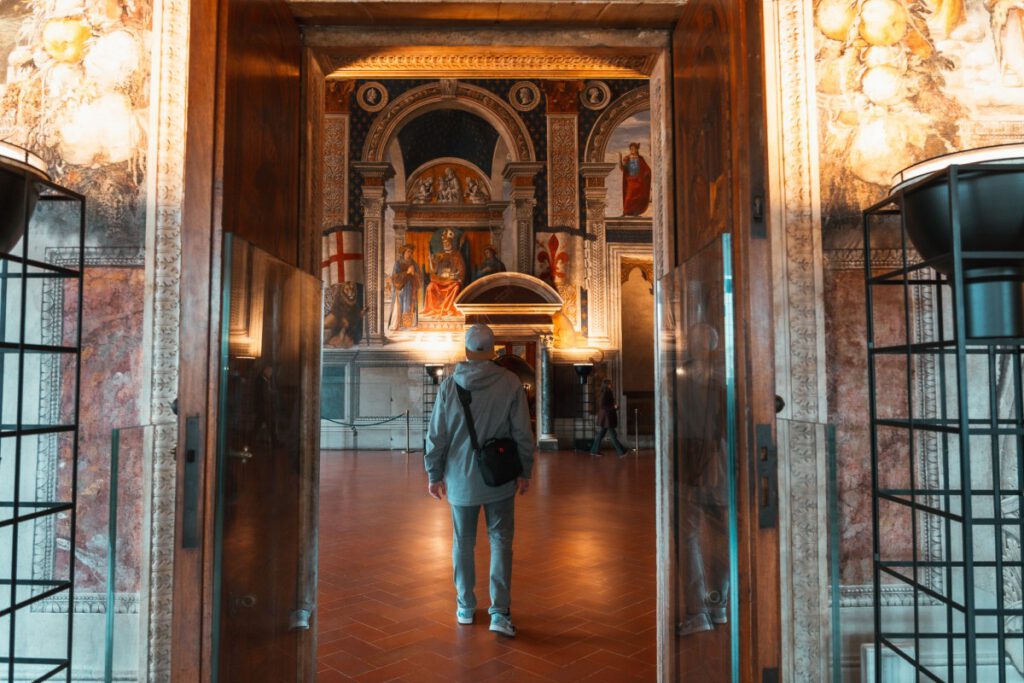
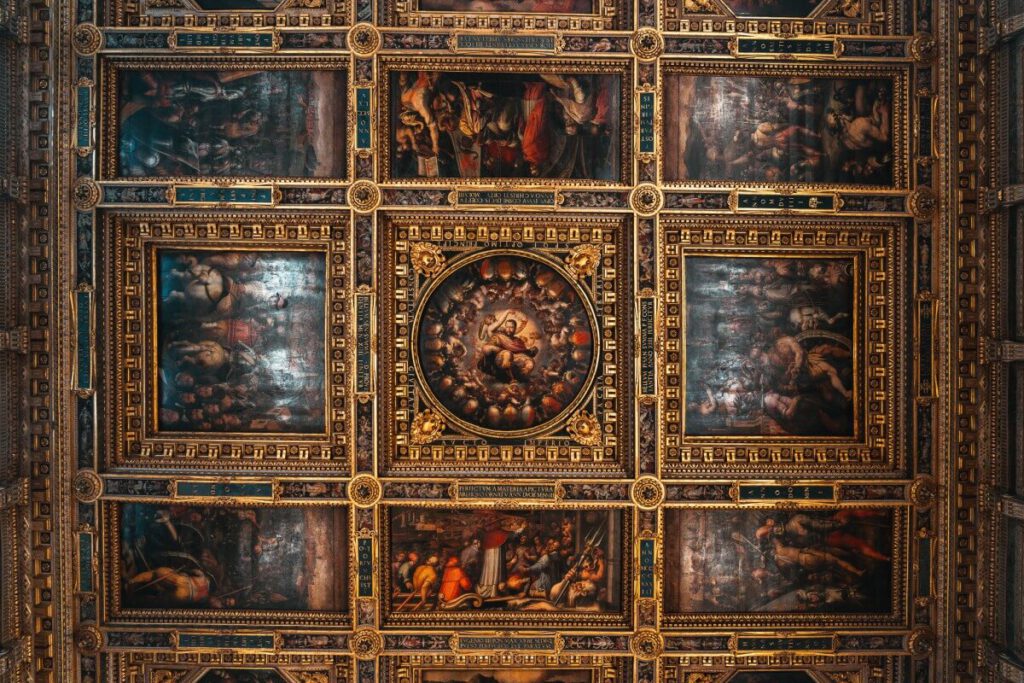
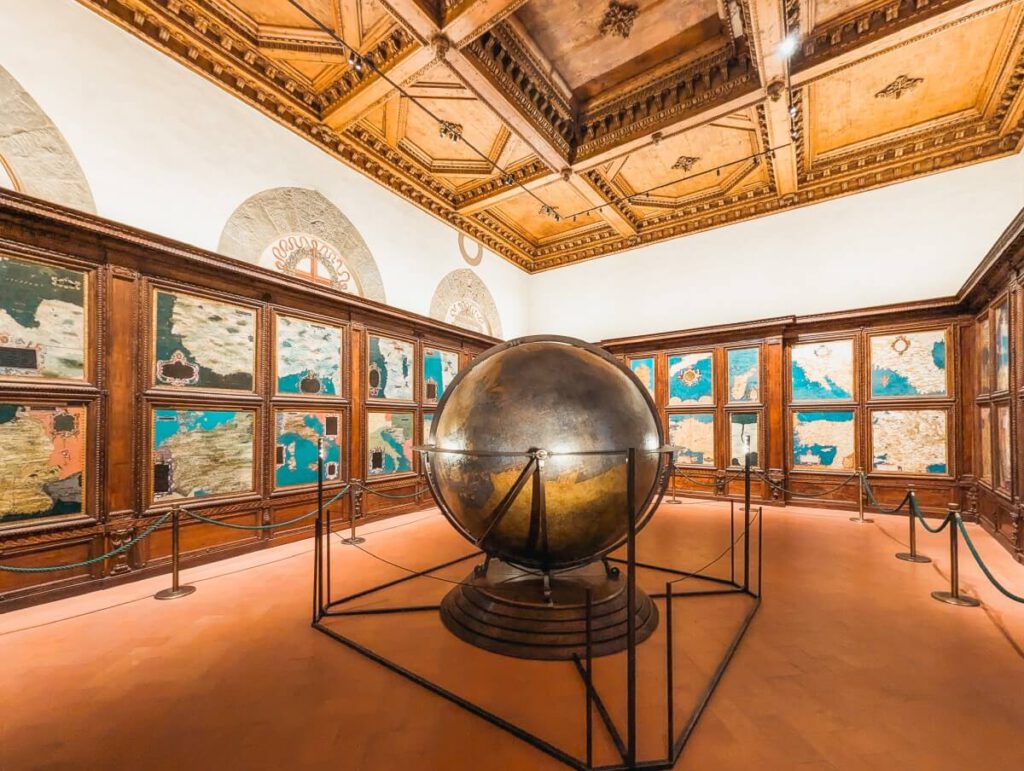
The small Studiolo room of Francesco I de’ Medici is somewhat inconspicuous and easily overlooked in a rear corner of the great hall. It is a windowless study and retreat that Francesco I used for meditation and to contemplate his treasures. From there, he could observe the meetings and gatherings in the adjoining great hall through a peephole. The Studiolo is richly decorated with paintings, stucco work and sculptures and is considered a jewel of Mannerist art.
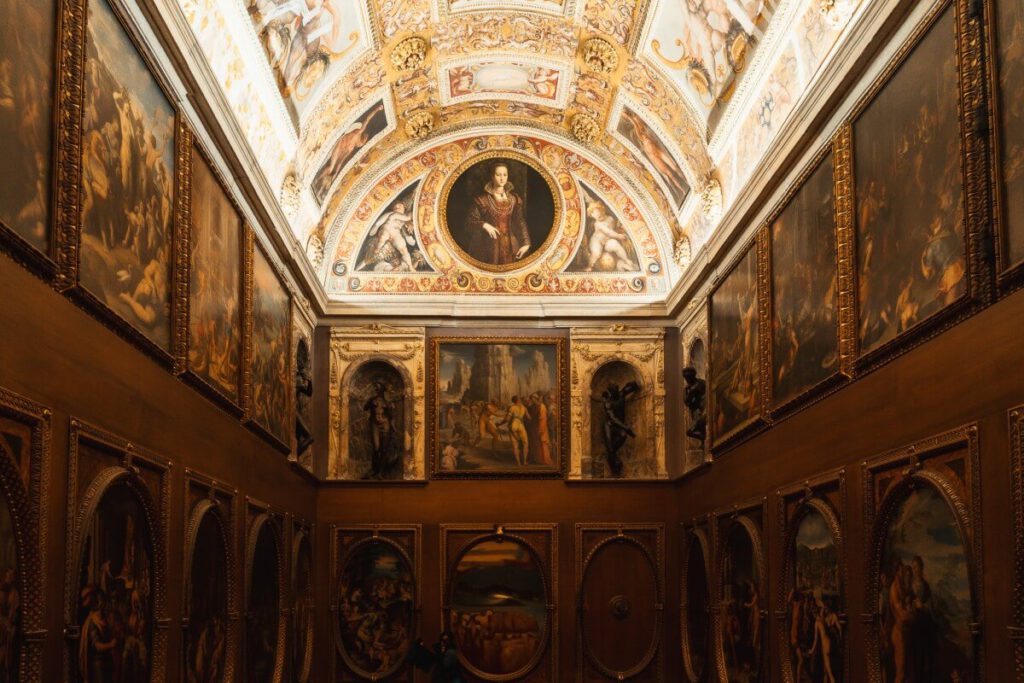
You can enter and view the inner courtyard of the palace free of charge. However, it is also worth paying for admission to the museum and the ascent to the tower. There are separate tickets for both. You will need around 1 to 1.5 hours for the museum and the exhibition. About 30 minutes to 1 hour for the tower. It is best to book your visit to the tower directly after the museum. The ascent to the tower starts directly from the last room of the museum.
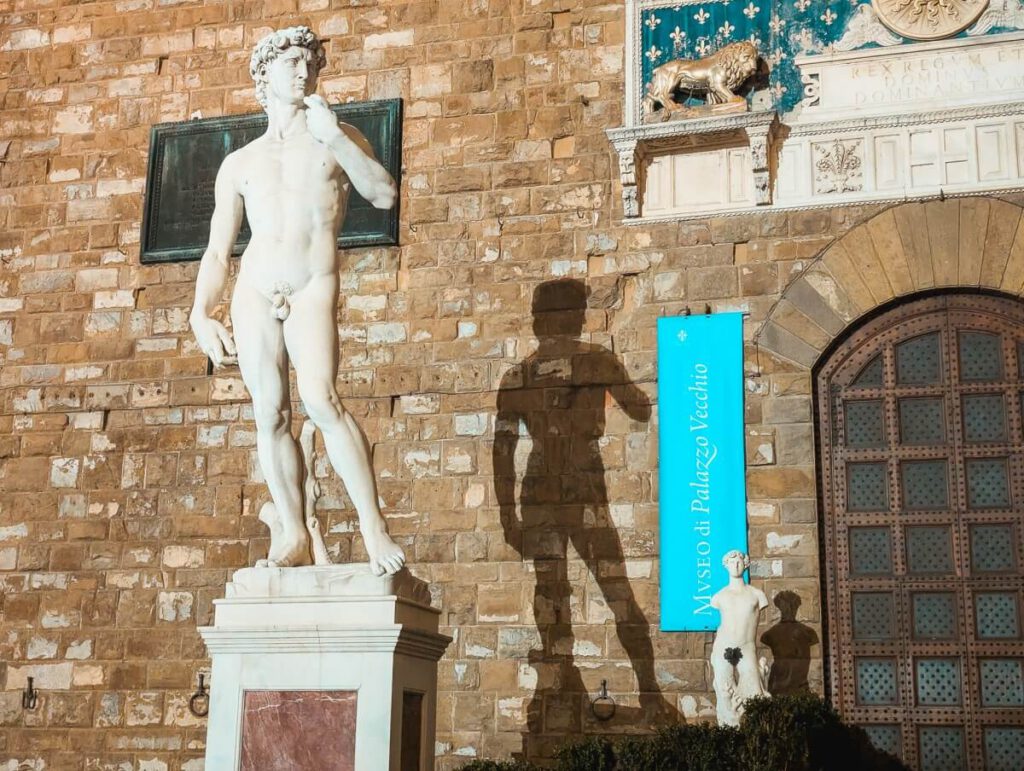
Another good idea is the Secret Access Tour through the palace, where you can discover the Medici family’s secret rooms with a tour guide and see some particularly interesting places in the palace that are otherwise not open to the public.
You can find tickets to Palazzo Vecchio here:
10. Ponte Veggio
The Ponte Veggio is the oldest bridge over the River Arno in Florence. It was completed in 1345 and originally housed butchers and tanners. In the 16th century, these were replaced by jewellers, who still dominate the bridge today with their numerous stores. So if you are looking for Italian jewelry, then Ponte Veggio is definitely the right place for you.
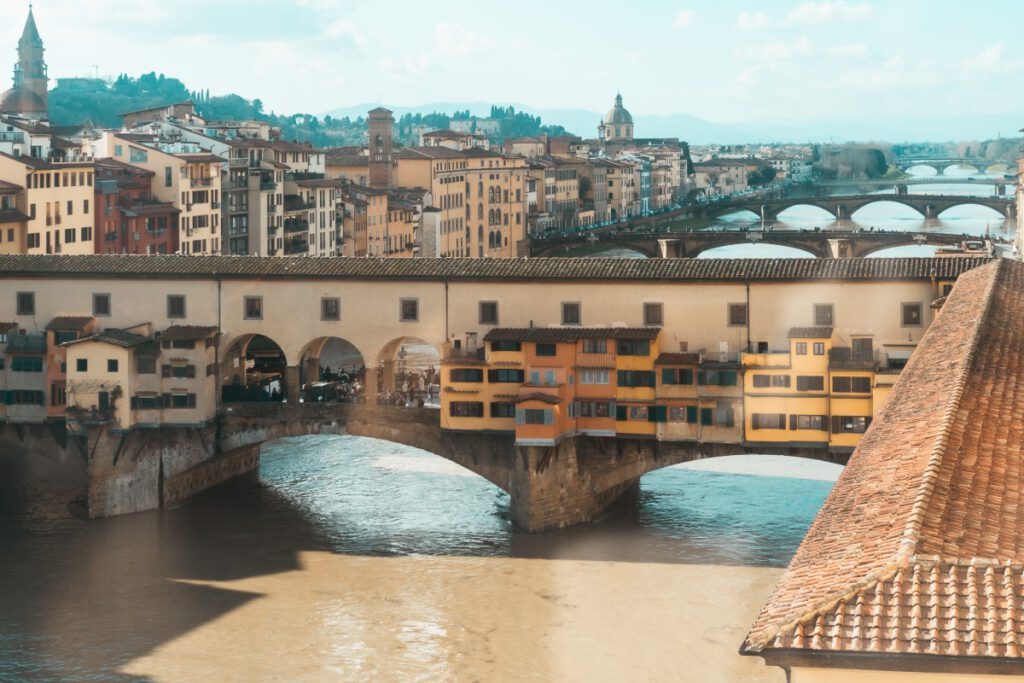
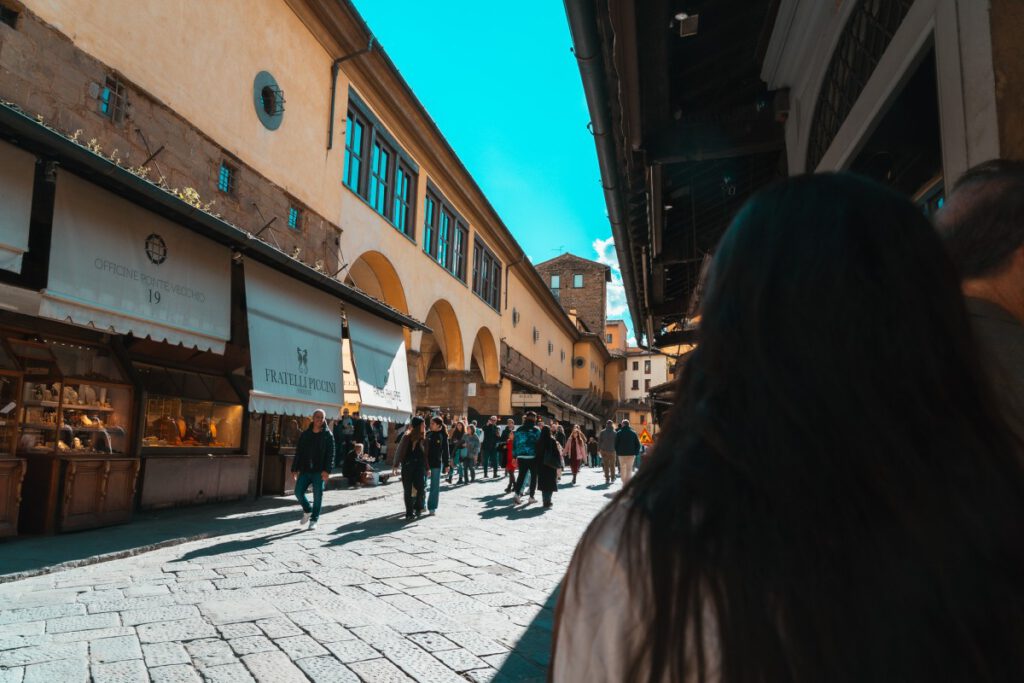
Above the stores, the secret Medici corridor (also known as the Vasari corridor) runs from the Uffizi to the Palazzo Pitti.
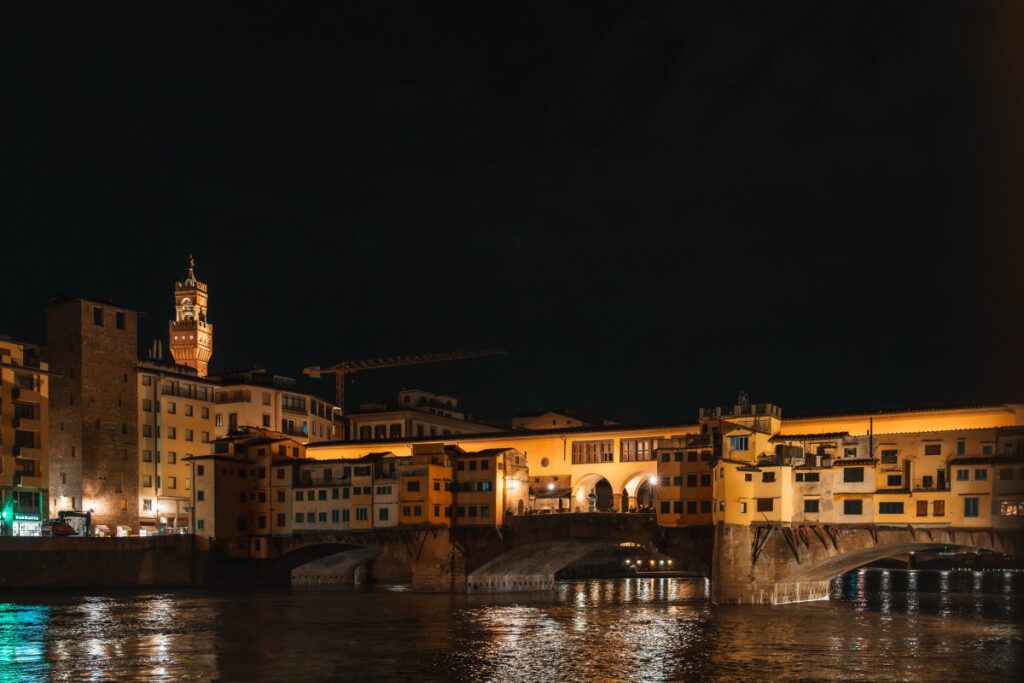
You can find tickets for the Vasari Corridor here:
11. Villa Bardini and Bardini Garden
A little away from the crowds on the other side of the River Arno, you can soak up some peace and quiet in the Bardini Gardens. Even in February, it already smells wonderfully of spring here. The highlights here are the Baroque staircase and the terrace, from which you have a wonderful view. In spring, the pergola covered with pink wisteria is also something special. These usually bloom from April to mid-May.
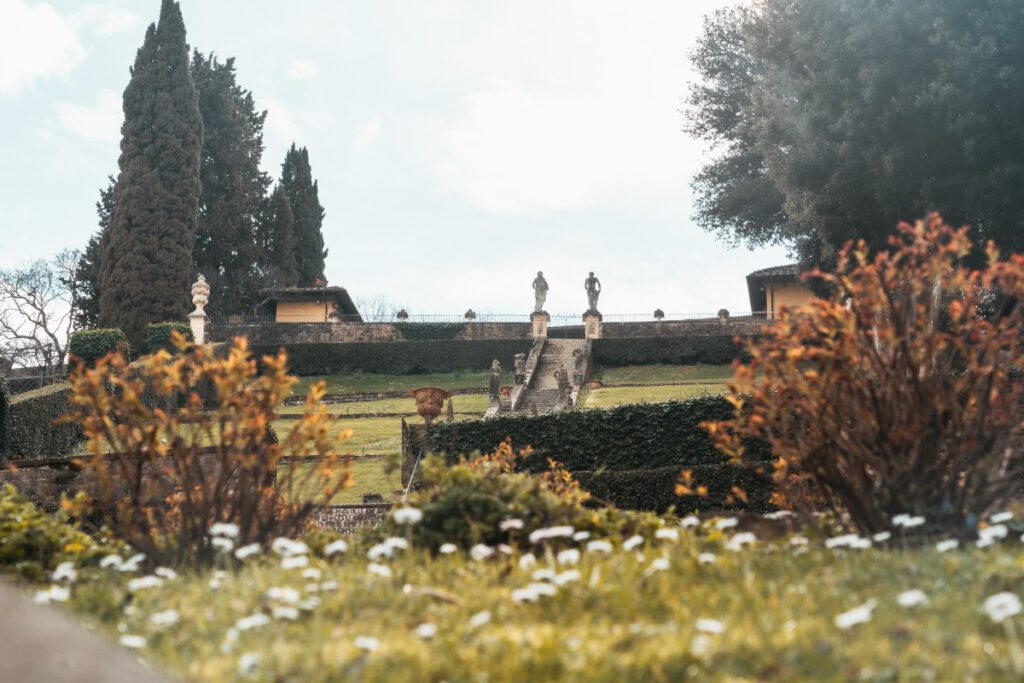
The park is quite small. You can see everything in less than an hour. Tickets cost €10, but this also includes entry to the larger Boboli Gardens, which you can visit directly afterwards – perfect for a sunny day.
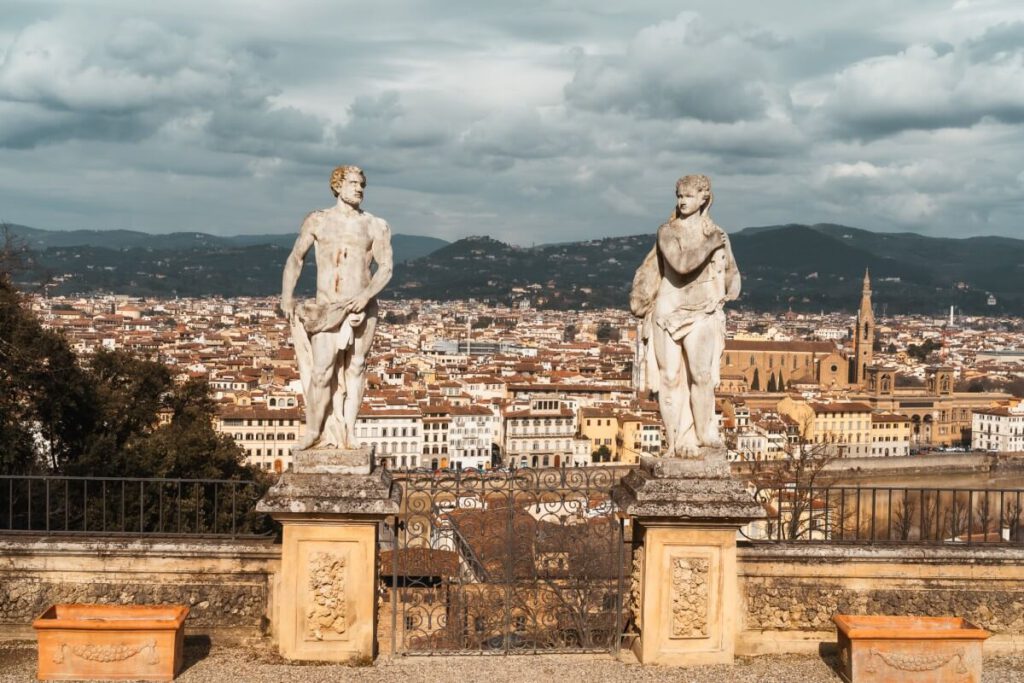
You can find tickets for the Bardini Garden here:
- You can buy tickets on site at the entrances to the garden for €10. What many people don’t know: The ticket is valid for the whole day and not just for the Bardini Gardens, but also for the Boboli Gardens.
12. Leonardo da Vinci interactive museum
In this interactive museum, you will discover many replicas of Leonardo da Vinci’s drawings. Not only can you read a lot about his inventions here, you can also touch and try them out. This is an exciting change of pace, especially for children.
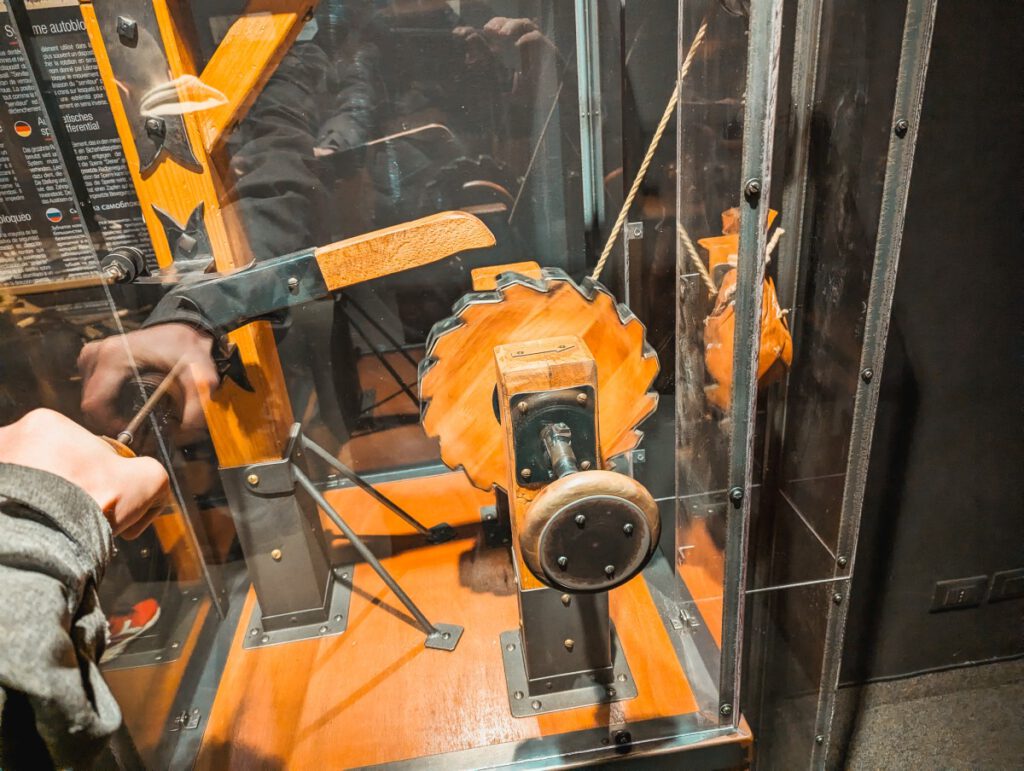
Included, of course, is the propeller, one of the first ball bearings, an iron crossbow, a rotary oscillator, a diving suit and much more. If you take a look at some of the machines, you can also better understand how huge buildings like the cathedral could have been built over 300 years ago.
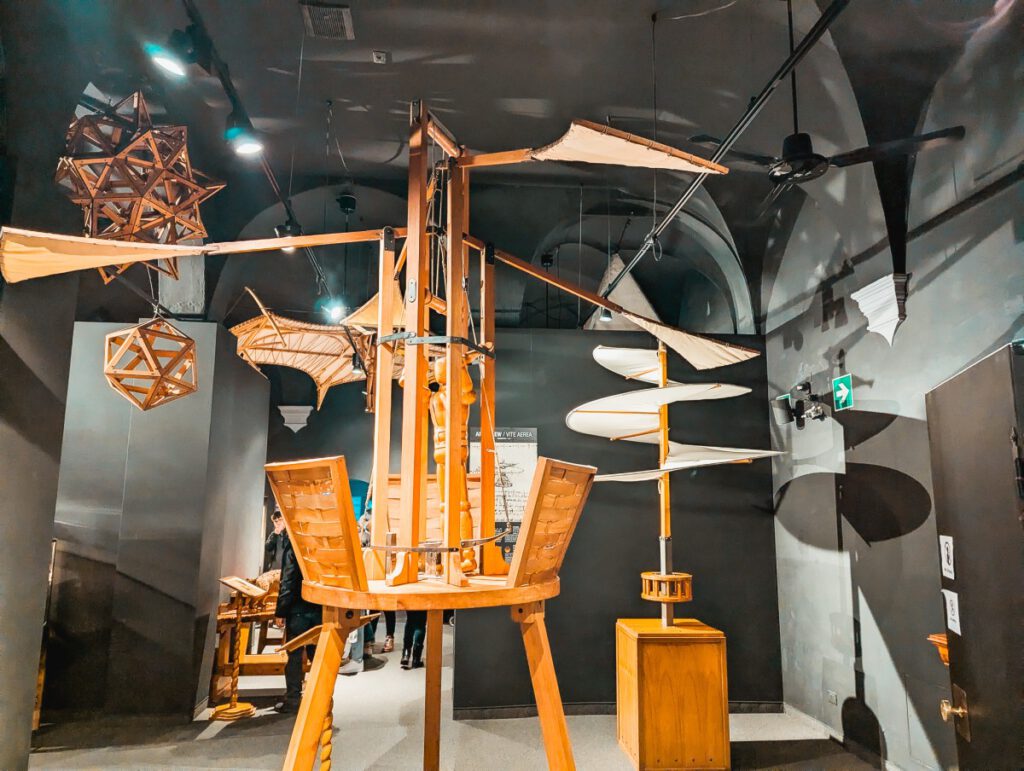
Admission to the museum costs €10 and you need about an hour to see and taste everything.
You can find tickets to the Leonardo da Vinci interactive museum here:
- Tickets from the official ticket store (are usually cheaper)
- Skip the Line Ticket
13. Museo di San Marco
The Museo di San Marco in Florence is located in a former Dominican monastery, which is now a museum housing the world’s largest collection of works by Fra Angelico. As you walk through the former cells and refectories, you will feel like you have been transported back to the time of the Dominican monks.
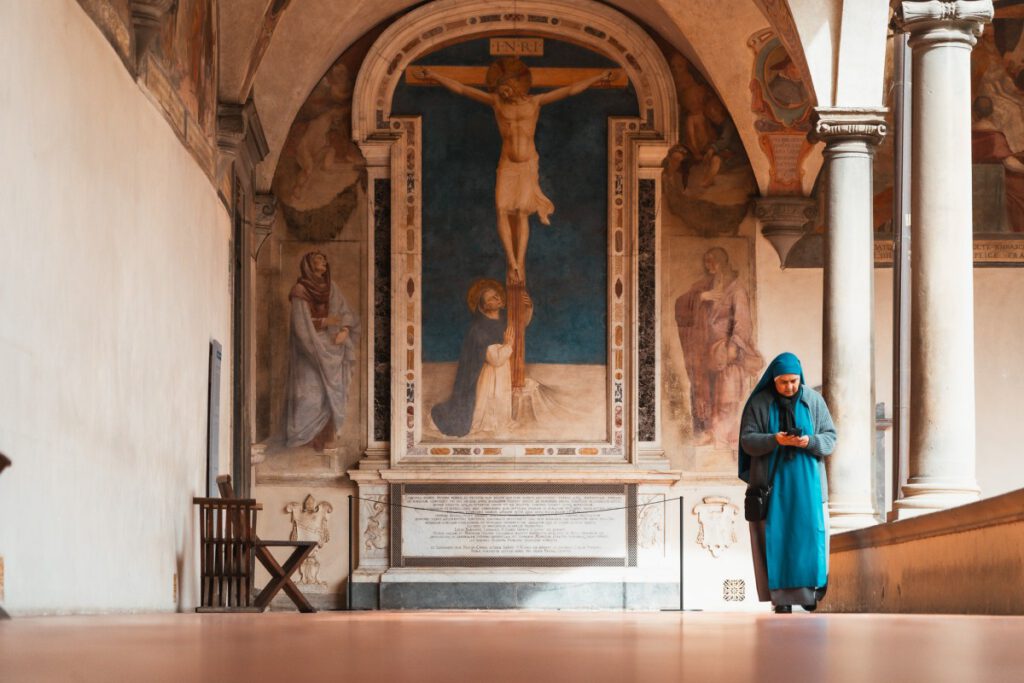
However, I was most impressed by the many frescoes in the cloister of the monastery, as well as the spatial mural “Last Supper” by Ghirlandaio.
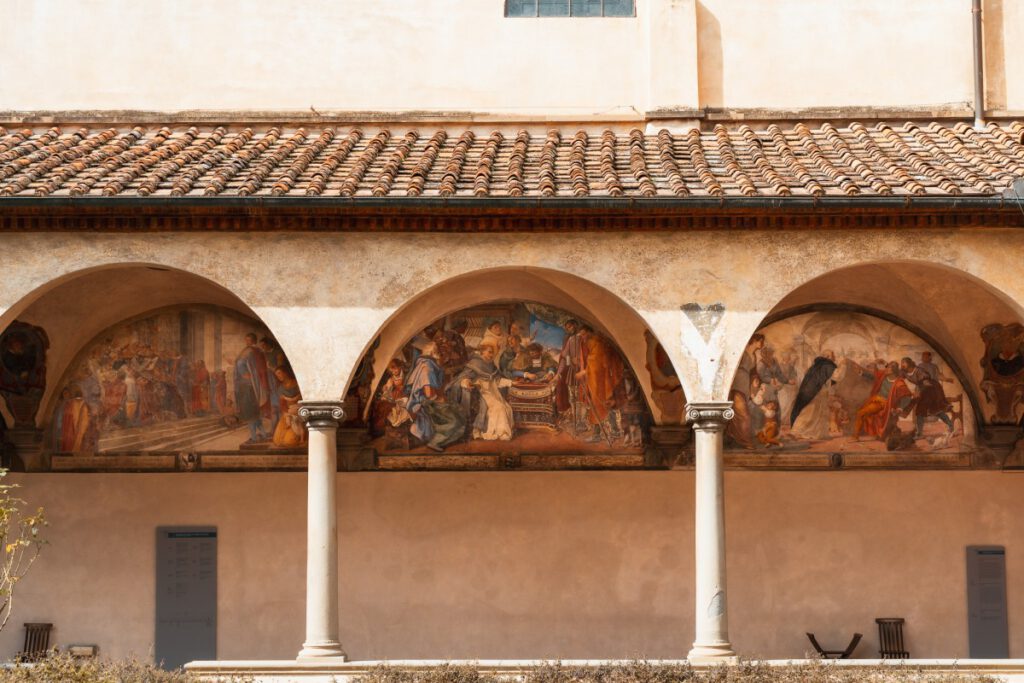
What’s also particularly cool is that it’s not as busy as the other museums and you can enjoy some peace and quiet. The Museo di San Marco is therefore a little insider tip for Florence and a great alternative if you can’t get a ticket for one of the other museums or simply have time left over to see something else.
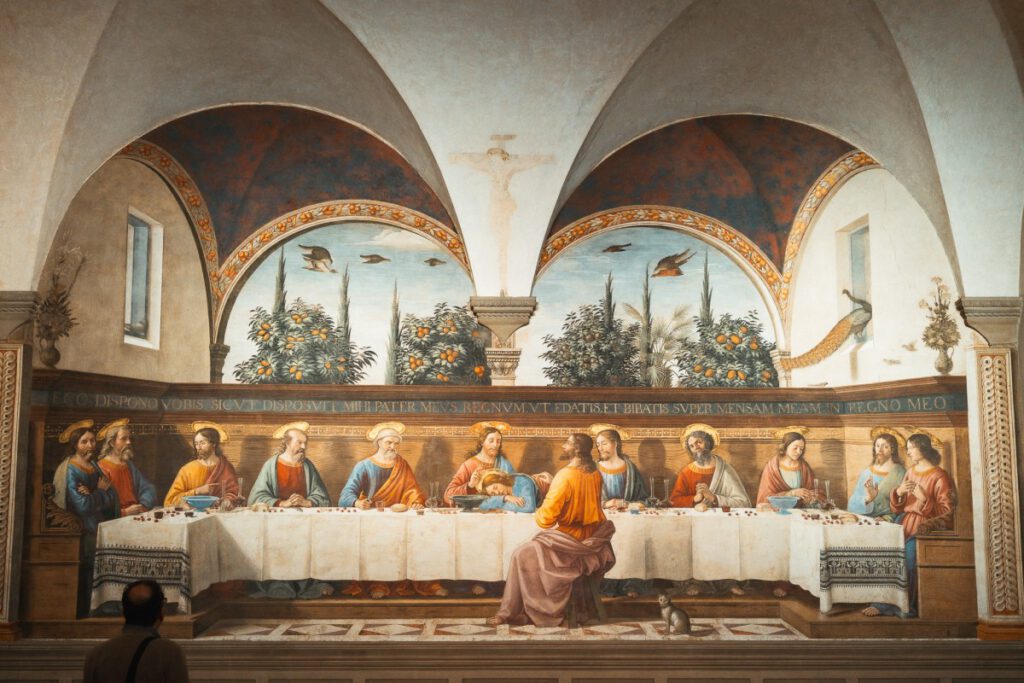
You can find tickets to the Museo di San Marco here:
14. CLET Gallery
CLET is actually a French street artist, but he has been living in Florence for many years and in a way has also shaped the cityscape a little. He has covered street signs all over Florence with his motifs. If you walk through the alleyways of the old town or through the San Niccolò district and pay attention, you are sure to spot a few.
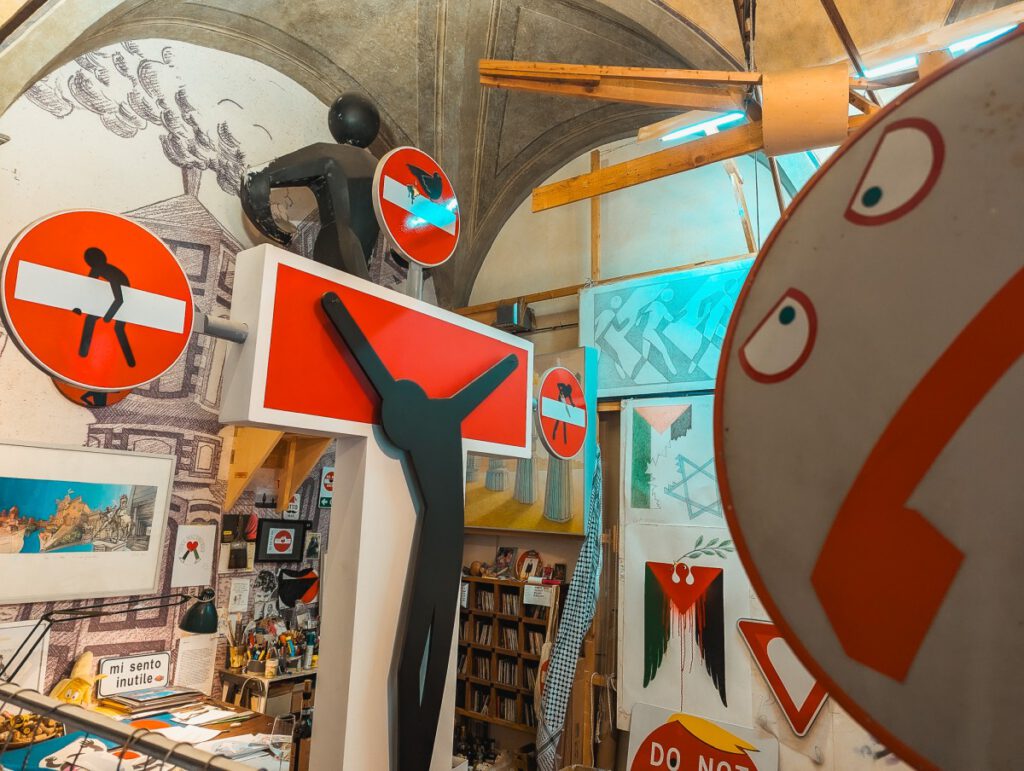
You can also visit CLET’s studio in San Niccolò. In addition to stickers, there are also various other products with his motifs to buy or simply look at.
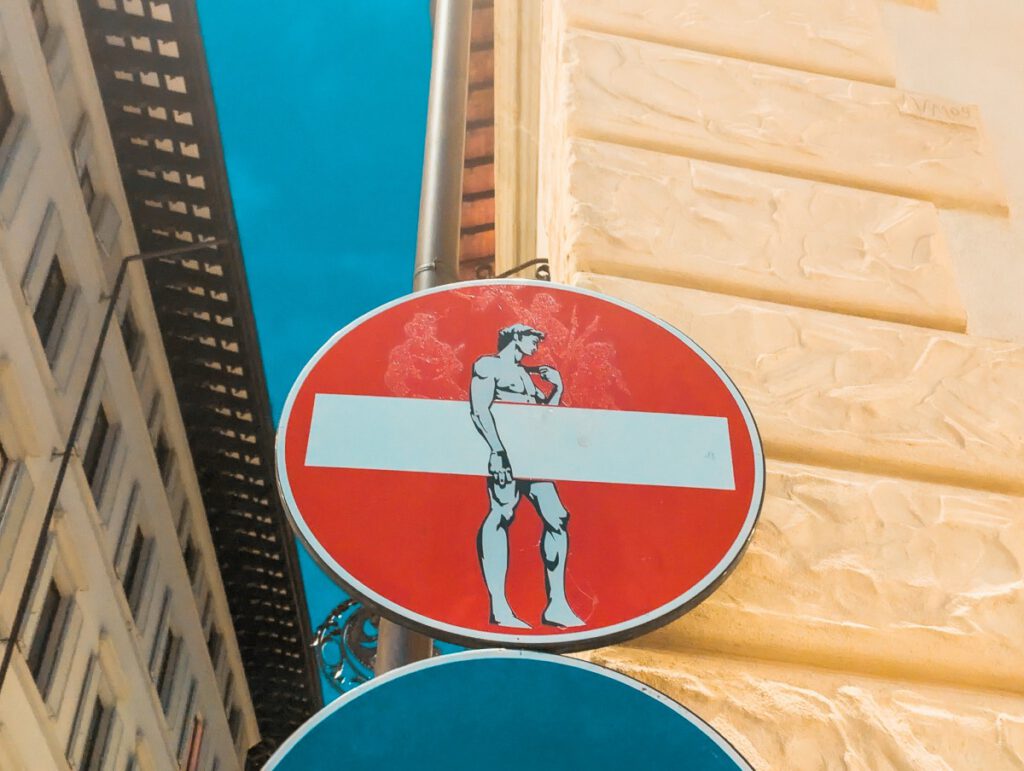
Culinary Florence sights
The Retrobotteca is a small restaurant serving local dishes, including delicious schiacciate (a type of flatbread), buns and cicchetti (small snacks). You can sit down in the restaurant at your leisure or have a schiacciate handed to you.
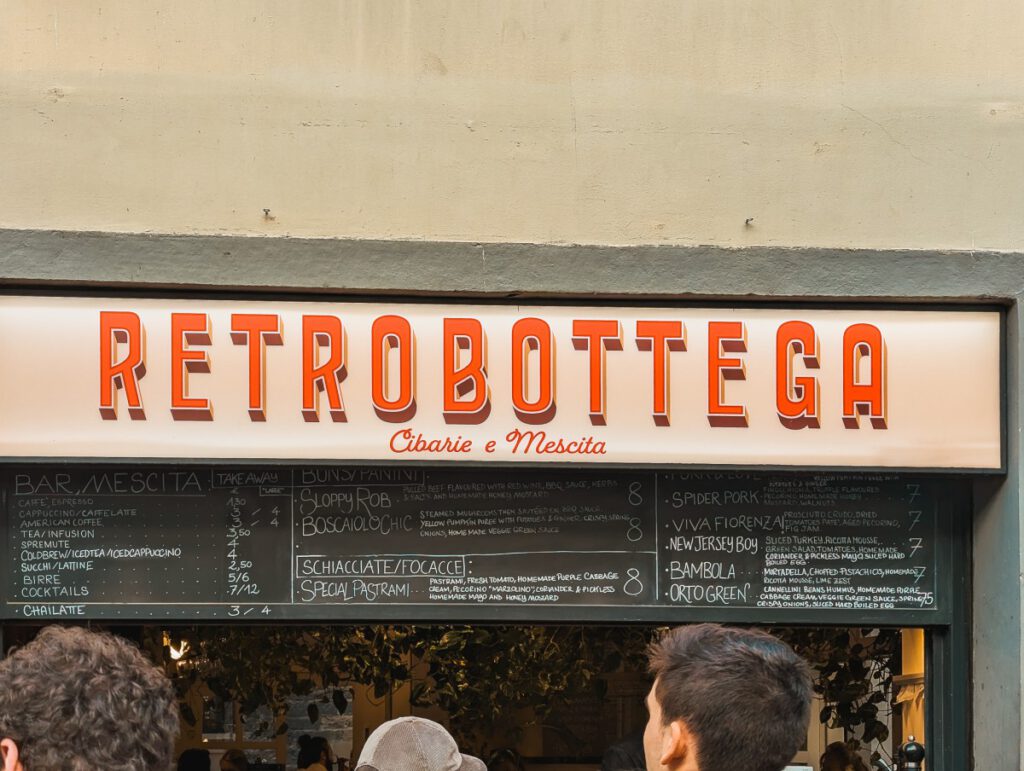
The sandwiches at All’Antico Vinaio are extremely popular with Italians and tourists alike. This is the only way I can explain the long queues in front of these sandwich stores. They serve handmade sandwiches with fresh focaccia bread and a variety of local ingredients such as Tuscan salami, prosciutto, burrata, truffle cream, cheese and vegetables. There are several stores in the city center and also one at the train station.
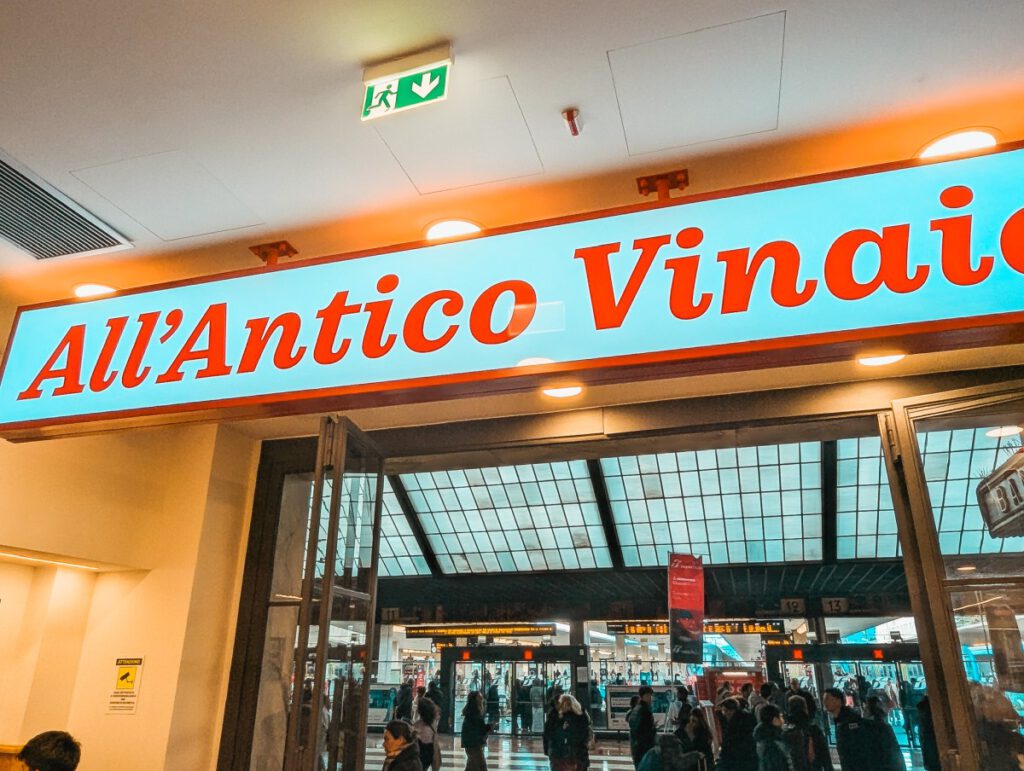
Another famous feature of Florence are the small wine windows(buchette del vino in Italian). These are small, arched openings in the thick stone walls of palazzi and houses in Florence that were created in the 16th and 17th centuries. They were originally used to sell wine without customers having to enter the house. There are said to still be 100 such windows in Florence today, but only some of them are still in active use. For wine lovers, there are also tours along these windows. Take a look here:
- Wine window walk with wine tasting and appetizers (duration: 2.5 hours)
- Wine window experience & Tuscan charcuterie (45 minutes)
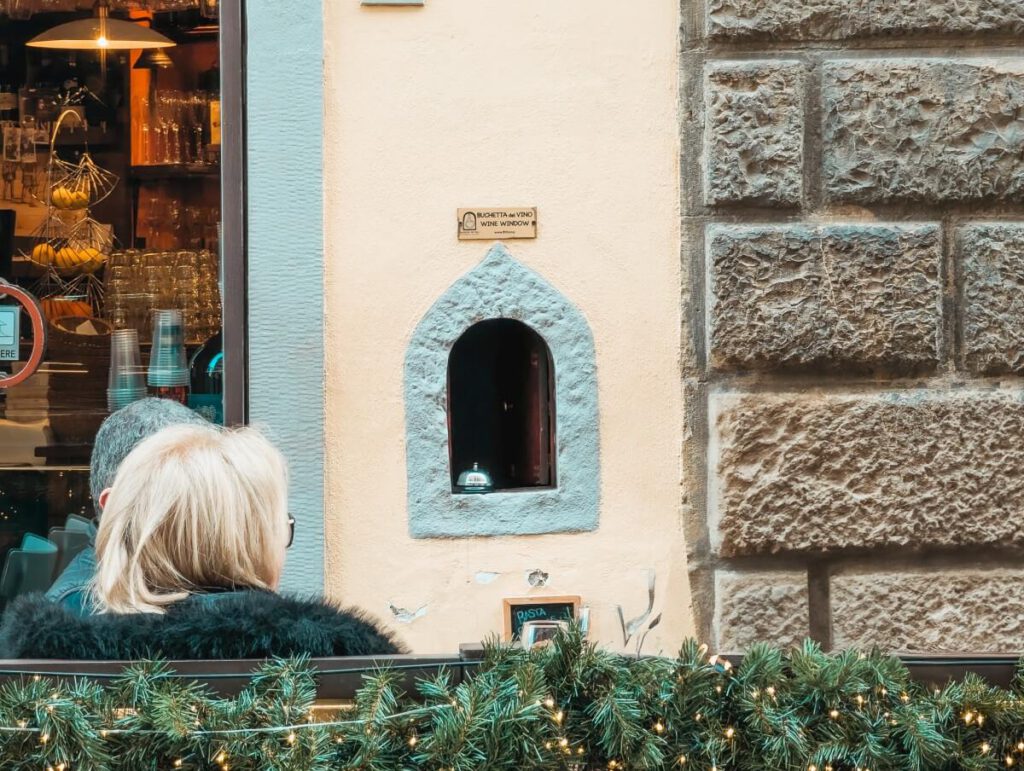
Florence also has a few cool cocktail bars. My favorites were the Santa Cocktail Club with a view of the Basilica Santa Maria Novella and the COMPANION “dolce amaro bar”, which is part of the 25hours Hotel.

The Gelateria dei Neri is the favorite ice cream parlor of many Florentines. There is a great selection of different flavors here. The best thing is that you don’t pay by the scoop, but by the cup and can combine as many flavors as you like.
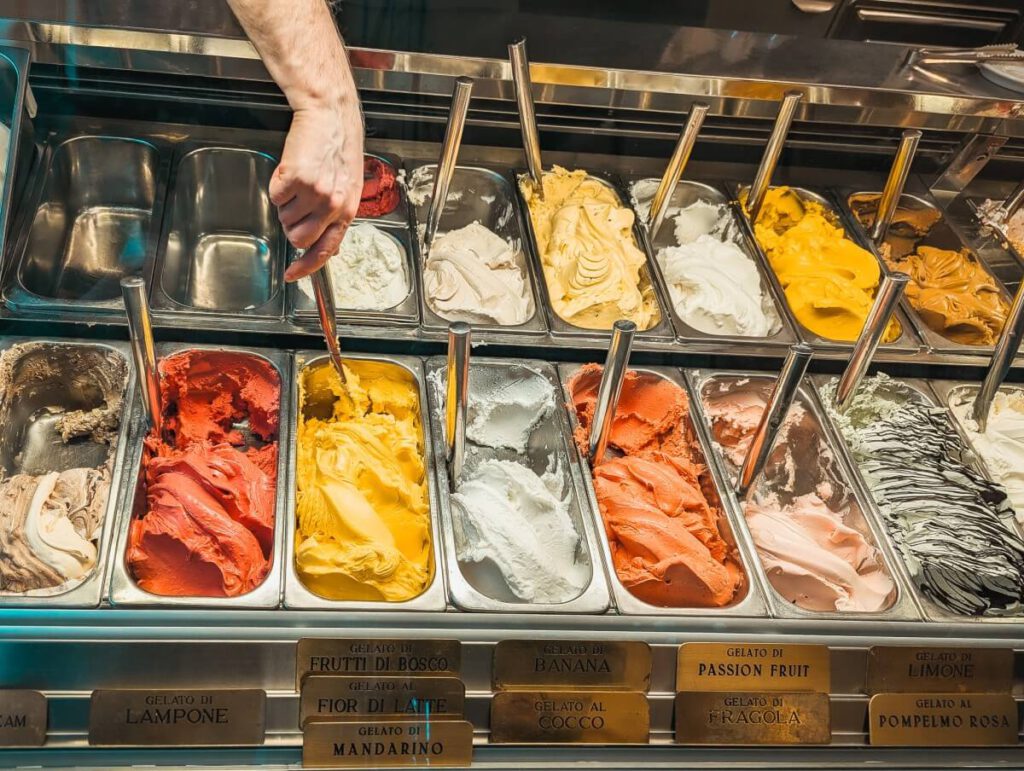
As you can see, Florence offers a lot for its size. Which of the Florence sights are your favorites? Is there anything else that absolutely has to be on this list? Feel free to write me a comment
Tools & services I recommend for your trip:*
📶 Flexible and affordable mobile Internet worldwide
🚁 My drone for aerial photography
🚗 Find and compare cheap rental cars
🎟 Find and book cool activities
🔒 Secure Internet connection with NordVPN
*Note: These links are affiliate links. If you book through them, I will receive a small commission without it being more expensive for you. A purchase from you via these links helps me to continue offering free content without annoying ads on this website. Thank you for your support! I really appreciate it!

